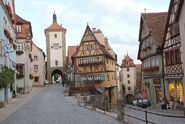| Aquitania Aquitanian Empire Aquitanisches Reich Aquitáinise Réimse | |
| Motto: Freiheit - Vereinigung - Reich "Freedom - Union - Empire" | |
| Anthem: Phönix "Phoenix" | |
| Geography | |
| - World | White Giant |
| - Continent | Auriga Bella |
| - Region | Great Palms |
| - Capital | Weißhaupt |
| - Largest city | Savoy |
| Official languages | Aquitanian Oirthir |
| Ethnic groups | 65% Aquitanian |
| 27% Oirthir | |
| 8% Ardglassian | |
| Religion | Luxesscept |
| Demonym | Aquitanian |
| Government | Federal Parliamentary Monarchy |
| - Kaiser | Wilhelm XV |
| - Reichskanzler | Johanna Jäger |
| Legislature | Reichsversammlung |
| - Upper house | Dyranttag |
| - Lower house | Bundeskongress |
| Events | |
| - Formation | 402CE |
| - 1st Empire | 1507-2467 |
| - 1st Schism | 2467-2804 |
| - 2nd Empire | 2804-2904 |
| - 2nd Schism | 2892-2914 |
| - Prussian Era | 2914-2950 |
| - 2nd Kingdom | 2950-3030 |
| - 3rd Empire | 3030-3375 |
| - Blight | 3375-3415 |
| - Reclamation Era | 3415-Present |
| Population | |
| - Total | 84,967,522 Statistisches Reichsamt |
| Military | |
| - Active personnel | 66,000 Wehrmacht |
| Organizations | |
| - Federation | United Countries |
| - Common Market | The Union CM |
| - Empire | Aquitanian Empire |
| Production | |
| - Total | SC$4.144 trillion |
| - Per capita | SC$49,289 |
| Currency | New Aquitanian Mark ₰ |
| Internet TLD | .aq |
| Drives on the | right |
| URL | Aquitania in Simcountry. |
Aquitania (Aquitanian: Aquitanien)(Oirthir: Aquitainé), officially the Aquitanian Empire (Aquitanian: Aquitanisches Reich or Aquitanisches Kaiserreich)(Oirthir: Aquitáinise Réimse), is a country in the Great Palms region of Auriga Bella. It mainly encompasses the territories of Weißland, Sawoie, Preußen and Ludonnien, an area known as the Western and Southern Mainlands.
At the third empire's (3030-3400) greatest extent, Aquitania was the largest country in Great Palms and the second largest in Auriga. With a total population of around 142 million people, it was the second most populous Aurigan country. The country's government was an absolute parliamentary imperial monarchy with its capital in Königsberg, the nation's third largest city. The country was preceded by the Aquitanii Imperium, which was for a time the most advanced ancient civilisation of the world until its collapse in the year 1CE. The country had been a major economic power since the early 1400's and a major military power until 1925, reaching its height in the late 19th and early 20th centuries. Aquitania produced many influential scientists, thinkers and artists, and remained a leading and distinguished global centre of industry and culture up to its fall. At its height, the country drew an approximate 85 million tourists per year, one of the highest numbers in White Giant.
The last Reichskanzler (Imperial Chancellor) was Ailean na Aodhagáin and the Kaiser (Emperor) was Wilhelm IX. The country was divided into three main regions; the Western Mainland, Eastern Mainland and Southern Mainland. And further into 7 more specific regions called Metropolitan Regions (Metropolregionen), the population in each metro region varied, Ausspott was the most densely and highly inhabited of the seven, which were the following; Metropolregion Außpott-Norduberland, Metropolregion Mitte-Ostpreußen, Metropolregion Ostalexandrien, Metropolregion Lunzentrum, Metropolregion Mittereich, Metropolregion Sieländ and Metropolregion Prag.
Aquitanians enjoyed a high standard of living, with the country performing greatly in international rankings of education, healthcare, civil liberties and human development, with an HDI of .983. The country drew heavy criticism from the democratic nations in the world for its Imperial System and the limited Legislative Powers of the Aquitanian Reichsversammlung.
Aquitania was a founding member state of the The Union Federation, and a founding and respected member of the Union Common Market. It was also a founding member of the Council of Centau, hosting the White Giant planetary Headquarters in New Alexandria until 3371.
Etymology
"Aquitania" coma from the ancient name given to the Eastern Mainland tribes in times of old. The peoples and later Kingdom, were located in what is modern day Arkadien, the Arlathian Basin. The civilisation that inhabited the shores of the Bay of Aquitania, were skilled ship builders, which made the ocean a standard asset to their sustenance. It is believed a foreign civilisation referred to the people there as Aquiis, which meant water herders in their language, it later derived into Aquitanii and Aquitania with the ages. The labelled "Aquitanii" later came to dominate the region culturally and economically during the height of the Aquitanii Imperium. The region and the Kingdom succeeding the Sevintrian Occupation (which in itself toppled the Aquitanii Imperium), thereby receiving the name Aquitania eventhough the political entities there were divided until the formation of the Nordlanderbund. The First Kingdom was also called "Aquitania" from 402 to 1307.
History
The country traces its roots to the Aquitanii Empire, the political entity which is seen as a forerunner to modern Aquitania, most customs and cultural heritage originated with the Aquitanii. After the Imperium's collapse, Aquitania repelled the Sevintrian Occupiers after 400 years, the five succeeding kingdoms coexisted peacefully as independent Aquitanian states until Imperial Unification in 1507, an easy task, as the Aquitanian Kingdoms shared the same language, culture and customs. After unification, the young Aquitanian Empire quickly emerged as a great power towards the 20th century, the isolationist foreign policy adopted after the Great 5 Years War in 1928 spared the nation of participating in international affairs and global crises. Isolation allowed Aquitania to thrive in a golden age that propelled it to space before the Great Schism. The most deadly conflict in Aquitanian recorded history, the Great Schism technologically regressed the empire three centuries after an ultrazealot regime emerged in the Holy City of Weissleuchte intending to supress the historically liberal culture of the Aquitanians, the conflict lasted 342 years, rendering many regions of the empire ungovernable and under the control of different factions. Reconstruction after the end of the war in the newly proclaimed Second Aquitanian Empire was slow, but later gained speed, emerging as an economic giant by the end of the 29th century. At the start of the 30th century the country became engulfed in a civil war known as the Second Great Schism, which saw the ancient Wolfker dynasty extinguished and a new one, the Hohensteinburgs, establish hegemony over the rest of the Aquitanian Kingdoms through Prussia, the dominant power. The Hohensteinburgs eventually restored the empire in 3030, fighting internal rebellions and revolutions until 3060, a year largely seen as the consolidation of the Third Empire. The Third Empire, which continues to exist today, saw the expansion of Aquitanian influence abroad and two world wars which started the decline of Aquitania, culminating with the Blight, which killed half of the Aquitanian population of 140 million and ended Aquitania in 3375 until definite reclamation in 3440. Reclamation Era Aquitania thrives as an economic powerhouse, experiencing a population boom with the arrival of millions of Aquitanian refugees and the stimulation of the economy.
The territory of the empire included the ancient territories of the Vla' Dhoerng, Pro' Hissen, Wu' Baheigh, Lu' domm and Aq' Uhitann Kingdoms and Empires of old. Today these names Aquitanicise into Vladien, Preußen, Wulffbein, Ludonnien and Aquitanien respectively.
Aq' Uhitann (20,000BCE - 1AB)
The apparent and dominant power from before 10,000BCE and the 1AD were the Aq' Uhitannii People's, emerging in the Arlathan Valley (Arcadia) approximately in the year 35,000BCE, presumably landing there after a seaborne migration from another continent. The Aquitanii grew to become a great sea power in the years 10,000BCE onwards, eventually dominating the other great three Kingdoms in the immediate Aquitanian Mainland, along with a multitude of other Empires in the Western Nassau Coastline. The Aquitanii Imperium collapsed after internal dissent economically and militarily weakened the empire, allowing a foreign invasion lead by the Sevintrian Empire to succeed in conquering the entirety of the Aquitanian Mainland towards the beginning of the common era.
Rise of the Aquitanii
20,000BCE-10,000BCE
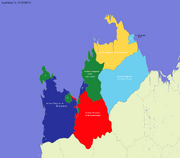
Ancient Kingdoms of Aquitania, 12,000BCE
The Vla' Dhoerng, Pro' Hissen, Wu' Baheigh, Lu' Domm and Aq'Uhitann were ancient peoples united by their very similar culture, customs and practices, they were by far the most advanced in the area. Humans living south of the Western Mainland Desert or the Ludonnian Forests in the South and West sides were considered vile barbarians. Around this time the Peninsular Kingdoms were concentrated in Defending their land and building impressive southern fortifications, the cooperation that their enemies caused a friendship growing in the year 16,000BCE with the establishment of a great blood bond, later peaking in 13,000BCE with the formation of a Confederate style of Union between them. Deities around this time were very numerous, the most important one though, was Cu' Rhouss, God of War, Blood and the Sun.
Towards 10,000BCE, an Aquitanii dispute with Wulffbane over the now New Alexandrian fertile basin lead to war, with the Aquitanii Kingdom emerging triumphantly, formally consolidating itself as the regional power. Wulffbane remained sovereign, hostile and revanchist against the Arlathanian Kingdom. By 10,000BCE, the Aquitanii had talked the Kingdoms of Vladehorn and Ludonnia into becoming tributary states, with the suppossed Aquitanii excuse of Naval Protection from "alien" Sea peoples. The Vladehorn, Ludonnian and Prussian peoples had at the time a grudge triangle and historical emnity because of the irregular territorial possessions of Ludonnia across the Preutter River in territory considered Prussian by the Prussians and the traditional dispute over who controlled the region now known as East Prussia with Vladehorn. Vladehorn and Ludonnia having mutual territorial disputes and whether Vladehorn had the right to establish naval enclaves on the Ludonnian side of the Preutter River or not. Ludonnia feared becoming a landlocked Kingdom and the loss of control over the strategic Preutter River; The Vladehorn feared the loss of its interests in the region at the mouth of the river, the acquisition of the rich region of East Prussia was a major objective. In turn, the Prussians feared the loss of East Prussia, a major military hub, to the Vladehorns, which had splendid border defences in case of an over land invasion by the superior and more numerous Prussian Forces. The attention between the three kingdoms was so drawn to each other that the Arlathanian Kingdom was allowed to grow with the recent blow on Wulffbane. The five Kingdoms, in the past, used to act as a balancing force, but the sudden events allowed for the growth of an empire. The Aquitanii, with an the help of an unknown silver tongue king (Possibly Ulrthertel the Wise) and a little push by its power gained by defeating Wulffbane, convinced the rest of the Kingdoms to form a Confederation, which slowly evolved into Fiefdomship after years of demilitarization and centralisation of affairs, including the armies.
Aquitaniier Reich
10,000BCE-1BCE

The Ancient Aquitanii Empire at its Maximum Extent in the year 100BCE
The Aquitanii, after subduing the local Kingdoms into Fiefdoms, though with the guaranteed degree of Sovereignity and Autonomy given to the four, moved on to the rest of the adjacent continent, including the Nassau Coastlines in the East and the Southern Barbarians. The writing system developed by the Aq' Uhitann by the year 10,000BCE was advanced and significant knowledge of the world's Oceans was known, though the knowledge was priced highly and safeguarded within temples by Zealot priests.
In the Mainland the Kingdoms enjoyed high Aquitanii influence in arts, culture and architecture. The extent was such, that instead of assimilating into the dominant Aquitanii culture, the combination of the five Kingdoms gave birth to a new one, the one currently followed to a degree by the modern Aquitanians. The evolving culture soon limited the number of Gods, with Cu' Rhouss still being the head god. Vladehorn was the Kingdom which most isolated itself, with the Vladehorns in the Prussian controlled region of the Highpeak Mountains refusing to accept the new culture, isolating themselves. After feeling threatened, many Vladehorns departed in the year 7,000BCE to the oceans in search of new land, nothing was heard from them since. The remaining ones pledged to protect their grand culture and language.
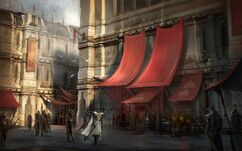
Research Concept Arlathan, Ca 103BCE
Aquitanii conquered and sustained the Nassau Provinces and Great Palms States as part of its Empire, reaching a population of 87,000,000 in the millennium 4,000BCE, the capital, Arlathan, having an estimated 1,800,000 inhabitants, the most populated city in the world at the time. The period between 4,000BCE and 2,000BCE is known as the 2,000 years of Glory, Flourishment and Peace.
The era saw great artistic representations and huge architectural projects in the Mainland. The Empire strictly divided its people by class, the Sects and the Sectless, the latter being undesirables and foreigners, as the Aquitanii and the rest of the four Kingdoms were extremely Xenophobic, Foreigners coming in to find a better life were never treated equally and usually worked as hard labourers, slaves were regularly imported from the Provinces to satisfy the much needed work force and the rich Aquitanii's home chores.

Aquitanii Tower Fortress and an Ancient Elevated Highway near Hannover, Modern Elevated Highways were adopted from the Ancients
After the great era of prosperity, in the year 1987BCE, the Empire suddenly slummped economically and military wise, being involved in more than one conflict with the Parstt Empire in the North East, the wars were always a stalemate, visible evidence that Aq' Uhitann was declining was a series of weak kings and sudden, constant dynastic shifts in the ruling house. Overpopulation was causing famine and the growth of sectless people in the Nassau provinces caused several rebellions which lasted 6 years, put down and controlled for nearly another millennium. The Social decline and instability though were accompanied by a cultural renaissance which lasted from 1981CE to 570BCE, the upgrading of Imperial Routes to "Elevated Highways" resulted in huge profits from reduced bandit assaults, encouraging all people to travel more throughout the Empire. The system of Elevated Highways was easily their most treasured achievement, major segments still remain standing today, the most famous sections are the Arlathan (Arcadia) to Drakon; Arlathan to Wulffbane, Highpeak to Cördessen and the longest, Arlathan to Q'Inhataren (Quinten/Könweiss), capital of the Imperial Province of Konnerwass, now an autonomous state called Milenia.
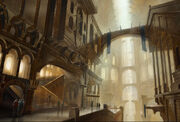
Metropolitan Arlathan at its Peak, 7BCE
The Modern System of Elevated Highways was adopted from the old Imperial One, connecting major cities and never touching the ground unless ending in a City, this type of infrastructure is reliable and famous, being adopted in several other countries abroad, notably Federal Ally Ardglass.
In the year 97BCE, rebellions in the Nassau Provinces caused their loss and growing internal conflict only worsened the situation, economy from the year 90BCE onwards was very miserable, slaves were either deported south to the old Barbarian States, escaped there or were killed because of the lack of resources requried to sustain anyone. Sectless peoples plotted against Emperors, murdered them, deposed them, new weak Leaders replaced them and were ousted again, in an endless cycle of royal blood shed on the Imperial Ancient Aquitanii Throne, the series of very weak Kings continued on until the Vladehorn-Ludonnian-Prussian War beginning in the year 55BCE and towards the fall of Aquitanii.
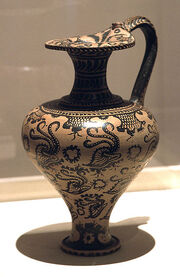
This Piece from Ca 345BCE depicts Sea Monsters
Around 57BCE the very weak Aquitanii Empire seeked to restore control of the lost Provinces on the Nassau Seaboard, hence the navies were busy raiding and blockading cities there, an opportunity siezed by Ludonnia to invade Vladehorn in the year 55BCE and settle the thousands of years of friction and grudge. The Aquitanii Throne, unable to do anything to stop the nearby conflict, decided to do nothing in fear of being invaded by Prussia itself. Which in turn seized an opportunity to conquer the territorial posessions of Ludonnia on the Sommathian (Prussian) side of the Preutter River.
In the year 1BCE, the Vladehorn-Ludonnian-Prussian War finally ended, leaving the three Kingdoms weakened and teared apart by the war. Ludonnia lost its military might to the greater Prussians and the Vladehorns were dealing with a Civil war triggered by their neighbour's Warmongering, the war had ended with a victory on the Ludonnian side, but with a cost, the massacre of most of its army in the battle of Blotwiech and its territory across the Preutter. Ludonnia fearing a complete turn in the balance of war, seeked peace immediately with the unbeknownst Vladehorns and Prussians, which didn't know they had massacred their enemy's entire army. The result was a victory for Ludonnia over Vladehorn, claiming beyond its northern border, but a defeat against Prussia, which gained the fragmented territory of Ludonnia on the northern side of the river and a Ludonnian Buffer in East Prussia against Vladehorn. The war in the end contributed to the fall of Aquitanii and the ancient way of life, including the known World then. The Sevintrian Imperium would have never managed to march past the Prussians if it wasn't for the disastrous civil war.
Age of Occupation (ca 1 - 400 AB)
The Sevintrian Invasion; The Sevintrians first landed in Sommathia prior to the Age of Occupation, and then spread to the rest of the area, engulfing the Aquitanii Empire in the process. The Vladehorns fought ruthlessly, but were slowly defeated by the more advanced Sevintrians, a man relates how huge boulders of lead destroyed entire city walls with one fire. The defense of underground Vladehorn cities was easy and an advantage, in desperate times, Vladehorns collapsed their entrances and sealed themselves in their own tomb. Many cities are yet to be re-opened and explored. A legend states that the Vladehorns hid a mountain city from the enemy for millenia to the north, near Highpeak, and it still remains hidden today, historians that believe this story explain that Vladehorns seclude themselves to hide the mystical city.
The Sevintrian brought their culture and banned Aquitanii customs, and were largely dedicated to building huge fortresses to protect the Peninsula, the center of Sevintrian dominion in the colonial Sevintrian Imperium.
Age of Old (402-1500 AB)

Kahltforien, Capital of Arlathan ca1230
After the Sevintrian High Magisters and Armies were expelled, the Arlathanian Royal Assembly population demanded that Tridius Wolfker be placed on their throne. After being declared the righteous High King of Arlathan, Tridius ordered the persecution of all ethnic sevintrians and their sympathisers in his Kingdom, the rest of the Kingdoms followed suit. The capital was established in Waeschen, where Tridius was crowned, but then moved to Kahltforien in 447, the year Tridius died. Coronations continued to be serviced in the Waeschen Scept, then the largest building in Aquitania. With the seat of the Arlathanian High Court in Kahtlforia Castle itself, built in the year 255 by Aquitanian Nobles, Tridius' descendants ruled a powerful Kingdom from the most safest and strategic location in Aquitania. Kahltforien thrived and became for a short time the most populated city in the small Kingdom, given its strategic location in a hill ion the heart of a Valley inside a Mountain Range, getting an army to the city was a problem itself, foreign armies (Particularly that of Wulffbane) never breaching the outer Mountain Defences before routing away.
Religion and the Luxesscept (The Veneration of Light)
Religion after Occupation was a controversial subject, as the turmoil of the wars of liberation was also present in the beliefs of the people. The Old Gods of Aquitanii were a fading belief which barely survived persecution during the Magisterial Period (Sevintrian Occupation) and the Monotheistic beliefs of the Sevintrians were expelled with them after their occupation, thus leaving the Aquitanian population without a firm religion in the initial years of freedom. However the old Oracle of Light in the Kingdom of Vladien, the remains of a temple to the Aquitanii God of Light, began to spread the belief in a new God of Light and a God of Darkness, the movement proved popular and it soon was the predominant religion by the year 493. The Luxesscept was very influential at its inception, it was viewed as a very pure church, the church that denounced slavery, a practice brought in by Sevintrians, as a blight in humanity. Slavery ended in all the Kingdoms in 501 as a result of this, the church largely helped establish specific morals during its height, generally regarding any form of corruption as vile, thus helping create the core of what the Aquitanian people were generally admired and recognised form in the future.
Five Kingdoms
The Five Kingdoms of Aquitania were Arlathan, Wulffbane, Vladien, Prussia and Ludonnia. All of which exist presently with the exception of Arlathan, which was devolved to a Grand Duchy as part of the conditions set in order for the Kingdoms to agree to the creation of the Empire in 1507. Despite being united for millennia under the Aquitanii Imperium, following the Sevintrian Expulsion, the Kingdoms rose as independent entities, despite Tridius Wolfkehr's ambitions for a strong, united Empire based on the old Aquitanii Imperium. Regardless, the Kingdoms were ethnically Aquitanian and Tridius did not pursue a military campaign in order to forge the Empire, wagering that the Kingdoms would orbit towards each other in the future and create the Empire he dreamed of, his prophecy became a reality half a century later.
Prussia
Pending
First Aquitanian Empire (1500-2467 AB)
Trade and Growth (1500-1720)
| Aquitanisches Reich
Aquitanian Empire Greater Aquitanian Empire | |
| Motto: Kämpfen und bluten gern für Thron und Reich! | |
| Anthem: Für Thron und Reich | |
| Geography | |
| - World | White Giant |
| - Continent | Auriga Bella |
| - Region | Great Palms |
| - Capital | Arcadia |
| - Largest city | {{{Largest_city}}} |
| Official languages | Aquitanian |
| Ethnic groups | {{{ethnic_group1_percentage}}}% {{{ethnic_group1}}} |
| Demonym | {{{demonym}}} |
| Government | Imperial Autocracy |
| - Kaiser/in | Johanna I (Last) |
| - Reichskanzler | Viktor von Steele (Last) |
| - Reichstag | 2495 (Last Assembly) |
| Legislature | {{{legislature}}} |
| Events | |
| - Formation | |
| - Formation | 1500 |
| - 8 Years War | 1545-1553 |
| - Wars of Expansion | 1740-1800 |
| - 1st Industrial Revolution | 1797-1857 |
| - Seven Years War | 1857-1863 |
| - 2nd Industrial Revolution | 1890-1923 |
| - Collapse | 2467 |
| Population | |
| - Total | 30,000,000 1790 Census
114,400,000 1923 Census 82,210,000 1928 Census 112,900,000 1990 Census 123,478,990 2130 Census 143,700,000 2460 Census |
| Military | |
| - Active personnel | 10,000,000 (Normal)
14,000,000 (5 Years War) |
| Organizations | |
| - Federation | None |
| - Common Market | None |
| - Empire | Greater Aquitanian Empire |
| Production | |
| - Total | SC$400,000,000,000 (1923)
RM$680,000,000,000 (2460) |
| - Per capita | SC$41,958 (1923 Est)
RM$56,785 (2460 Est) |
| Currency | {{{currency}}} |
| Internet TLD | {{{Internet_TLD}}} |
| Drives on the | {{{drives_on_the}}} |
| URL | [{{{url}}} Aquitanisches Reich
Aquitanian Empire] in Simcountry. |
The Imperial Age, or "Age of Rejuvenation" as called by traditionalists, began in 1500 with the foundation of the Empire of Aquitania after King Richard Wolfker der Grosse of Aquitania was declared so by the Aquitanian Nobility and the Kings of Wulffbane, Vladien, Ludonnia and Prussia, then members of the Nordlanderbund.
The Age though began with conflicts with the Mirelian Empire which contested the Imperial Status of the Naval Country by issuing threats, Aquitania declaring war on 1545.The events are called the 8 years war, in which Aquitania defeated Mirellia and gained the vital province of Sieländer, which had Iron and in the future, known to have abundant coal mines. After the 8 years war ended, the Mirellian Empire was partitioned, only retaining their central lands. In 1553, Aquitania was a regional power, trading with Portugal and the then Calzador Empire, which would become an enemy 1400 years later. Aquitania prospered economically undisturbed, constantly battling the Sevintrian Privateers which raided the Western Coasts of Great Palms, until the Naval Battle of Savoyard Bay in the year 1661 saw them devastated and permanently defeated. Aquitania saw the arrival of the Jesuits, Calzadors and Portuguese to the Southern Lands throughout the 16th and 17th Centuries, in an effort to colonise the peoples. The Aquitanian Empire first supported Portuguese Rule and even helped drive out the Calzadors with Prussian Officials helping Portuguese Soldiers.
The First Aquitanian Empire saw its development from a pastoral, medieval nation to a highly advanced, space faring nation by the year 2450. The Empire collapsed in 2467 when two factions, one wielding significant power, decided to project military force in order to establish their principles in the country. The Empire was overwhelmed with the fall of numerous cities, including Arkadien, Savoy, Brandenburg, New Alexandria and Awariss.
In the year 1680 however, the Southern Colony of Constantine was conquered by the Calzadors, which established a peaceful regime. Aquitania though, had other issues to tend to, including the rise of the Bohemian Kingdom in the South East, which directly threatened the Province of Sieländer and the Duchy of Konnerwas on the Eastern Coast, several edicts were passed, on which promoted and grew the Military 5 times its former size, the establishment of the renowned Wurdennberg Guards and the establishment of the Royal Military Academy. The Mirellians were at the time wary of the growth of Bohemia, fearing potential as a great power. In the year 1718, the Calzador Viceroyalty of Constantine attacked and defeated Bohemia, annexing it into their colonial realms, Aquitania and Mirellia were shocked and now openly worried about Calzador Power, this eventually triggered the Wars of Expansion in 1740. From 1718 to 1740, Aquitania fostered relations with Calzador in an effort to prevent a two front war, which would certainly topple the Kingdom.
Wars of Expansion (1720-1800)

Battle of the Könner; Aquitanian Troops Lining up to Fire
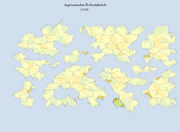
Map of the Aquitanian Colonial Empire, 1750
The Wars of Expansion were several conflicts between the Mirellian Commonwealth to the South East and Aquitania, battling for control of the Duchy of Konnerwas, which was under Aquitanian rule. With several victories in the year 1759 and with the siege of Durmont 60 years later, Mirellia, already war exhasuted, surrendered. Aquitania acquired territory all the way to the Bössur River, establishing a strategical border between Mirellia and Aquitania, deterring any future attacks. During the War, Aquitania grew economically after most people reaped the benefits of manufacturing Bandages, Medicinal Concentrates and Weaponry. Aquitania consolidated its Power around this time, establishing the Empire as a Continental Power. The wars also included conflicts off continent, expanding the colonial empire was something the Imperial Government pursued with fervour, noting that wealth came from the establishment of strategic setholds around the world. Eventhough the Colonial Empire's peak were the two decades from 1740 to 1750 and Aquitania enjoyed wealth that would later lead to victory in the Seven Years War, the Empire lost a substantial amount of colonies abroad, declaring their independence and breaking free from Aquitania. Aquitania recognised most nation's declarations of independence following the Seven Years War and established close trade and political relations with many of them.
First Industrial Revolution (1797-1857)

Savoy Train Factory, First Industrial Assembly Line Complex in the World
In the year 1797 the first practical and continous usage of steam for energy surfaced, and with the abundant mines of Coal in the Province of Sieländer, Aquitania was one of the first nations to enter the Industrial Revolution, further boosting its wealth. The eventual growth paid off in the Seven Years War, war which Aquitania entered with its Prussian Soldiers in the year 1857. In 1840, the first Railway service was established between Arcadia and Avaris, the Avaris-Westlairen Section was finished in 1843, Westlairen-Preutterdam in 1846, Prutterdam to Savoy in 1853. With the arrival of the Railroad, industry always traditionaly surrounded Savoy and the city remained the Industrial and Financial Centre of the country since then, in 1857, the first Assembly Line Factory in the world, which produced Locomotives, was founded in Savoy, creating a lucrative business by exportation of the best Locomotive Steamers to other Industrialising Nations. The Railway was a great miracle to the country, since it quickly moved goods around the nation. The first Social Security Reforms and Worker Protection Laws surfaced and a regulated a system for Unemployment Pensions surfaced, welfare was the greatest in the world, thanks to the efforts of Reichskanzler Burgdorf in 1856. These economic developments enrichened Aquitania, the great surplus and mountains of gold in the treasury enabled the country to influence in the Seven Years War, starting in 1857.
Seven Years War (1857-1863)

1857 Battle of Prague
The Seven Years War, starting in 1856, was a World War in which most local powers participated in. Following a Non-Aggression Treaty signed by Mirellia and Aquitania, the latter declared war on Calzador in the year 1857, thus entering the conflict, in a burst of self confindence with the Pretext of "Liberating the Yutschek People, from Oppressive Calzador Rule". Aquitanian Armies entered Yutschenia and fought the great Battle of Prague, the Prussian Regiments were victorious and proceeded to lay siege to the City, but a Calzador counter-attack forced a retreat after a defeat in the Battle of Kolin. The Mirellians took up the opportunity to invade Aquitania in 1859, as the latter's forces were concentrated in Sieländer and Yutschenia to the southwest and they declared war, invading poorly garrisoned Eastern Aquitania (Then the Province of Konnerwass). The attack advanced as far as the city of Könweiss and threatened to enter the heartland should the city fall, these developments that forced Aquitania to sue for peace with Calzador in 1860 and direct their attention to the East. In 1861 the Mirellians were expelled from Aquitania, despite this, a considerable amount of their forces had managed to regroup following a breakthrough from an Aquitanian encirclement and quickly captured Prague from the Calzadors in 1862. The latter was a surprise, considering the fact that Mirellia never officially declared war on the Calzadors and these were not expecting an attack from the East. Such events presented an opportunity the Aquitanians could not let pass and the Kaiser quickly ordered the invasion and recapture of Prague, a successful endeavour that made Aquitania prevail over the Mirellians and Calzadors permanently for the rest of the century. The Calzadors never recovered from the blow and were expelled by the Portuguese in the early 1900's.
2nd Industrial Revolution (1890-1923)

Tridius-Bauss Platz, Brandenburg, 1870
The Second Industrial Revolution, starting in 1890, revealed combustion. The growing Carriage Manufactury of the Marshall Zimmer Brothers created the first Engine in Aquitania and later the First Horseless Car in the year 1891. The first vehicle to cruise on an Aquitanian Street was in Savoy, along Königsstrasse Avenue (Now Bundesstrasse). The first model Aeroplane was created in 1902 by the Gleibschmidt Sisters, which were praised and criticised for having created the first Plane, but also for the impression of having Women invent something...
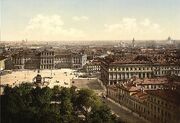
Savoy Skyline, 1895, Looking Inland
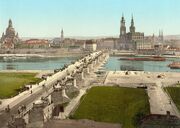
Königsberg, Herzogtum Sawoie um 1902
Innovations in Military also followed suit, the Haggel Rifle Company created the first Machine Gun, called the Kleinerbess, in the year 1909, new mortar and artillery models were advanced by 1912 and the first armoured tanks began to be built in 1917 for the army, gaining considerable advantage over Mirellia and Calzador. In the year 1916, Aquitania sold the majority Jesuit-Portuguese Province of Lothringen to the newly independent Viceroyalty of Constantine as a sign of friendship, the capital of the Province though, Strassburg, remained under Aquitanian jurisdiction.
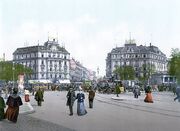
Wölfestein Platz, Königsberg, 1904
The selling of the Province caused mass dicontent throughout the empire, specifically among ethnic Aquitanians living in Lothringen itself, which rebelled several times against Constantino rule, the latter allowed the rebellions to run their course, as it did not want to insult the Aquitanian Reich by supressing the Aquitanians in Lothringen with violence. Official plebiscites were also attempted by the population, which were ignored by local Constantine authorities. The City of Savoy enjoyed the favour of the Late 19th Century and 20th Century Kaisers, which built splendorous Palaces in the City or its vicinity, attracting more of the Aquitanian Junkers living in the East to the industrious Aquitanian West. These massive migrations displaced numerous Aristocrats from their traditional seats in Arlathan in favour of placed like Brandenburg, Savoy and Königsberg. The development also attracted the Commoners, which left the overpopulated Eastern Mainland to live in the West.

Friedrich-Linden Platz, Brandenburg, 1912
Around the turn of the century, Königsberg began to regain importance, being of such closeness to the Industrial and Economic core of Savoy, Königsberg rose as a touristic destination. Monuments and the Theatre Districs attracted wealthy citizenry, the Palast Hotel on Tridiusstrasse was the most opulent Hotel in the Continent. Meanwhile, in the south, the booming Viceroyalty of Constantine, a Sugar Giant, exported Sugar to Aquitania, which benefited from the southern sugar, replacing foreign and expensive sugars that came beyond Auriga. At the time in 1922, the population in Aquitania was 120 Million and it was a major industrial and leading nation, influence was exerted over Constantine and other countries like Mirellia and Lesser Yutschenia, all which relied economically on Aquitania for their relevance.
Aquitania was from 1888 to 1928 the most industrialised and innovative nation of the planet, in 1909, the City of Brandenburg alone had more cars on the street than Bohemia to the South and Mirellia combined. The City of Brandenburg, in 1912 the most populous City in the Kingdom, had the most extensive public transport system in the world, made up mostly of trams. Brandenburg was the Star of the West, attracting the full load of the Commoners, eager to leave the overpopulated East, heading out to the vast "Western Mainland", which is actually smaller but at the time was less populated. Brandenburg was favoured for its prominent and famous places and Insitutions, like the Tridius-Bauss Platz, Friedrichstrasse, Lindenstrasse, Brandenburg University and the opulent Victoria Cafe over the Friedrich-Linden Platz, which was the most important and commuted intersection in the City, "Das Herz von Brandenburg" (Heart of Brandenburg).

Prussian Junkers (Aristocracy) in a Cellar Tavern
In the 1920's the traditional Cellar Taverns in the country rose in popularity among the Aristocrats, which frequented them more commonly than in the past, when it was believed these taverns were reserved for the Commoners while the High Class enjoyed the High End restaurants like the Palast Hotel or the Victoria Cafe, in the 1920's though, the High Class began to appear in larger groups in the respective Taverns of the City, the most popular Tavern being the one under the City Assembly. With the Aristocratic Circles in the Taverns, the Commoners in turn began to frequent the opulent Restaurants. At the time, "Commoner" was almost synonym with being poor, despite the fact that more than half the Middle Class were affluent civilians and the already scarce poor people rose quickly into the Middle Class. The 19th Century Worker Reforms helped the quick erradication of hunger and poverty in 1936, from a Medieval System of Mostly Poor-Commoners in the 15th Century to one of the most Wealthy countries in the late 19th and 20th Centuries.
Great 5 years War (1923-1928)

First Empire at its Maximum Extent - 1910
After years of watching revanchist Mirellia with a cautious and guarded eye, the Empire began to pursue a rigorous and expansionist Imperial agenda abroad, acquiring colonies in Antilia Major, Lacerta, Eridana and Centura Donna. A large portion of the Nord-Reichkriegsmarine, then the largest and most powerful fleet, was in a mission in Lacerta adding to the fact that most of the Imperial Armies were transfered to the Colonies as "Kolonial Truppen", to keep the territories under the Iron Hand of the Kaiser, notably the 10th, 9th, 7th, 6th, 5th, 4th and 1st Armies, out of the 10 Available in peace times and 15 during War Times, served abroad. The unecessary and perilious move was protested by Reichskanzler Georg von Gottinberg, which was dismissed when he got in a quarrel with Kaiser Richard IV over the issue, appointing Axel von Börnwitz as the new Reichskanzler in the year 1922. The confident Kaiser was determined Mirellia would never commit a suicidial mistake, such as invading a world power, but he was wrong. The political situation in Mirellia verged on collapse, extremist groups rose to seize power and establish a ruthless police state beginning in 1923, which had the only objective of recovering the lost lands from the Aquitaines in the west. In November 1922, the last Intelligence report given by the Imperial Intelligence Office (the predecessor to ONI) to the Kaiser stated that Mirellia was in a weak and declining position, verging on bankrupcy, encouraging the Kaiser to send troops south to the Wausen Naval Base and the city of Wehrstadt (Present day Neapola) on the Wehrstaat Peninsula (Present day Constantine), which was under constant encrachment by the Calzador and Constantinians and was a key strategic location in the Southwest. This action leaving only 2 Armies in the Imperial Mainland, promting suddenly rearmed Mirellia to declare war on November 1st, 1923.
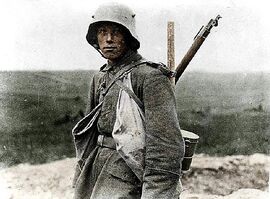
Aquitanian Soldier, 8th Army, 1925
Mobilizing 5 armies to the Aquitanian border, the Mirellians posed an alarming threat to the Province of Bössien, which was quickly invaded and overrun, Kaiser Richard IV had a nervous breakdown when news of the Mirellian invasion reached Arcadia (Arkadien). The Chief of Staff took command of the situation while the Kaiser recovered, which ordered the immediate mobilization of the army. Thanks to the superior Railway network of the empire, the invading Mirellians were held at Könweiss, capital of Konnerwas, by the Second Army, while the 8th Army hastened itself from the Kingdom of Prussia into train cars at the shores of the Kingdom of Vladien. Mobilization in the west was slower. The Nord-Reichkriegsmarine was recalled from Lacerta in the year 1927 and the Schwarz-Reichkriegsmarine (The Imperial Black Fleet), was recalled from its exploration at Paova Major in the year 1928 (When the Ebirnian threat was deemed more obvious). At home, in January 1924 the traditional Prussian Conscription System roused an additional 2 armies, the 11th and 12th, which struggled at holding enemy forces in the Province of Jutland (Greater Yutschenia). The Second Army was destroyed in the fall of Könweiss in 1925, the disaster was blamed on the 8th Army, which failed to reach the city on time, despite the loss, it skirmished the MIrellian Army which took Könweiss for months and then battled and defeated it a few kilometres north of the City, to then dig in for the winter in Trenches. In 1927, following successful Winter Offensives in Jutland, (Yutschenia) pushing and routing the Mirellians back to the East, the 11th and 12th armies were ordered to stand-by until Spring to flank the entrenched Mirellian forces in northeastern Konnerwas from the south in a "south to north arc" offensive, action which secured a decisive victory (von Fulk Plan). Before the foreign ministry demanded unconditional surrender, Ebirnia, stating intervention to save Mirellia from complete dissolution, declared war on Aquitania and deployed fleets to blockade and bombard important Naval Bases and Ports. The latter severely crippled the giant economy, by 1928, Aquitania surrendered to prevent harsher terms from being imposed. Ebirnia and Mirellia forced Aquitania to sign the Treaty of Nordford in November 1928 in a humiliating twist of fate.
Treaty of Norford
The Treaty of Norford demanded the following points:
- The Imperial Province of Jutland (Yutschenia) was to be granted Independence
- The Imperial Province of Bössien was to be ceded to Mirellia
- The Imperial Province of East Hofland was to be ceded to Mirellia
- The Imperial Duchy of Konnerwas was to be granted Independence
- The Imperial Colony of Belka was to be granted Independence
- Upper Sieländer was to be ceded to the newly created Republic of Yutschenia
- The Imperial Province of Kaledonnien was to be ceded to Yutschenia
- The Imperial Province of West Hofland was to be ceded to Yutschenia
- Lower Sieländer was to be a Free Economic Zone for Yutschenia
- Enforce and Protect the Neutrality of both Yutschenia and newly created Kronvas
- Release of the Lacerta Colonies to the Administration of Ebirnia
Post-War Recession (1929-1932)
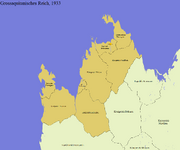
Greater Aquitanian Empire, 1933, Post-War
The loss of 11 million people in the ceded territories and the blockade of 1929 caused a severe economic recession, a worker crisis ensued after a lack of employees in southern Wulffbane, (workers which used to commute from nearby Konnerwas), caused the closure of 8 factories. This forced the Imperial Government to broker an agreement with the newly formed Republic of Kronvas, agreeing to the yearly transfer of 5 Billion Reichskritin to the war torn country in exchange for workers commuting across the border, lightly solving the immediate issue, but adding to immigration problems later.
The August Savoy Stock Market scare of 1931 proved to be the lowest point of the period, foreign investment halted after insecurity took hold, but the situation recovered a week after the panic, with the sale of Lower Sieländer to Bohemia in mid 1931, the Empire bought Gold Reserves and the stocks recovered healthily at such extent that by February 1932, the recession was over, a boom after the discovery of Oil off the Coast of the Kingdom of Prussia and in the Bay of Aquitania fueled the following Years of Prosperity that began the same year.
Years of Prosperity (1932-1957)
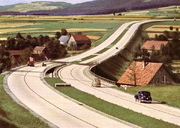
Reichsautobahn, Crossing the Savoyard Ducal Countryside, ca 1939
The greater oil reserves discovered in 1932 caused the Vehicle industry to rocket, vehicle manufacturers like Lancesterien Motoren, Preusschwaggen and Marshall Zimmer prospered by the people encouraged to buy cars now that fuel was at 1 Reichskritin per Liter. In 1933, Kanzler Axel von Börnwitz wanted all Aquitanians to afford vehicles, which were at the time aimed at the Elite, with costs such as 60,000 up to 90,000, the Kanzler especially wanted the lower Middle Class to join in the vehicle boom, which were the remaining vestiges of poverty in the country and were the Aquitanian Majority, he saw the importance of making these masses pay the Gasoline Tax and so forced the manufacturers to produce less luxurious versions of their vehicles, focused on families, with lower prices, such as the famous Preusschwaggen Px14, valued at 22,000 Reichskritin. The result was an excessive amount of cars on the streets, partly leading to the commissioning of Reichsbahn two years later.

Port of Savoy, 1935
Kaiser Alfred X commissioned the building of an imperial wide system of highways called the Reichsautobahn in the year 1935, consisting of nation wide expressways in addition to the already existing Elevated Highways, which dated from the Aquitanii Imperium and were in dire need of retirement and restoration; Alfred X, led to this in an effort to fuel the vehicle boom, ease transportation and gain renevue from more gasoline taxes. Fuel which was more quickly expended with the Highway Edict of 1939, which officially made the entire Reichsautobahn speed limitless.

A High Class Penthouse Event, 1948
The City of Savoy, prior to 1920 a simple Palatial Port, grew and flourished into the World Capital of Skyscrapers, having the highest and tallest buildings in the world by 1935, a title it preserves to this day. A second Reichsautobahn section, the Savoy-Königsberger Link, was inaugurated in the year 1935, making Savoy, the undoubtable key port of the Empire and the second most populous city behind Brandenburg. Savoy was admired for its modernisation, High Class Wealthy Civilians and Nobility hosted opulent feasts and dinners in Skyscraper Penthouses, enjoying the view while drinking Passed Wine and eating, or perhaps dancing. Savoy was the focal of High Life in the years of Prosperity, becoming the world's most Wealthy City in the 40's and beyond until the Great Schism reached its southern suburbs. Capital of Fashion, Savoy became the most renowned world city in 1945, when it hosted the 1944 World Fair, attracting all kinds of people from the four corners of White Giant, Wealthy and Middle Classed, investors and entrepreneurs, which immediately opened up business in the sprawling city, making it a very attarctive venue for both the Leisure Seeking Foreigner and the Business Minded Gents of the Mid-20th Century. The development of the Nuclear Weapon and eventual Nuclear Usage in Energy were effected between 1936 and 1940.
Atomic Period (1957-2030)

Aquitanians waiting at Savoy's Bahnhof, 1958
By 1940, Aquitania's Office of National Intelligence was researching, developing and producing the necessary Fissile materials that could power the Nuclear Chain Reactions that accompanied a bomb and also focused on the very specific job of producing the weapon and its trigger mechanism. This eventually lead to the first testing of the Atomic Bomb, Kassler I, on an island off the coast of the Duchy of Hohenschon, present day Duchy of Schleswig in the year 1957. The test triggered the start of the new Atomic Period in Imperial Aquitania. The testing and eventual influence of Atomic Bombs and Energy ushered in profound changes in socio-political thinking and the eventual course of Aquitanian Technological Development, eventually leading to the 2064 MSS Donnae disaster. Despite that, the Atomic Age spurred a huge social and cultural change in the country.
The people were captivated and built the future around the Atomic Innovation, thinking it would lead to clean energy, its usage in every appliance from Nuclear Plants to small Nuclear devices, for the powering of vehicles and many other uses. The Nuclear Energy came to its most unpopular time in the 1980's through 90's with the arms race with Mirellia.
Technological development eventually lead to the Space Faring Period with the first Orbital Launch in the year 1960. Pending...
Space Faring (2030-2375)
In 2030, the Reichswehr's Kriegsmarine expanded to space as one of the first armies in the Centaudos system to do so, creating the Outer Navy, or Ausskriegsmarine, the Reichswehr was paramount to the future of Aquitania in space and was the trigger event that redirected Government and Imperial attention to the skies. The leap officially propelled Aquitania into the Space Faring Period, characterised by increasing involvement, exploration, exploitation of resources and military armament outside White Giant. The entrance to the Period also ended the closing years of the atomic age, marked by the neglect of space, noticed by the less occurring rare launches of petty machines or three manned space vehicles. The Reichswehr, funded individually, realised the strategic importance of space and deviated funds to the creation of jets and then small ships to be manned in space. ONI later propelled the civilian transition and renewed interest in outerspace. In the three centuries it spanned, the output of outerspace was mainly raw materials via Asteroid Mining, as opposed to contemporary Aquitania's powerful commercial and touristic Space Industry born in the Helzignorr Period.
The country enjoyed short lasting additional profits from 2062 to 2125 thanks to the large metal mining work done off-planet. The first Mining Ship, the BS Wohnschaft, worked on stranded Asteroids making their way near White Giant, their distance influenced whether the work done on them was feasible or not, regardless, their occurrence was a rarity, leading to the decline of the Space Mining Industry by 2125.
Helzignorr Period (2375-2467)
ONI, with Norbert von Helzig as the lead scientist, was responsible for the Ausskriegsmarine's technological developments from 2350 to 2389. In 2375, von Helzig and the Ausskriegsmarine Team made its most famous breakthrough; the Helzignorr Drive, enabling Faster Than Light (FTL) Travel or Slipspace Jumps. ONI immediately created a programmed focused on the development and imporvement of the Drive and encouraged further investment on the field. The discovery made ONI Scientists, specifically Norbert von Helzig, the discoverer and head of the programme, very enthusiastic, leading many civilian and military prototypes to be created, from Short & Mid Range Public Transport Teleporters, to Full Fledged Personal Planetary Transporters, the latter which would have made any Passenger Starship obsolete. The dicovery of the FTL Drive was the most revolutionary breakthrough in history since the combustion engine and the people at the time were very thrilled that travel to faraway planets would begin to be possible in later years, von Helzig and his team though treaded with caution, leading to preliminary, successful tests that began to win their confidence, culminating in the 2389 Arcadia Incident.
The first successful test run on a ship was done in 2377, further tests that same year and in the subsequent years of 2378, 2379 and 2380 with a wide range of ship sizes determined that large portals would stress smaller transports' hulls, leading to scientists determining that weak hulls, small ships and jets would be destroyed by the energy the portals created. The aforementioned experiments were later used as references by the Imperial Transport Authority's rigid requirements for a vessel to receive Slipspace Permits. In-atmosphere testing in 2385 over Awariss initially gave positive results with exiting ships (arriving), but proved catastrophic with ships entering portals (departing), as the latter's flux dragged several city objects towards it, to then culminate with a large EMP Wave, creating a huge blackout and frying electrical devices, costing the city billions of Kritines in material damage; the incident also prompted the Imperial Transport Authority to create further regulations for vehicles capable of FTL Travel, banning them from atmospheric traffic, indirectly leading to the planning and eventually building of the first Space Port (2509) and then Space Elevator (2969) in Aquitania and the World. Ground tests and experiments continued with smaller portals and traffic designed for personal or group travel, in 2389, an uncontrollable portal opening from a failed test expanded rapidly in ONI's Arcadia laboratory premises and then the city, consuming the entire port and killing and estimated 580,000 people, in the worst peace time disaster in history to date. The disaster claimed the life of Norbert von Helzig, lead scientist, and lead to the implementation of further regulations and security protocols for FTL Drives and Ships, well aware that a drive in the wrong hands would mean disaster. Building of drives destined for civilian use were initially cancelled by ONI, but later allowed to be sold in 2404 to major airlines and seacargo companies wishing to expand to space.
Major companies such as passenger airline and space tours giant AQverein, cargo giant Preutter Nord and
The Helzig-Universität zu Königsberg is named in honour of Norbert von Helzig.
The Great Schism (2467-2809 AB)

The Kaiserin Johanna Antoinette, Symbol of Imperial Aquitania, Feldsmarsch Schloss, 2468. Flanked by an Elite Black Guard
The Great Schism (Große Kluft), is recognised today as the most violent and longest Civil War in the country's, planet's and human living memory. Lasting a total of 342 years, the conflict was marked by a general lack of Government in wide areas called the "Dread Extensions" (Angst Nebenstellen). Only limited, City State size claims by three oppositions remained permanent and unchanged for most of the war with exceptions, one of the three divided occasionaly periodically holding more land than the other throughout the years. And marked times where one party nearly annihilated the other in vicious and sudden victories. The three factions were the Imperialists, Zealots and the Republicans. The Imperialists, being the dominant power at the beginning and end of the war, reaching all time lows in the years 2491, 2602 and 2723; were generally the strongest of the divided three. While the Republicans were weakest throughout the conflict, being virtually inexistent until the year 2491 when Brandenburg fell, afterwards the movement collapsed and never fully recovered after 2589, when Brandenburg was captured by Zealot Forces in the bloodiest siege and slaughter of innocent civilian population in the history of Aquitania, reducing the once most populated city of the Empire to a war torn deserted grid plan. The Zealots were easily the most berserk and ethnocentric of the three, being powerful for the most of the conflict, lowest point being when they were crushed at the end of the conflict in 2809. Anything that fell to the Zealots was subject to ethnic cleansing, at the expense of the local population, which usually faced murder after not having passed specific tests. Conflict began with the release of three Documents: Letters of Nationalisation and Distribution, Edict of Savoy and the Suspension of Weissluechte-Stadt Autonomy. The latter being the igniting spark. To end 342 years later with the Execution of Ernst IV Kugelschreide, the "Enlightened Leader" and the signing of the "Aquitanian Treaty of Brandenburg" in the years 2808 and 2809.
The Three Letters of Collapse

Walled City of Weissleuchte, 2465
The year 2467 was shrouded in gloom and a clouded sky covered the Arkadien, capital of the Greater Aquitanian Empire. Kaiser Anton V was dead, but his beautiful daughter, Crown Princess Johanna Antoinette, succeeded his sonless father the same year. In contrast to her father, she was a liberal Aquitanian that despised the Religious dominance of the Church of Light, based in the Autonomous and Holy City of Weissleuchte-Stadt, present day Luxerstadt. Rumours of the racial tendencies of the "Enlightened", circulated in the major cities of the Reich, the population was utterly disgusted by the signs of racial cleansing and segregation of foreigners the church was effecting, propaganda in the city itself blinded the citizens in Weissleuchte with lies.
The new Kaiserin, was equally disappointed at the practices of the Church and set about to halt them. The Templedome of Light had amassed huge and numerous properties in the Empire ever since its arrival in the year 402 with the invading Sevintrians, to the point where the modern provinces of Westvlad, Oberostvlad, Vladish Preussen and Wollusien were in themselves, a Kingdom of Aquitania, since the Church demanded full autonomy from the Imperial Government. The Kaiserin dismissed them and in 2567 moved with the Act of Nationalisation and Distribution, referred to as Letters, which confiscated the majority of the properties of the Temple of Light and distributed them to the nobility and civilians, the city and major temples around the country, remained untouched. Organised protests by the Church that same year are considered, the start of the civil war, but the actual carnage happened a few years later. Hundreds of thousands of zealots staged protests in the city of Weissleuchte and its surroundings and the protests were considered isolated.
Pleased by the results, against her Advisor's wishes and in favour of her Hall of Dyrant, she proclaimed the Edict of Savoy, stating that segregation was illegal, rights were equal among all and that racial sub-divisions were not moral and were not in sync with Aquitanian customs. The Chancellor intended to make the declaration as less directed at the Holy City as possible, but it was obvious and the Zealot Elites were outraged, but complied with the Imperial Law. In response, the Zealot Council staged a complete reversal in its policies; passed local laws allowing them to charge fines to civilians wearing certain garments and influenced educational facilities in the city to not favour foreign students, declaring English the official language, in admiration of the Colland Model, a country in Hercula Major which implemented racial laws and spoke English. The Imperial Government though was against the reforms implemented by an Autonomous Weissluechter Council and the Kaiserin suspended the Holy City's autonomy in 2468, which ended all autonomous privilages, the administration of the City falling on the newly assigned Arl of Weissleuchte, under the Duke of Wollusien, serving the King of Vladien, which in turn answered to the Kaiserin. The Holy City responded by sealing its gates to the new Arl before his arrival, sending a communicate to the capital demanding the Act be revoked. Upon being refused, the City ceded from the Empire, thus starting the Great Schism.
Advance of Weissleucht (2468-2475)
The Weissleuchter Advance was vicious and fast, occupying half of the Kingdom of Vladien and the Kingdom of Wulffbane, Holy Artillery was pounding at Awariss, capital of Vladien and the march towards the City of Wulffbane showed no opposition, until a Wulffbane Regiment held the Holy Army at bay in the City outskirts, at the branch river Kleine Arkweisser. Imperial forces took long to mobilise, at the expense of a Quarter of the Eastern Mainland. Holy Forces were stopped short from entering the Duchy of East Prussia, after a Prussian Division managed to stop them short at the River Möss, the border of East Prussia and Vladien. Following their unsuccess in their campaign against East Prussia, the Weissleuchters adopted a policy of Scorched Earth, burning everything in their path, to try and dissuade Imperial Troops from Invading and attacking Weissleuchte Stadt, which worked. The Zealots then proceeded to mine the fields and roads leading to the Holy City, leaving the Vladehorn Forest exempted because of the belief that it was haunted and was on top of that unholy, where darkness crept and could be easily angered. By far, the Empire had seen little of what was to come, in Arkadien, the Kaiserin was informed of a rebellion, that could be squashed quickly and so mobilised a token force to combat the Zealots, which overwhelmed the Imperialist Forces. Leading to the Fall of Arkadien and Wulffbane in 2495 and 2501 Respectively.
Brandenburg Uprisings (2490-2491)
Republic of Prussia (2491-2589)
Fall of Arkadien (2495)
The Dread Extensions (2495-2798)

Survivalist/Wandering Father & Son near the Ruins of Savoy
The Dread Extensions was a period of reversal in urbanisation, which saw the desolation of major urban centers and the rise of Survivalist, Wanderers and Greater Farming communities. The period around this time in the Civil War saw most of the known Aquitanian way of life turn nomadic, great battles turned into rare skirmishes by weary armies. Normally, the established communities constantly fled the Scorching of the Zealot armies or the Imperial Conscription System, forcing men into the army or executing them for treason. Civilians were unfortunately in the middle of the conflict, but uninvolved in this period. The name derives from the fact that large extensions of land were not governed by any party and were just raided or scorched occasionally by either side. Major fighting, (excluding the Fall of Brandenburg in 2589), and a break to the stalemate occured in 2798, when Imperial forces began to gain (and keep) territory.
Fall of Brandenburg (2589)
The State of Light (2589-2664)
Savoy, Imperial Capital (2664-2759)
Destruction of Savoy (2759)
Wulffbane (2723-2809)
Aquitanian Treaty of Brandenburg (2809)
Factions and their Capitals during the Civil War
Imperialists - Arkadien
Zealots - Weissleuchte Stadt
Republicans - Brandenburg
Second Aquitanian Empire (2809-2914 AB)
Pending...
Second Great Schism
Prussian Age (2914-2945 AB)
The Prussian Age marked the lifespan of Prussian Hegemony over the other Kingdoms in Mainland Aquitania after the Second Great Schism. A reversal in the Imperial System came about and the Historic Kingdoms of Wulffbane, Vladien and Ludonnia were demoted to simple duchies in the new Kingdom of Prussia. The independent Kingdom of Prussia defeated the Principality of Savoy, the Kingdom of Ludonnia and the Kingdom of Vladien with the help of individual conflicts between these states that eventually weakened their military status by the time the Prussians became a formidable entity. The civil war lasted 10 years.
Rise of Prussia
SS Aquitania
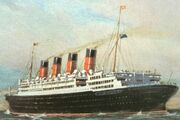
Aquitania during it's sea trials
The ship was made in conmemoration of 100 years of Aquitanii presence in the NATO federation and also for the consolidation of Hohensteinburg and Prussian Domination over the other Aquitanian States. The ship was constructed in accordance to the Second Industrial Revolutionary guidelines, "Greater Extent Style" at a time of Imperial Grandeur and Aquitanian domination, where ocean liners where at their full luxurious extent, a time and memory the Hohensteinburg King, Wilhelm the Prussian, wanted to relate to his rule.
The ocean liner departed to make it's maiden voyage from the port of Savoy on April of 2928 bound for Azurnereich, the passenger liner carried close to 4,500 passengers and 1,000 crew from around many NATO countries for the ship made make several stops in ports of call while on its way.
The ship arrived at Azurnereich in time for the Azurni Great Wolfgang celebrations and the passengers could stay in port and country, enjoying the legendary celebrations.
The Prussian royal family booked a palatial state cabin on the ship along with many many nobles and foreign officials, adding significant importance to the ship, which was designed in accordance to steamer ships from the 20th century, characterised by their great opulence and luxury.

SS Aquitania at Savoy
The ship sailed from the port of Savoy April 14, 2928, with thousands of spectators applauding and bidding their relatives and friends farewell. The ship nearly collided with MS Cardania when the latter made a mistake and passed the SS Aquitania on its starboard side, but the steamer continued and two hours later, it was steaming in the Nassau-Palms ocean. The ship carried 2,000 passengers.
By April 27, it arrived at the Republic of Kaput and boarded a total of 900 passengers, mostly Kaput but a significant population from other NATO nations, the ship was leaving port when it lost a propeller blade and repairs delayed the departure for April 28, after repairs, the ship was sailing for the Republic of Stritch with 2,900 passengers on board.

Docked at Stritch
The ship sailed and cruised along the beautiful ecuatorial coasts of Hercula Major and Lynx Minor, a time for large activities for passengers on the ship and on special beaches. By May 30, the ship finally went into port at the Republic of Stritch, the ship received 1,500 passengers, mostly Stritchan and Constantinians, while docked, the ship's funnels were repainted fully black to supposedly reflect warmth to the passengers in cold seas. The ship was departing when it collided with a rock by accident, arousing the suspicions of the skeptical on board and remained in port to be repaired. On June 4, the ship finally sailed for Azurnereich, a voyage that took 5 months to complete, specially due to the drifting ice from the north.

SS Aquitania sinking
The ship left Aorta, Azurnereich, December 3 2928, headed for Savoy, Prussia when it was torpedoed off the Azurni coast, the unidentified submarine launched two torpedoes, both hit on Aquitania's starboard side. Immediately after, the ship began listing heavily to starboard, difficulting the launching of boats on both sides, the starboard boats had separated away from the deck, making it dangerous to board, while the port boats could not be lowered due to listing.
The impacts were severe and panic was rampant in the ship, this made it impossible to load passengers into the boats, to make matters worse, the engines were running, forcing the officers to wait 5 minutes for the ship to slow down and start lowering boats. The officers sometimes lost their grip and the life boats crashed into the ocean, overturning them at times. Panicked people below decks were lost in its bowels amid the confusion and went down with the ship.
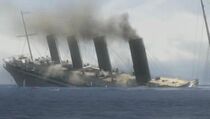
Picture taken from a nearby rescue boat
Only 5 life boats out of 45 were lowered succesfully, 12 went down with the ship and the rest were overturned or swamped, one was reportedly destroyed by the running propeller, which at that point was raised out of the water.
3,980 people lost their lives, out of 4,400, including the King Wilhelm Hohensteinburg of Prussia and his eldest son, Wilhelm Augustus, among other foreign officials and famed people.
The captain perished when the forward funnel collapsed over him, among other victims who died when crushed under the weight of the other subsecuent funnel falls, the ship had a total of 4 funnels, all fell during the sinking.
Among the survivors in the 5 lifeboats and sorrounding debris were Queen Katherina and her son, Alexander Hohensteinburg, last remaining heir to the Prussian throne.
The disaster received help from Stritch and other countries around White Giant. Most passengers were foreign and originiating from the Republic of Stritch, the Kingdom of Constantine, Azurnereich and the Republic of Kaput. The fact that boats had to be lowered manually drew intense criticism to the Ship building company: Wolfgang-Kreiss AG.
UKO
Prussia joined the UKO in the year 2931 and now participates in cooperation with the Grand State of Monto and the Kingdom of Constantine.
2935 Nuclear Scare and War of the Rebel Stritchans
The conflict began with a protest outside the Prussian Embassy in Darongo, which ended in it's closure, evacuation and destruction. The War of the Rebel Stritchans, also known as the "Quick Wars" was a war that lasted from December 23 2935 to December 24 of the same year, it began with a successful coup of Rebel Communist forces to the Stritchan Parliament. A NATO Summit in the city of Savoy was being held at the moment and quick military intervention was possible, Prussian and Montan forces arrived 12 and 15 hours respectively after the Coup. The "rebel communist" revolution took most of Stritch and the capital, Darongo. 12 hours later, nearly 1,700,000 Prussian troops were ready to invade in the South-Western Front and 15 hours later, 75,000 Montan troops were ready to act in the North-Western Front in the city of Lucy Hills. Prussian forces began to invade Stritch around 11pm December 23rd, liberating labor camps, towns and a city while on it's march to Darongo. The Rebel Leader, in a desperate attempt to stop the forces, ordered a nuclear strike on the outskirts of Darongo, the Prussians, which intercepted the message, had 15 minutes to seek refuge in the elaborate and numerous Stritchan civilian communal bunkers and camp underground shelters, reducing casualties to 120,000. In a few hours, with fallout and radiation suits, the troops reached and sieged the city for a few minutes and then entered and rescued citizens and documents from government buildings and the Prussian Embassy. The invasion of Darongo culminated with the raising of the Prussian Flag in the Stritch Parliament building and retreating to the Empire of Daltona in the south after 5,000,000 rebel and communist troops were reported to be headed for Darongo. Montan troops evacuated from their northern front and defended Prussian troops from air attacks by shooting several planes down with their own airforce.
The Nuclear Scare
The Stritch rebel leader demanded that Prussian and Montan troops leave them be and threatened Prussia with a nuclear strike, which was launched but taken down by Anti-Nuclear batteries. The SDI System of Prussia then threatened to bombard Stritch. By the morning of the 24th, SDI Units began launching EMP waves, disabling all electical devices and rendering them useless -"The thing that will cost them more money after this war is, rather than fixing buildings and streets, is to fix their burned devices"- Prussian General Haklford von Deuberg. The rebel leader then threatened to launch 500 nuclea missles to Prussia, all launched were shot down by the SDI units, and the actual number of warheads launched is unknown.
After the situation, Monto forced a ceasefire between Rebels and the Prussian-Montan Coalition. The nations, which include the Stritch Republican Loyalists, the Grand State of Monto, the Kingdom of Prussia and the Rebel Communist Stritch are negotiating a peace treaty as of 2936.
In May 2936, after news that the rebel leader was sending thousands of people to labor camps reached Konigsberg, the High King declared war on the rebel state and invaded and occupied the southernmost city in the country, in a few months, a coalition with the Stritchan loyalist army and help from the western Empire of Daltona recaptured and restored the Stritch Republic.
The Green Tide
Knowledge of the terrorist group "Green Tide" first came to light when an unknown destroyer bombarded the city of Königsberg, provoking light damage and several injured people. The Royal Marine-Korps pursued and sank the ship off the coast of Highpeak.
The Green Tide reportedly took responsibility for the attack and then threatened and attacked the Constantinian Vista International Airport, killing 15,000 people after using a toxic biochemical weapon which causes a quick and violent death.
Prussia immediately declared war on the Green Tide followed by the UKO.
Recently it has been discovered that the biochemical weapon that is used by the terrorists mutated and is highly contagious, it is estimated that an additional 5,000 people perished indirectly from the events of the Vista Massacre from the handle of bodies or the simplicity of being present in a room near the infected corpses. Prussia was alarmed from such discoveries and has organized many Infection Drills and has put the Epidemic Warning to level 4.
Nevrodnian Scandal
The Nevrodnian scandal began in 2943 and ended in 2944. Several governments accused Nevrodna of contacting the enemy and so blamed it's government of treason. The Nevrodnian Government decided to raise taxes for Stritchan airplanes and citizens who visited the country and so, Prussian airlines Avalen and AQUnited decided to take advantage of the situation offering lower prices and more flight to the region. Prussia had previously declared neutrality in the Stritchan-Nevrodnian issue and could not control what the national airlines had peacefully taken advantage of. The Nevrodnian government acted with aggressivness banning Prussian flights and raising takes for Prussian citizens. As the issue escalated, Prussians were evacuated from Nevrodna and all Nevrodnians were evicted from Prussia, except a handful who failed to evacuate on time. In the event known as the Rage Massacre, several Nevrodnians were killed by an angry Prussian mob who accused the victims of treason and affiliation to the Green Tide. The event inflamed Nevrodnians and they began to hold other foreigners in their lands as prisoners. Prussia did the same in retaliation with the support of Megnotata and Stritch.
In a planned scare towards the government of Nevrodna which was threatening with military mobilization, Prussia announced that it had executed several Nevrodnian citizens. This announcement enfuriated Nevrodnians and caused negative response from the Montan Government. Prussia later announced that it was only a planned announcement and no citizens had been executed.
The event resulted in permanent civil Prusso-Nevrod enmity and a notable Prussian enmity towards the Montan people and government which ended a a decade later. Prusso-Nevrod relations remained stable but Prussia broke diplomatic relations with the Montan government and forbid Montan entrance to Prussia for a whole century. The Sandiran law though was abolished a few decades later, lifting the prohibition, satisfying the already boombing friendly relations between the Montan Union and the Kingdom of Aquitania towards the end of the 30th Century.
Prussian secession from the UKO
In 2944, with growing enmity against Monto, a Referendum of Advise was issued in the Grand Prussian Assembly to vote on a possible secession from the UKO. The referendum was rejected by an incredible difference of one vote, a situation never seen in Prussian or Aquitanian history. Further referendums will be held to dispute the issue correctly.
In November 9, 2944, Alexander II announced the withdrawal from the UKO among cheering Prussians and diplomats. The monarch also announced that it will join the new federated empire that is currently being planned with the Union of Bandok, Tevron Confederation and possibly the Haven Kingdom which are new members in the world and acquired a liking to the UKO.
Re-entrance to the UKO
In the year 2945, Prussia returned to the UKO after foreign pressure succeded.
GDIV1 Outbreak
On June 5, 2945, at around 10pm, a jetliner coming from UKO Hope Colony successfully landed at Westlaire International Airport in the Duchy of West-Aquitania. From the Avalen passenger jet emerged tourist and businessman Victor Salinas, apparently of spanish speaking parents. A day later Victor was placed in the Intensive Care Unit of the Westward Aldone Hospital in downtown Westlaire, where he reacted strangely as the unidentified virus spread through his neural and circulatory system. The patient was described as "Quickly loosing sanity and control, aggresiveness is intensifying as the minutes pass". When after a few hours on June 6 several nurses were displaying signs of the unknown virus strain, the virus was labeled highly contagious and the nurses were put on a quarantine.
The PHDA got involved and determined that during the break the nurses had gone to the city, contact with the population was grave and that had effectively happened. In the hospital, sudden chaos erupted after - "A patient stained with blood was running around attacking doctors and other patients, it was horrible, I managed to leave on time before they quarantined the hospital, it was savage and violent, I have never seen such a traumatic event since the Green Tide Bio Bombings..." - says an evacuee. (Continued....)
Higher Age (2945-3030 AB)

ONI building at Ostenhertz, an example of UKO Architecture and inspired by the New UKO Quarters in Savoy
The Higher Age of Architectural and Technological achievement was sparked by UKO colonialism and other factors. Previously, the highest example of Aquitanian architecture and technological advancement was the impressive Savoy Skyline. The founding of Ostenhertz is commonly thought as the beginning of the Age, where incredible and radical white buildings rose in the middle of wilderness. The Aquitaines who built the City of Ostenhertz and the other nearby cities refer to the architecture as "UKO Architecture". With the boom, many cities around Aquitania and the UKO are adopted the style.
The characteristics are white tall buildings with an organic-curvy look, sometimes adopting symetric styles, the use of a lot of glass is common on these buildings.
The Major Prussian Reform
In the year 2950, the Advisory Referendum Court passed an act to change the name of the country from Prussia back to its historic reference, Aquitania. The Act passed and was approved by the King, officially ending the Prussian Kingdom and starting the Kingdom of Aquitania.
Plasma Particle Usage

Lancester Motors CLH-Luxor
With the introduction and new usage of Plasma Particles as Fuel, vehicles no longer give out harmful emissions to the environment. In the year 2950, several researchers proposed the flying car, but it was rejected by the Administration Board of Aquitanian Public Transport and Safety (ABAP) for safety regulation reasons. "The 30th Century will remain on its wheels and safely on the ground", says ABAP Director Henrich Stretten.
The ABAP has also demanded all vehicles be Plasma based by the year 2955 in accordance to the Environment Regulation Laws of the 25th Century. Vehicle Companies like the Aquitanian Lancester Motors company has focused on more luxurious and evironmental vehicles that enjoy state of the ark technology.
Space Advancements

MSS Preussen and MSS Revenant Hovering over Savoy
In 2948 a space tether in the Aquitanian State City of New Highever in the UKO was announced, built and finished by the year 2954. The first plans for space destroyers and cruisers were coming out of the planning boards and being materialized into the new shipyards, with the discovery of the new moon, the space tether was expected to enrichen the City of New Highever and it certainly did.
In the year 2952, 20 Extraplanetary Naval Vessels were launched, two CSC-Supercruisers: MSS Revenant, MSS Preussen and the CEND Battlecruisers compromising the rest of the fleet.
The ships were released from the Savoy Shipyards in the year 2952, as of 2982, the fleet of Cruisers amounts to 120.
The ships are heavily armed and use solar plasma particles as fuel, they are designed to operate in this single solar system, further expansion to neighboring stars is expected though. Shields can withstand the power equivalent of 2 nukes (CEND-Battlecruisers) and 4 nukes (CSC-Supercruisers).
Central Mountains Discovery and ONI Coverup
After the discovery of ancient Vladehorn Underground Roads, archaeology teams came upon a strange complex of underground abandoned ruins in January 2951, "They didn't look ruined to me"- Says Expedition leader Albert Gälenberg. After the discovery ONI teams stormed the undergrouns roads and closed the compund and expedition. ONI allowed the expedition to continue west and towards the surface, but the strange complex remains a mystery and another of the countless ONI coverups.
The Chimera Encounter
In January 2952, three Aquitanian Savoy Class Battlecruisers encountered aggressive alien warships near planet Aries. The ships engaged the three Aquitanian cruisers that were in an expedition mission, the Savoy Class battleships responded by returning fire, after managing to disable one alien ship, the three battlecruisers made emergency jumps into subspace, escaping the engagement, destroying two alien ships and indirectly damaging Aries' surface and atmosphere in the process.
After the event, the Aquitanian Government learned the attackers were an alien species called the Chimera, King Alexander II declared war on the decaying species a few days later. The war resulted in several civilian losses in the City of New Highever and in the Space Tether. The Chimerans have not been seen since.
Hermantine Citizens in Aquitania Rejoice
The surviving Hermanian Citizens that arrived after the fall of Hermantine celebrate the foundation of their sovereign nation East Heaven Kingdom in White Giant. Thousands of Hermantine Citizens packed and headed towards their homeland in the far north.
Napolette Annexion
In the year 2957, the Kingdom of Napolette, previously in "Personal Union" with the Kingdom of Aquitania, was formally annexed by King Alexander II Hohenstenburg. The Napolettan citizens were indifferent as they shared their monarchy with the Kingdom of Aquitania in the past. The Duchess Charlotte I, previous Lady Marshall of Napolette, was crowned by King Alexander II as a Duchess, she continues to administer Napolette to this day.
Sandiran Law Abolished
January 20, 2959 the King, supported by the Hall of High Commons, abolished the Sandiran Laws, which proved to be primitive and uselessly Orthodox. The people opposing this act were mostly nobility of ancient families, arguing that it would destroy a millenium of tradition. They came to reason and eventually supported the Act. The Advisory Referendum passed and was accepted by Alexander II, officially eliminating countless laws.
2970's Expansive in the UKO
By the beginning of the 70's, the Kingdom of Aquitania annexed the Meiji Territory which was previously a Protectorate of the Kingdom and was renamed the "Province of Meiji, of the State of Aquitania". Even though the "State" is part of the State of Aquitania, it has its own vehicle license plate style and document issuing.
The province was then declared sovereign of the State of Aquitania but a part of the Kingdom, Cairstadt followed this action and declared itself an individual State. Together the three States formed the Lusitanian Confederation of the UKO.
Since the end of the Second Great War, Aquitania has developed the infrastructure of the Meiji Region, now "State of Meiji". To date it is highly developed and since the Aquitanian Officials strived to conserve the regional cultural values, it has a high cultural index nearly comparable to that of the Aquitanian Standard. The Aquitanian State outlawed the practice of Calzador Customs and Cultural Atrocities and so the Culture of the Maiji State is preserved free of Calzador Influence and Moral Degradation.
2980 Flag Reformation
In the year 2980, a new flag was designed for the Kingdom, changing lightly: Deeper but same colours, removal of black colour borders, change of the central emblem from two lions to an eagle and the finer finishing.
The Flag was raised for the first time in the year 2983 on the Castle Kahltfork grounds, while the Hohensteinburg Royal Family, accompanied by the Souza Royal Family and the Emperor Sephiroth, dinned nearby as they observed the flag being raised.
2982 Withdrawal from the UKO
Following the Montan withdrawal, the Aquitanischen Außenministeriums (Aquitanian Foreign Ministry) took advantage of the situation, accurately thinking that there would be less probability of a UKO Intervention without the Montan Union in it. Following debates and a Referendum in the Lusitanian Confederation, the Aquitanian Kingdom fully annexed the three States and declared its withdrawal from the UKO, after nearly fifty years of mutual cooperation with the other member States.
2983 Aquitanization
The 2983 Aquitanization resulted in the changing of the names of several cities around the Kingdom, to more Aquitanian sounding names. The process was a annoying to some citizens, already used to the long standing english influenced names. The Western Mainland was completely Aquitanianized by the end of the year.
2982-2990 Lead on NATO Reform
After the failure of the 2982 Elections, Aquitania proposed a complete reform of the Government System, the establishment of a Judicial Court Assembly and with the valuable ideas of the Montan and Brunswick Governments, the decentralisation and democratisation of NATO, democratisation was implemented to new levels, direct votes for every single proposal in NATO. While in the last years of Aquitanian Marshallship in NATO saw new ties with Federations and a more active Foreign Policy, entry of new active members to NATO and the important factors now shaping NATO.
In the year 2989, elections were held for the first time, with the Cabinet elected by the summer of 2990 and the Marshall in office by the same time. Marking the activity, cooperation and fast reform that NATO had accomplished in years.
2991 First Live Mind Cloning in the World
Dr. Anne Catherine Kirössen, Head of ONI Protocol 0, managed to transfer her conscious mind into her already cloned body when she was in her death bed. The 134 year old famous Hermanian-Aquitanian woman, known for her intelligence and the fact that she looked like a 50 year old at age 90 died February 12, 2991, but after an artifact she had designed transfered her "Subconscious" to her awaiting cloned body, she revived. The Ministerium für Statistik und Standesamt (Ministry of Statistics and Civil Registry) are not sure if they should revoke her death certificate, or enter a new Birth Certificate into the Königlichen Amt Archiven (Royal Office of Archives). A massive debate on this issue was requested by the Ministerium für Statistik und Standesamt to be discussed in the Königliche Aquitanischen Montage (Royal Aquitanian Assembly). His Majesty the König though, approves and cheers her "transfer", but immediately after, the Royal Dyrant Court, Hall of Bannorn and Hall of High Commons made the King swear that in the name of Aquitania and the Hohensteinburg House, that "he would never desire a similar procedure for extended rule and that his Majesty ensures his crown is passed accordingly".
When asked if she would keep her hundred year old age, the Physician and Inventor responded: "Of course not, I want to be 21 again, being asked what my age is and responding 134 is ridiculous... *laughs*".
2998 Queen Pauline's Assasination Attempt - 2998 Serbian War
On January first, while visiting her brother, Emperor Wilhelm I of Lusitania, Serbian Nationalist, Anti-Imperialist and Green Tide Terrorist shot on the Queen's vehicle, killing a lady in wating of Her Majesty of the Northern Kingdom, which was sitting beside the Queen Consort.
The Terrorist was captured, questioned, where he revealed the assasination was a Serbian Conspiracy to cause a Norte-Lusitanian War and he was later executed. The criminal was executed in the exact moment when war was declared on Serbia. Lusitania and Wilhelm I accused the Serbians of sheltering, encouraging and supplying them to fight the civilised nations of the South Centura Donna Peninsula.
Lusitania invaded with 2 million troops from the east, no more, the objectives are clear, conquering east Serbia and the northern coast of the Serbian Republic as well as destroying the Green Tide Cells there.
3028-3030 Aquitanian Hyperinflation
The steady decline of the Aquitanian Economy ever since the 2960's peaked when in the year 3012, foreign money had to be borrowed to sustain the already faltering financial situation. The effect was a gigantic devaluation of the Kritine to the point where a Glass of Beer cost 6 Billion Kritines. The effect ended with the Revolutionary Outbreak, Coup and the full banning of the Kritine, marked by the arrival of the Bundesmark.
3030 Republican Insurrections
The monarchy has been increasingly threatened by the new Republican Fractions that are emerging quickly in the country with the desire of reform, the old Aristocratic System is failing for the first time in 2600 years. King Wilhelm III and his family has taken shelter in Ostenhertz, Lusitania until the situation supposedly calmed down. The situation though, in addition to the Hyperinflation, just accelerated the Revolution, which just toppled the Government in one move within the Royal District of Königsberg itself. A Federal Republic was declared and the Republican Age began.
Third Imperial Era (3030-3375)
The Third Imperial Era evolved from an initial fervent anti-aristocratic, hateful movement against the Status Quo in the early 31st Century, to a society that incorporated values of both the new and old, were loyal to the Imperial Rulers and idolised the Imperial Family. During this period, the country shifted to its current form of government under a partial absolute monarch. The age was born out of the democratic and republican movements throughout the nation in a period of 30 years, from the 3030 Proclamation to their decisive end in one of the deadliest conflicts in Aquitanian History: the 3060 Civil War. The years following saw a gradual restoration of power in favor of the Imperial Family and diplomatic consolidation of the nation and its federation in the world stage, followed by two world wars and the country's slow decline and stagnation, concluding with the Blight from 3370 to 3375, decimating the population and forcing millions to leave as refugees.
First Century
3030 Proclamation
The republic was declared by David Krössberg in November of the year 3030 AB, the Royal Family was allowed to remain, retain their titles and their homes, but at the cost of their sovereign title of "Heads of State", which is now held by the President or Chancellor.
The Aristocratic Titles were abolished, causing thousands of Nobles to flee to Lusitania in order to retain their honour. The Government is in a state of crisis as it organises and establishes order.
Following aggressive response from Foreign nations, the Kanzler-Präsident abolished the monarchy completely and named the Aristocrats Traitors in fear of an organised coup lead by them. Many Grand Dukes, Duchesses, Arlings, Barons, Lords and lesser Nobles fled to the East Heaven Embassy in Savoy, which was sheltering Aquitanian Nobility and giving them asylum. Some travelled to Lusitania in clandestine voyages due to the fact that Nobles could not leave the country legally. All noble families returned to Aquitania by the year 3135 after the decline of fervent Republicanism in favour of the Imperial Family.
The Imperial Family was allowed to return in the year 3050 under Kaiserin Maya Elisabeth I and throughout the following decades and heirs, slowly regained popularity and influence in their country's affairs.
3035-3045 International Issues
Significantly damaging scandals and International Incidents lowered the diplomatic traditional standing of the Federal Republic of Aquitania. After the events, USS-IOM activities were permanently seperated from ONI directives to prevent National diplomacy to be entangled with USS diplomacy and Foreign Relations. The growing and friendly relations with the UCM were permanently soured by events included in this period as a result of misunderstanding. Relations with the People's Republic of Ontario began to decline on the onset of the 3010's and then suddenly plummeted in the 3030's. The issues were due to constant Ontarian dispute and lashes against Aquitanian management of the USS-IOM, or the Intelligence Ministry of the United Sovereign States. Not to mention countless disagreements and different points of view, culture and behaviour of the people and leaders of the respective nations. In the years 3043 through 3044 the relations relaxed, but after insulting rhetoric in the end of the year 3044, the Aquitanian Government reacted a few months later in the year 3045 as in the following report: The Bundesbotschaft in Ontario, which is situated in that country with partial official Aquitanian titles closes today, January 28, 3045 after general Aquitanian Masses and Government were insulted by the Ontarian statement showing misjudgement of a tradition of excellent collection of Foreign Intelligence and Policing. The Ontarian Embassy in the City of Savoy was forced the next day, January 29th, to close by Aquitanian Federal Officials, the Ontarian Diplomatic Staff were all given Tickets in First Class and sent home immediately, the Embassy building to be converted into a new, modern and lavish Hotel to be called the "Federal Excelsior Hotel" service which is allegedly needed in the Embassy Sector of the renowned City for Diplomatic envoys arriving to meet the Kanzler-Präsident. The Aquitanian Foreign Minister is sure that the Ontarian Government will react with either further rhetoric and insult or with retaliation in similar matters and recommends the Aquitanian Foreign Policy simply disregard any Ontarian Communiques that aren't worth Aquitanian Time or that interfere in USS Federal Affairs and Public Order.
International Resolution
In 3045, after a message of misunderstanding explanation, Aquitania proposed to re-open both embassies, with Ontarian agreement, the re-opening was achieved in December 3045, ending the Decade Long International Issue situation. "After 3045, Aquitania will be looking forward to repairing the fixable relations damaged in this period" - Kanzler-Präsident Philipp Bauer. UCM relations remain unchanged since the Forum Incident and lash.
3049-3051 Recession
The influx of more than 3 Million foreign Aquitanian Nationals, which were seeking to re-enter their country permanently, saw major strains on Infrastructure, a rise in Unemployment and a plummeting of the GDP per Capita. The changes though "Are only Short" and this influx, which was accompanied with the creation and inauguration of 5 new corporations will boost and correct the short crisis, which was straightened up with Stagnation in the year 3051, thus ending the Three Year Recession. The recession was extended thanks to the Savoy Earthquake and Tsunami the year it supposedly ended.
3052 Savoy Earthquake and Tsunami

Central Low Rise Savoy, 24 Hours after Tsunami, 2 Storey Flood
On December 1st, 7:08am Western Aquitanian Time, a magnitude 8.03 Earthquake was detected on Savoyard Buoys exactly 30 seconds before it got to shore. Evacuation of Savoyard Superskyscrapers was slow and thousands failed to evacuate, resulting in the deaths of an estimated 35,000 people from the fall of 7 of these tall superstructures. Advisory AI Warnings from the City's superintendent were estimated to have saved 70,000 people. At 7:32am, a tsunami struck the coastal cities and towns; Savoy, Wurdennberg, Tirraneue, Dassbraun and Albrechten. Which were successfully evacuated minutes prior to landfall by each city's respective Superintendent and Authorities. The disaster was expected to extend and perhaps even deepen the 3049 Recession, something that did indeed happen when several corporations, factories and the Financial District of Savoy (Savoy Boardwalk) were wrecked or severely damaged. The disaster took an estimated 60,000 lives on the long term.

A Savoyard Alley near Bundesstrasse, towards the end of the Great Floods, City Damage was Widespread and Standards of Living were at an all time Low
Bombing of Strassburg 3054
The border City of Strassburg, in southern State of Prussia was bombed on February 13, 3054 by a lone man discovered to have been a Constantinian Ichiboro-Green Tide Extremist. The event caused the Strassburg-Constantine crossing to remain closed for 2 days, redirecting inter-border commuters to Lothringen, or other major and small border crosses. The bombing killed 8 people, injured 232 others and damaged the facade of the National Strassburg Library. The man, in his forties, crossed the border into Strassburg from the Kingdom of Constantine 5 months prior to the attack. Collecting the necessary items and ingredients for his makeshift bomb, the suspect proceeded to blow it up in Staatfurt Platz, in front on the National Library of Strassburg. Due to the commuting hours, the AI could not detect the bomb on the man's suitcase, which he left lying on the Sidewalk with the pretext of answering a phone call. The device blew up 15 Seconds after the man's departure, killing eight people and injuring hundreds others that were in the vicinity. The casualties were so low that authorities at first wondered how the Facade of the large building was damaged. Officials later reported that the exact moment the device blew was a time when commuting was reduced by the traffic light on the right side of the Platz, which halted pedestrians, turning a green light. Were the traffic light not there, casualties would have surged to over 100. The man, which name or nationality was not revealed to prevent an International Incident, was tried and executed a few days later. The bombing came at a time of major stress on the Aquitanian Nation, which was barely wrapping up the recovery from the 3052 Earthquake and Tsunami.
Bombing of Savoy 3056
The City of Savoy, the most populated City and Financial heart of Aquitania, had its famous Botschaftstrasse terrorist bombed by a group calling itself the Revanchists. The criminals, employing three vehicles encasing three Pulse-Damage bombs, blew the devices on three different points along the Avenue's length. Each bomb apparently specifically targeting one Embassy. The Ontarian, East Heaven and Ardglassian Embassies all were heavily damaged by the bombs, 2 floors on the Ontarian Embassy collapsing completely, the windows of the East Heaven Embassy blown in and then after effectively sucked out, only a portion of the facade in the Ardglassian Embassy collapsed. The effects of the bombs, remarked Pulse-Bombs, is blowing up, creating great pulses and a very large vacuum space, then sucking back to the point of explosion with great speed, in this case, the Back-Pulse (pull) created the most casualties. Most diplomats and guards, as well as surrounding vehicles and pedestrians were pulled into the explosion zone. Diplomats and Officers inside Embassies being sucked out through their windows and into the streets, entire walls collapsing outwards as in the Ardglassian case and column displacement (Ontarian Case). 236 Lives were claimed by the event, the most deadly and second terrorist attack in the Third Imperial Age.
Union Spring 3058-3115
The Union Spring is a period in the Union Federation's history that experienced a multitude of uprisings and coups in Allied Nations and Members, resulting in Coalition Interventions and the rapid mobilization of resources and troops, the events happening in a such a consistent and frequent manner had never occured before.
3058 Assasination & Coup d'Etat
Unexpectedly and taking the nation by surprise, on June 2nd, 3058, the Kanzler-Präsident was assasinated while visiting victims of the Savoy Bombings and inspecting the reparations. A man in his forties approached the Kanzler through the crowd, unseen. The man, an immigrant socialist revolutionary, fired his gun through a group of people, killing one and the bullet then reaching the Kanzler himself. His death was immediate. Following the assasination, about to be lynched amid the crowd, the man committed suicide by blowing himself up, along with 40 people around him, injuring 263 more.
The assasination caused utter chaos, as ONI discovered an overthrow plot that was widely leaked to the public, the Federal Cabinet asked for calm and for a day, the Bundeskongress entered sessions to discuss the future Kanzler-Präsident that would succeed Hans. A few hours later, a man from the Leftist Party in Aquitania, called Fuller Hoedkrieg addressed the Bundesversammlung, mentioning "Change" was inbound fast. Socialist Revolutionaries, in their entirety Immigrants, illegal in their majority, looked to Fuller as hope of being accepted into Aquitanian society, by means of great reforms on the country, Fuller though did not win the last elections and so planned to overthrow the Government, shortly after ordering the Kanzler killed. These "outcasts" quickly arrived to the gates of the Bundesversammlung, fully armed and without much resistance, after killing off the guards, entered the building, massacred the Bundessenatoren & Members of the Bundeskongress, not one was spared, except a handful... the Leftists under Fuller.
Fuller gained control of the nation a few days later, claiming he was the only survivor of the entire Upper and Lower houses of Aquitania, a story, authorities believed. The rest of the survivors and the rebels spread out immediately before authorities made an arrival.
3059 Escalations and Incidents
The Aquitanian Bundeskongress and Bundesversammlung buildings, housing the Lower House and both Houses respectively, burned down in supposed accidents on April 18, 3059. The current Kanzler, assigned to that position after the Versammlung massacre, declared emergency powers and dissolved both houses, blaming the Cultural Intellectuals of Aquitania for staging the fires and the massacre. The Aquitanian public though and ONI itself did not fall for such scheme, but with the army under Fuller's control, not much could be done. A peaceful protest followed on April 20, which Fuller considered a rebellion, all protesters were shot at Maya-Els Platz, which numbered in the 3,000 with children among the people. The shocked nation was alarmed and there are rumours of people planning armed uprisings, to which Fuller responded by placing military patrols in the cities, something unseen in ages past.
Wars of Suppression 3059-3060
With Fuller in command, he gave the order of anything related to the Cultural Past of Aquitania be destroyed, including thousands of families and intellectuals, who eventually went into hiding or were evacuated by the coming invasion forces, a Coalition, to capture Fuller and restore the Aquitanian Republic and Royal Family, which was by then ordered to be executed.
The Aquitanians though did not stand by the dictator and rebelled in their majority against him, only disadvantage being the superior and better supplied forces of the "New Order". Foreign Powers intervened in Aquitania after ONI asked for said invasions, knowing that the people would be defeated and the culture wiped out if left on their own devices. Still the war carried on with hardships, as each side engaged in skirmish battles and advanced over the other, to be pushed back again. The War Continues as of today.
Siege & Battle of Koenigsberg July 3059
The Battle of Koenigsberg, fought by Ontarian forces against the heavy garrison stationed there, included the Siege of Castle Koenigsberg and the rescue of the Royal Family by Ardglassian and East Heaven Forces, after which the Republican Aquitanians concentrated in assisting their allies in taking down the Koenigsberg Garrison and possibly capturing Fuller, which was at that city. The Battle was succeeding, but MSS Kapital, previously the Flag Ship for Aquitania, fired on its own Capital City by orders of Fuller, Aquitanians called the incident Die Kapital, Kapital... Ironically hymning the similarities of the of what levelled the Capital: A Capital, destroyed by The Capital. In efforts made by Maya-Elisabeth and her son, most of the Royal Possessions were evacuated from the Castle, relics and symbols, ancient and contemporary, were all recued from a pile put together by the New Order, awaiting to be burned, only interrupted by the Siege and Battle of Koenigsberg.
Coalition & Mountainious Bases August 3059
The Coalition Invaded in July, but by August, exposed allies troops faced a raining bombardment from the Great Outer Navy Defence Fleet. ONI recognised the old Bunkers and bases in the Central and Kahltfork mountains near the main focals and Strategic Points of the country as main hideouts and Headquarters for the Campaign, and so recommended the Coalition Nations retreat there, where suitable instalations, including docking yards for small transport air-ships was available. A significant amount of troops and civilians retreated to the mountain refuges, which acted as huge underground cities.
Collapse January 3060
Fuller was assasinated by Ardglassian Agents, in colaboration with ONI, ending the evil regime of the man who killed millions. With his death and no political or civil order what so ever, Aquitania collapsed as a State and is at the care of the Occupation forces.
Outcome

Frozen Savoy Subways Station Stairs
An estimated 20 million people died in the war, enormous damage to cultural and old structures, including the levelling of all Königsberg. The Main Cities were completely ravaged, infrastructure is completely reduced to nothing and the people struggle to survive while the Coalition establishes Occupation and Reconstruction Zones for the people.
Medium damage to the Western Mainland allowed for its swift recuperation and equilibration of the economy, which was heading for a Hyper-Inflation. The City of Savoy and the City of Königsberg were rebuilt, the Capital City still being worked on, as it was the most damaged of the country. The Eastern Mainland, the most affected region by the war, is to remain divided into occupation zones until future advise and efforts to restore order among the meagre population are being made.
Federal and Imperial Restoration
In the year 3062, the Imperial Family and the Federal Republic were restored, with the country making impressive improvements to its economy, thanks to Ardglassian Economists, the Aquitanian Financial situation improved to even be better than Pre-Civil War times.
The Imperial Family was restored, Prince Wilhelm Marik being offered the crown, but him declining and stating that his mother Maya-Elisabeth was still alive, being restored to her throne and guarded by the Royal East Heaven Guard, sent by Sacred Princess Mint herself, stating that Maya, was still a member of Clan na Colliete. The Grand City of Savoy was restored to its former glory by 3064.
3064 Federal Economic Reforms
The Bundeskongress, recently restored, passed a law as proposed by Kanzler Karl von Helggen that enforced all salary indexes in every corporation in Aquitanian soil be no lower than 450. Private Enterprise Corporations though were exempted from this law, allowing a salary of 300 or higher. The Federal Reform comes after large sums of national income, allowing such an increase.
Intervention in Ontario 3074-3077

Klasse 700B Howitzers Shelling Ottawa, Ontario, 3074
On December 3074, following the finding of the Aquitanian Ambassador to Ontario dead in the city of Ottawa, the Bundeskongress declared war on the Old Gods Regime, commonly known as Ontario. The Aquitanian army present on Foreign Borders nearby, stationed when the new Ontarian Regime burned down all Embassies in Ontario as a show of defiance nearly a year earlier, invaded in full force, totalling 33,000 Expeditionary forces, the army has in its posession the newly innovated and introduced Heavy Artillery, which are mobile and release immence power. In less than 5 hours, the new Aquitanian Klasse 700B Howitzer Artillery began shelling the city of Ottawa, awaiting Ardglassian Reinforcements at a distance from the City safe enough for the army to retreat where there be a counter-offence from the new regime.
Ontarian Government in Exile Protests Shelling (January 25, 3075)
After a month of shelling, the Ontarian Government in Exile requested the Shelling to stop, stating Collateral Damage and Civilian Casualties as the main reason. In reponse to the petition, AussenPol comfirms the following: The Battery is only ordered "The shelling of strictly military targets, not targeting principal civilian institutions, iconic buildings, highly populated or civilian shelters". Furthermore, Aquitania's Kanzler-Präsident had the following to say: "Storming the city and encountering resistance will shed more blood than can ever be imagined or shed by simply shelling specific enemy targets, Aquitania being a historically inclined nation will do everything to spare key historic or iconic buildings and civilian life, but the Shelling will stop until further notice or if petitioned by ally forces that will retake the city in the coming months" - Karl von Helggen, Kanzler-Praesident
Withdrawal from Ontario (3077)
The Aquitanian Bundeskongress decided to withdraw from Ontario when knowledge of Ontarian Troops intervening in Constantine reached Königsberg, outraging the Aquitanian nation when the Ontarian Loyalist troops should be fighting for their own country instead of irresponsibly invading foreign countries while their's was in the hands of a theocracy. Furthermore the event resulted in the near closure of the Ontarian Embassy in Aquitania and in heightened Anti-Ontarianism in the country, which resulted in several exiles and refugees to leave, mainly to the Ceres Autonomous Region in the South. The Anti-Ontarianism is a clear response to the Aquitanian loss of life and money in fighting for a country that not even it's Government in Exile is determined or has shown the desire, to save.
Boxer War 3077-3125
Following the Bombing of Friedrich-Linden Platz in Brandenburg, the Bundeskongress elected to intervene in the South, an action possible after the passing of the "Union Pacification Act of 3076" by the Constantine Government, allowing Foreign Intervention by Union Members.
Ardglassian-Union War January 3100 - January 3101
A sudden withdrawal and declaration of war from Ardglass against East Heaven and Benino triggered a Declaration from The Union and particularly Aquitania. At the time, the Federal Republic was restricted by International Law to directly involve itself in action, plus the fact that Aquitania had a minor force of 40,000 Troops at the time. The war ended after a Nuclear Bomb failed to explode over an Ardglassian Military Base, causing a surrender. The decision to utilise nuclear weapons to end the war "Swiftly and Decisively" came about by Kaiser Wilhelm IV's famous speech, addressing the Union's General Assembly as Marshall of the Federation, pressing the use of these weapons, to stop the economic burdens placed on Foreign Allies due to their help in the Financial Front and the loss of life in East Heaven and Benino. ONI decided that the speech, not recorded, be declassified as a greater symbol of determination. The war ended in a year, with the total unconditional surrender of Ardglass. A Treaty with conditions is to be signed in the coming months.
Reconstruction & Re-establishing of Relations 3101-3110
Following the war, diplomatic and economic relations with Ardglass needed restoration, emnity against the Ardglassians flourished to unseen levels since the Nevrodnian Scandal, which saw them banned from Aquitanian soil for nearly a century. Efforts to restore relations conflict with the Treaty of Savoy, which saw violations early after the war, prompting Aussenpol to delay the re-establishment and mutual exchanges of Embassies.
No incidents have been reported, as most people of Midan Origin were deported on the onset of war, though problems relating to Ardglassian Cargo and items have arisen:
On September 10th, 3103, Protesting Aquitanians in the Port of Savoy boarded a vessel with shipments of Fion Ban wine and threw them to the Harbour water, then realising it was better to smash crates rather than contaminate the Savoyard Bay, they proceeded to burn the crates. Stadtpolizei indeed arrived, but did not intervene in the destruction of the alcohol, which according to an Aquitanian "Is an insult to our Higher Grade Passed Wine". Anti-Midanism continues grown uncontrollably ever since the Ardglassian Diplomatic staff committed espionage and were executed.
Establishment of Embassies was culminated in the year 3107, ending major problems in the relation, proceeding with the societal programmes to end Anti-Midanism in the Aquitanian Realm.
Invasion and Occupation of Northern Constantine 3110-3150
After not having heard from the Constantino Government in five years, presumably because rebels severed the communication abilities of the hiding Government, the fact that the numerous sects claiming to be the Official Government were fighting and the refugee count and death toll was growing. Aquitania deeply concerned, in 3110, the Federal Imperial Government decided to officially intervene in the Boxer War that was raging in the South. On the early morning of May 7th, 3110, the Aquitanisches Heer 2nd and 3rd Armies crossed the Prutter River from Strassburg and Lothringen, the First Missile Division crossing the border south of Argensburg to assist in the Coastal Region. By May 19th, the Operation was a complete success, having encountered little resistence and occupying the historic borders of the Province of Lothringen, the Federal Government thought it wise to establishing a General-Government to provide Safe Haven for the Constantino Refugees. Aquitanian Imperialists see this as a great success to their cause: Re-establishing the First Aquitanian Empire.
The Historic Province of Lothringen was returned to the Republic of Constantine, leaving a very noticeable influence in the area, Aquitanian Architecture and City Planning, the narrow streets built in cities as part of growing slums in the 20th and 21st centuries were replaced with broad avenues and well built streets. Industry was encouraged and the economy regrew in the war torn territory. In a show of appreciation, the Constantinian Republican Kingdom offered to continue awarding Aquitania a section of the Lothringian GDP, but Kaiser Wilhelm V rejected the offer with thanks. Lothringen (Lurrania) is a major Ethnic Aquitanian province in Constantine.
The Great Cleansing 3118
Following a surge in Mafia Families intending to control and monopolise the introduction and marketing of illicit drugs, the Federal Government launched Operation Cleansing (Operation Säuberungen) in a wide operation to track and root out Mafia Families, their associates and other extensions. The Operation was called upon when the controversial murder of a 15 year old boy named Hans Waldersee was murdered by the bodyguards of a Drug Smuggler's child after "Hansi" tried to defend his family from verbal abuse coming from the 13 year old child. The Kaiser, compelled, called for the arrest and execution of the Smuggler, his family and the bodyguards, which were fastedly dispatched on June 3118. Marking the beginning of the Operation and seeing how those people, mainly of foreign ancestry, were a danger to the population and the values of the Aquitanian Culture, the operation went forward to find evidence and charge individuals guilty of murder, drug trafficking and the assisted or attempted versions of the latter crimes and execute them promptly. The Operation began with major raids in several cities. "The fact that they have mainly foreign ancestry and no Aquitanian Blood makes the Operation Easier, with the Public in unflinching support for the executions". - Georg Wolkenkratz.
Foreign Policy & Influence Decline
Aquitania, known from 2840 to 2965 as an active and diplomatically involved country, the Foreign Policy Leader of the Federation, began its slow slide down in the year 2965, upon the merger of the USS-IRP, known as the Unification, forming the "Union", Aquitania undoubtedly signing its fate as a declining diplomatic, international politician for the Federation. Several Foreign failures and crisis occurred after 2965, including the dissolution of the Union, the Union-BME Skirmish and the Wendy-Dynian Crisis. After the latter, Aquitania saw a permanent loss in its long lasting lead in the Union's Foreign Policy. Continuing its plummet as relations with foreign powers beyond and within the Federation began to sour and scar more deeply. Aquitania though, has come to accept this as a signal that it is time to withdraw from Foreign Affairs and become more committed to its Internal Affairs and more particular Treaties with individual countries, such as East Heaven, UCM, Constantine and Ardglass. Having both alliances and economic treaties with these countries alike and sharing historic and strong friendship.
Death of Kaiserin Maya Elisabeth the Great 3127
The death of Kaiserin Maya Elisabeth at 106 years old was a blow to the Imperial Image of Aquitania, as a symbol of Imperial restoration, the Imperialists and Monarchists took a low hit. Her death though was mourned by the entire country, being immortalised as the benevolent and matriarchal figure of the Federal Republic. Monuments of the Kaiserin are present in every city and places named after her abound. The Kaiserin is seen present day as the matriarch figure of the country, similar to how Johanna, the last Kaiserin of the first Empire, was seen for centuries after her death amid the Great Schism.
Second Imperial Century
3141 Keppy Conmemoration Service
The Federal Republic of Aquitania, notably Wilhelm IV, held a low key memorial service for the late great leader of the Soviet Federation and Kebir Blue in the historic town of Hailenberg, three hours southwest from the City of Koenigsberg. Leaders and Governments in the Union Federation that had links with the Volusian Confederacy or its preceding state, the Democratic Republic of Damstu; were invited to the service. Notable participants included the Imperial Union of Gaia under representation from the former Ceres Autonomous Territory, the Republic of Ardglass' President and representatives from the Imperial Union of Constantine. The memorial service included a meal for the people attending and speeches delivered in Keppy's honour. Half-Mast flags marked the country for a week. The service was small and posthumous compared to its equivalent arranged by Soviet Member States in Kebir Blue.
3143 Universali Embassy Negotiations
On the year 3143, some time following the Ascention of Kaiser Wilhelm V to the throne, the latter as first act determined Universal remove their Embassy from Aquitanian land following their disrespect of Aquitanian Sovereignity-in-Orbit. The Embassy was given 48 Hours to be dismantled or ceased by Aussenpol, to be then auctioned off to civilians of to the Federal Aquitanian Bank.
Following the deadline's announciation, the Universali Department of Foreign Affairs came forward to negotiate the possibility of re-establishing diplomatic relations. Universal followed a 2 hour short Aquitanian deadline from their land to be seized with an "Ultimatum" which proposed the Universali KES weaponry not disturb or breach Aquitanian Orbital Space in exchange for opening diplomatic relations or else "Face a complete break of Diplomatic Relations with Universal". The threat was enjoyed in roaring laughter by the amused Bundesversammlung's Session between the Senate and Congress, both sides of all parties laughing openly in television of the issued consequence should Aquitania fail to accept the "Ultimatum" despite Aquitania having absolutely no relations with the Unviersali nation whatsoever, and the fact that the latter was in Aussenpol's Blacklist. Aquitania rejected it, stating that the document did not incorporate the Imperial Sphere Union, an ally also demanding its Sovereign Orbital Space be respected. The Bundesversammlung drafted a Triapartite Treaty that forced Universal to accept the respecting of Orbital Space. In the end, the Union of Universal formally accepted it, later it was revealed that the Union of Universal claimed Aquitania signed and accepted the Universali Ultimatum, something that nearly caused a third and final break between Aquitania and Universal. Universal argued that each party would call the agreement what they pleased and Aquitania, hesitantly, in a narrow vote in the Bundesversammlung and a Kaiser passing the measyre grudgingly, approved the slow restoration of relations.
3144-3150

The third Space Tether on an Aquitanian Mining Facility
The later decade of 3140 saw a growth in Aquitanian economic assets abroad and within the country itself. The Aquitanian-Ardglassian Economic Cooperation Treaty finally saw greater profits by the end of 3148. Several other treaties, including the Orbital Security & Cooperation Treaty with the Imperial Union of Gaia, signed in response to a rapid Universali Militarisation in Space were also signed into effect in this decade. Joint Naval Drills and Maneuvers were effected for the first time in the year 3150 alongside the Imperial Union of Gaia to sustain each nation's Orbital Space Security from any foreign breach. Kaiser Wilhelm IV, one of the longest reigning Kaisers in the Aquitanian Reich, passed away in the year 3143, ushering a dark cloud of mourning on the country, being succeeded by his son as Wilhelm V. Colonial objectives in Mount Irvin were also shown attention during the 3148 Bundesversammlung Session, which included higher security measures and the finishing of a third Space Tether, a twin of an initial Mining tether, for the local Industry.
The decade culminated with a diplomatic spat on the Union of Universal's irresponsible war held with Kazan at the time. The Federal Embassy in Universal, being scheduled for inauguration in the year 3150, was delayed to 3158 or until the war ended. Aquitania found ridiculous the fact that the Universali Nation was using Kazan as testing ground for their new KES Weapons, which are a copy of the OBU System in the Aquitanian Outer Navy and then fabricating propaganda depicting humanitarian treatment of the Kazani Civilians. A famous article was highly spread throughout the internet and newspaper sources throughout the country following its release by AQTelekom's Koenigsberger Hohenzeit Edition.
AQTelekom posted an Inquiry to the Federal Defence and Aussenpol Secretaries on a February 18, 3149 Post:
AQTELEKOM - Königsberger Hohenzeit
According to an Official Statement by Aussenpol's Hans Fulk and other Officials in the same ministry; Inauguration of the Federal Embassy in Universal has been delayed due to Universal's ongoing war with the Kazan State and the false Universali Propaganda spread to favour their cause. Delaying has been considered up to the year 3158 or until the Unversali-Kazan War ends.
- AQTelekom: Why exactly is the inauguration of the Federal Embassy in Universal being delayed?
- Hans Fulk, Secretary of Aussenpol: Its quite simple Frau Hellinger; Supposedly trustful allies shouldn't be fabricating propaganda to justify war and then create even more lies based on the conflict. The effects on the innocent population whose nation was basically a lab rat to the newly released Universali copy of our OBU System are enormous, including disruption of the lives of children and their development"
- AQT Telekom: Speaking of the KES, Lord Karl, what is your opinion of it?
- Karl II, Defence: I have no comment, other than the fact that Aquitania has held the weapon system responsibly as opposed to its irresponsible use by the Universali Nation, considering time here is the most differentiating fact; Aquitania has had it for over a century, Universal just recently acquired it and is already blowing up people like it were a toy, this is precisely what happens when you hand a toddler a pair of scissors.
- AQTkom: With the delay, isn't Aussenpol disregarding the Tripartite Treaty or as called by the "One of a Kind friends" the "Universali Ultimatum"?
- HF: Of course we are, we are upholding the Treaty not a ridiculously weak ultimatum, the Treaty's terms though must wait, the behaviour of Universal is deteriorating again.
- AQTkom: What could be a possible response by Aquitania against further Universali Bombardments?
- KH: The most likely response would be the deployment of our KES System and the Navy to Kazan Orbital Space.
- AQTKOM: That is all we have time for, thank you Lord Secretary of Defence, Secretary of Aussenpol.
3162-Present Base Crisis
The 3162 crisis, sparked by illegal Constantinian Military Base building in Aquitania, was a request by the Imperial Government to the Constantinian Government to remove said structures and cease their activities. The Constantinian Government delayed the removal of the Hagen Naval Base at the mouth of the Preutter River and so escalated the situation, forcing the Imperial Aquitanian Government to issue a second petition. It was decommissioned in the year 3163 but reinstated a year later, prompting a third and final petition to remove it and the Benjamin Souza Airbase from Aquitania or an ultimatim would be forced. The tensions were reduced with the removal of the Hagen Naval Base, but slight but heading continues on the issue with the Airbase.
Occupation of Ardglass 3165-Present
Ardglass declared war on the United Empire of Pegersus in the year 3164, mid-Summer; ONI surveys, in close cooperation with the Ardglassian Secret Service, determined that Ardglass would win the war. By Autumn though, the situation was turned around, and Ardglass was in a dire state; three nuked cities and a land invasion eventually brought the Ardglassian nation to defeat in November of the same year. The Aquitanian reaction was of pure sympathy, people immediately gathering relief supplies to send to the struck nation. Reports of atrocities to Ardglassian Civilians and the death of all the Aquitanian Diplomats in the country sparked fury and the heightened production of propaganda against Pegersus. A shift in power was effected in the year 3166, the Mitten Empire had acquired mainland Ardglass and a rebuilding of the country was begun. The exiled Ardglassian Government though, still considers Ardglass to be occupied by enemy forces.
3167 Tension Rise
The year 3167 was marked with rare rhetoric from the blacklisted Universali Nation, which Aquitania has neglected largely because of the Blacklist Policy. The Republican Party of the Union of Universal heightened tensions by stating "harsher" actions were necessary against Aquitania, which has not bothered with the Union of Universal in nearly twenty years. The harsher measures included the implementations of Tariffs and Quotas on fabricated facts of supposed imported Aquitanian products "Which have been allowed to continue flowing into their borders with ease", depite obvious facts that Aquitania has placed an Embargo on Universal since the year 3150. After being countered with said information, the Universali Speaker for their House of Representatives voiced that a proposition to enforce a military blockade on Aquitania had been proposed and was being considered by the president. Following ignored warnings that if any blockade was placed it would provide a Casus Belli for Aquitania to declare war, the entire Home Space Fleet was mobilised and the Naval Fleet was readied for operation. Aquitania also scheduled War Exercises for the year 3168 with treaty ally Imperial Union of Gaia's Ceres Autonomous Region and an Imperial visit to Friedrich II's aunt, Serene Queen Morgan na Colliete to reinforce the special bond between Aquitania and East Heaven.
On April 22, 3168, the Union of Universal threatened outright war if its blockade failed, the Aquitanian Media described the Union of Universal's desperate measures as an attempt at having their nation be removed from the Blacklist they were placed in 3150. The Kaiser though, reassured them that it wouldn't happen and the blockade would not be allowed to stand by the closest Aquitanian allies and proceeded to insult the president of Universal: "Our allies would not allow your fictional blockade, now go play with the chimps. We don't like you, stop begging us for an embassy, the effects of your forceful blockade will be the same one that your "asset freeze" brought decades before, none. The Universalis live in an obsolete fairy tale world and the Republicans look great kneeling to us and begging for normalisation of relations and the establishment of an embassy, you'll need more of that foot kissing G-03152" - Kaiser Friedrich II. To great amusement of the Aquitanian population, the Imperial House earned 10 percent more popularity than the 87% it enjoyed prior to the April 22nd rhetoric, jumping popularity and approval to 97%.
Occupation of East Heaven 3171-Present
The Occupation of East Heaven by Pegersian forces was a traumatic event in Aquitania, where the second largest ethnic group is itself Oirthir and its citizens identify the nation as the closest ally of the Teutonic Nation. 92% of Aquitanians reportedly visited East Heaven more than once and 78% had atleast one East Heaven friend, similar statistics could be collected in East Heaven. The close relations of the two nations, both socially, economically and culturaly caused the 3171 invasion to send shockwaves across Aquitania, of surprise, unease, sadness and refugees. Aquitania received the bulk of the Oirthir refugees in the world, many coming here at the call of friends and family concerned for their safety after reported attrocities committed against them by Pegersians and the promise of a safe and friendly country. In the 3180's, after the invasion of Kaledonnien, many East Heaveners were sent to the new territories in order to colonise and populate the lands of the recently evacuated Bohemians along with Aquitanians, a lucky event which allowed hundreds of thousands of Oirthirs to find new homes in the Sieländ region, there, local governments encouraged the East Heaven minority to continue practicing their language, culture and customs, something that gave way to a unique region in the country. The mass of refugees strained the Aquitanian Economy considerably, with the employment and education facility crisis of the 3200's causing a Stock Crash and the Bundesmark to be buried forever. The country never stemeed the flow of refugees entering the country and the economy's plummet was halted, and maintained in a fragile balance by the Kaiser. Annually, Oirthir conmemorate the loss of East Heaven and the hope that they might one day recover it.
Invasion of Bohemia & Incorporation of Kaledonnien 3184
Background

Reichsheer Occupation Troops in Upper Sieländ, near Kattowitz, 3184
The expansion of the Aquitanian Realm to its 1912 Borders has been a controversial yet desirable feat among Imperialists and the Kaisers themselves since the 1925 War, but the situation was made difficult by several external and internal issues throughout the ages. The fact that the countries that would have their territory reduced at the expense of the new 2900's Expansionism knew that, made relations, specifically military difficult. But by the turn of the 31st Century, Aquitanian Officials directed their concern at a possible Viceroyal Expansion by the Constantinians and should that occur, it would "Inevitably lead to war [With the Constantinians]" - Wilhelm IV. Around 3170, the new Constantinian "Prank Border Festival" was not welcomed warmly by most Northern Aquitanians, in contrast to the response given by Strassburg, the largest border city with Constantine. The event was reportedly followed with repeated skirmishes with Bohemia, and the festival was what Aquitanian Military Officials saw as a distraction for an invasion, which prompted immediate mobilisation of the First and Second Missile Divisions, the 3rd and 4th Motor Rifle Divisions and the 1st Artillery Division to the Bohemian Border. The army was on orders to respond in case of a Constantinian Invasion and to take the City of Prague as fast as possible. Bohemia responded with two Divisions of its own and Defence Interceptor and Helicopter Wings to counter Air and Land attacks respectively moved near its border with Aquitania and a small token mobilised to its Southwestern border in case of a Constantinian Move. The Mobilisation Alert remained for 14 years largely unmoved, a period which is referred to as the "Second Prank War" until a small skirmish (June 3184 Balloon Incident) which left 3 Aquitanian Soldiers dead prompted Kaiser Friedrich II to declare war the following morning.
3190-3215
A period of decline followed the war with Kaledonnia in which the Aquitanian Economy hyperinflated, an employment crisis arose and a withdrawal from The Union was effected. The adverse events were reversed later when Friedrich II intervened in his government to fix the situation, Aquitania returned to The Union in the year 3206. The economy was stabilised (yet not recovered) and a new currency was issued to replace the weak Bundesmark, the Aquitanian Mark. Joffery na Sléibhte, a popular East Heaven politician in Sacred Princess of East Heaven and Princess of Savoy Tallisibeth III's favour was assigned as Chancellor to the Principality of Savoy in 3215, when his party, the National Imperial Conservatives, won the Savoyard Elections and proposed him to Princess Tallisibeth III as Chancellor and subsequently to Kaiser Friedrich II, which enthusiastically accepted his position in the Principality of Savoy, for the first time in Aquitanian History, a person not of Aquitanian Ethnicity and not born in the country held a leadership position of such magnitude. "The fact that he is Oirthir, (East Heavener) is of no surprise" - Kaiser Friedrich II.
3215-3230
Aquitania recovered from a double dip inthe world recession and the Government successfully restabilised the economy. In 3225, a protest in the city of Prague, Yutschenia, was peacefully dispersed by Imperial Authorities after the Imperial Government promised further autonomy for the Grand Duchy and the promulgation of acts protecting the Yutschek Language and Identity. Schools in the Duchy of Greater Yutschenia now teach both Aquitanian and Yutschek as equal languages and in a mandatory stance under the Mandatorial Act of 3226.
Third Century
Imperial Visit 3232

The Imperial-Basileus Dinner, 3232, Königsberg Schloss; Kaiser Friedrich II stands to make a Toast
In the year 3232; Kaiser Friedrich II, his son and heir the Prince of Prussia Friedrich Alexander and the latter's son Prince Friedrich Wilhelm; received the Ruthene Basileus, Theodoros I, in Königsberg at the Dyranttag. They later toured the capital with him, the event finalising with the Kaiser inviting him to sign the treaty binding Hellenia to the Union at the Königsberg Schloss. The signing was done over ceremonial dinner hosted by the Imperial Family and Reichskanzler Victoria Weisser and her kin, along with 50 other guests of noble and common blood present to celebrate the occasion. The visit by the Basileus was also intended as a symbolic gesture aimed at strengthening relations between Aquitania and Hellenia.
Council of Centau 3238

CC Complex, New Alexandria
The Council of Centau's foundation became effective in White Giant on June 20th, 3238; with Aquitania, alongside Gaia and Ruthenia, as founding states. The establishment of the interplanetary council was an early highlight to the Third Century of the Third Empire and was certainly one of the great achievements of the Third Empire since its elevation. Aquitania also had the honour to serve as White Giant's Centau Headquarters, which tends to planetary affairs relating to the Council and responds directly to the official Headquarters at Celestial City. The Headquarters of White Giant were placed in New Alexandria, after the Grand Duke of Alexandria, Heinrich III zu Kossel, proposed the city, which is constantly shrouded from the international stage by more popular cities like Savoy and Königsberg and is mistakenly avoided by tourists despite being one of the most ancient cities in Aquitania and the fastest growing in the Empire. The building complex has a total of 6 buildings, the tallest being 110 stories tall.
Naval Assistance in Arendale 3250-3255

The Imperial Naval Command issued most orders during the Arendaelian Crisis
The Communist Uprising in the Union of Arendale and its success after three years of war prompted Aquitania to intervene in the conflict, the Kaiser decided to limit the intervention to Naval Assets only. Part of the Expeditionary Fleet assisted Arendalian Loyalists and Monarchists with Intelligence Reports, Orbital Surveillance, Orbital Bombardments and Troop Transports. The fractured Expeditionary Fleet above Arendale got more involved in the conflict during its peak and the capture of Arendelle around the years 3253-54. Between 3252 and 3255, more than 150,000 troops were transported around the country and low caliber Orbital Bombardments were ordered a total of 50 times by land troops or by the Naval Command & Cabinet over Aquitania in White Giant. By the year 3254, the civil war had ended, and all Aquitanian Warships, totalling 30, withdrew by 3255. The conflict was small scale in the eyes of Aquitanians, with absolutely no loss of life or assets. Leading to widespread public support during and after the conflict ended, and huge opposition to the peace settlement that meant the NPA and other communist factions would remain in the country.
Bombing of Straßburg November 20th, 3259
Straßburg, the largest border city with Constantine in the Empire, had its Friedrich-Platz bombed with a Pulse Type bomb on November 20th, 3259 by an unidentified individual. The death toll reached 3,500 people as the bomb caused the collapse of one skyscraper type building over the remains of the Platz. After two weeks of clearing and investigation, the bomber was identified as a Constantinian, with tribal origins. The citizenship of the bomber did not cause any diplomatic issued with the southern neighbour, although it did cause Aquitanian sentiments to grow an anti-constantinian feeling afterwards. The bombing caused authorities of the southern boder to be more alert and have the crossing and the border be more heavily monitored. Vehicles and people coming from Constantine and holding a Constantinian passport are subject to more thorough checks and questioning.
Hightened Economic Cooperation with Ruthenia 3260-3266
After High level Government talks between the two countries and an extensive private and public discussion between both Imperial Finance Ministers, both countries agreed to promote mutual investment and further market openness to provide for that. Aquitanian Financial Officials worked with their Ruthenian counterparts to open up the Ruthenian Corporate Share Market and also to have the Ruthenian Economy invest abroad, particularly in Aquitania. By 3266, Aquitania owned an average of 26.67% of the shares in the three public corporations in Ruthenia, aiming at 40% total average for 3275. Aquitania also seeks to encourage the Ruthenian Emperor to press for more corporate public offerings and hightened investment abroad.
Economic Crash of 3266
A significant economic crash occured in early 3266, the crash was blamed on sudden shortage increases in key raw and manufactured goods on the world market. Aquitania's Chemical Industry and High Tech Sector were affected by the crash and caused severe deficits in Federal Income. The Crash caused Kaiser Wilhelm VII and his Finance Minister to issue stringent reforms and emergency stockpile supply delivery to the corporations affected by the Centau wide recession.
The short market crash was immediately followed by a boom unseen in Post-Union War Aquitania, a corporate boom was also experienced, raising the number of corporations over the amount before the Great War. Following the end of the war with Constantine, the boom was known as the Steaming 70's.
Aquitanian-Constantino War 3268-3275

Königsberg was Bombed Several Times during the Conflict - Wilhelmstraße, Osterhimmelstraße, Lisbethstraße - Union Platz, 3273
In the year 3268, Aquitania was invaded by Constantinian forces, which managed to encircle Straßburg, a major city in Prussia, while simultaneously controlling its surroundings and a large swath of land near the border. While the siege of Straßburg lasted well over a year, the tide of the war was turned when the Wehrmacht mobilised completely in the year 3270, the bulk being stationed in Jutland, in Ludonnia. The Constantinians were pushed as far as the historic border of Lothringen with Constantine, while naval forces attacked the major port cities of Eastern Constantine, including Nuevo Bayamo, which fell in the winter of the year 3270. While in Nuevo Bayamo, the administrative and financial capital of East Constantine, Aquitania rebuilt, enhanced its defences and renamed it Neues Bayem during occupation, the total military administrative area under occupation was referred to as the Reichskommissariat Neues Bayem. Lothringen was equivalently Reichskommissariat Lothringen. Neues Bayem fell to Constantine in the year 3274, after which the conflict was grounded into trench warfare and devastating bombings of major Constantinian cities by the Luftwaffe and several bombardments of Aquitanian cities by the Constantinians until the war ended in 3275, eventhough an official Cease Fire was ordered in December of the prior year.
Post-War Aquitania 3275-3300

Memorial to the Fallen 3268-3275, Heiligeskleinplatz, Old Straßburg
Aquitanians celebrated the end of the war throughout the entire country with great enthusiasm, as not only had the senseless and unpopular war ended, but Aquitania had gained the historic territory of Lothringen, land controlled by Constantine, but largely Aquitanian ethnically and a source of many disputes and conflicts in the past with the southern neighbour. Lothringen was under Aquitanian control when the Cease Fire came into effect and the sovereignty of the land was negotiated with Constantine. Eventhough the two countries have not signed a Peace Treaty, relations have normalised to an extent. Aquitania officially annexed the newly created Imperial Territory of Lothringen to the Empire in the year 3277, an action that was praised by Aquitanians on both sides of the former border.
The annexation was delayed due to it being conditioned by Prussia, which demanded land from Lothringen in the west, Prussia's proposal was in turn countered by Vladien, which stated that expansion was unacceptable, the two Federal States blocked the annexation constantly until Kaiser Wilhelm VII issued an Imperial Compromise. The Compromise rewarded Prussia with territory in the west and the city of Dottmund in the east over the river Preutter at the expense of Straßburg, which would be ceded to Lothringen and serve as its capital. Eventhough Prussia rejected the compromise initially, it was forced to comply after the Kaiser threatened to bring up the East Prussian Question issue to the Imperial Court of Justice.
Following the territorial settlement within Aquitania, the economy began to normalise, with the annexation of Lothringen, the empire gained 1,300,000 people, which entered the work force immediately. The reconstruction of Lothringen and major projects the Reichsautobahn, in cooperation with Aquitanische Bahn, launched there employed the new citizenry as the peace time economy and population adjusted to the fresh injection of people, which initially faced unemployment and uncertainty in the country that repatriated them. The situation was not getting better though, Constantine had withdrawn two corporations it had established in Aquitania prior to the war and the economy began to slow down by 3285. The West Republics planned to assist in the recovery of the economy by investing in the country and signing corporate agreements, several Westermanner Enterprises agreed to place corporations and factories in Aquitania following the agreements.
Fourth Century
300th Anniversary of the Foundation of the Third Empire 3300-3330
3330 marked the 400th year of the foundation of the Third Empire, Aquitanians in the country and abroad celebrated the momentous occasion for a week, with many Reichfests opening up, the largest one being in Kahltforenburg, the heart of celebration and culture. As is tradition, the elderly Kaiser Wilhelm VIII greeted Aquitanians at the Feldsmarschschloss' main Bridgeway and then set out for an Imperial Tour, the final destination being Kahltforenburg, as the Kaiser planned to award the city Imperial Status upon arrival, decisively separating it from the Grand Duchy of Alexandria, a Federal State itself.
The Kaiser toured the capital cities of all the Kingdoms and Grand Duchies and finally stopped in Kahltforenburg on the Summer of December 19th, after giving a speech detailing and upholding the uniqueness and importance of the city to the Reich, Kaiser Wilhelm VIII declared it an Imperial City, the first city with state status other than the capital in the history of unified Aquitania. Many in the nobility and in the political spectrum criticised the move: "The borders of the Imperial States are redrawn every century it seems, Arlathan is already drawing up laws to prevent any city, or piece of territory, from ceding, whether it be Witthag, or Arkadien, the latter which has high potential as the former capital of the Empire. Situations like those should be avoided, we should draw up guarantees to prevent being quartered by Königsberg, as was the case when we lost Straßburg to the Lothringians" - Karl Teuer, Prussian MP.
The Three Quiet Decades 3330-3360 Die Schlafen Dreißig Jahre
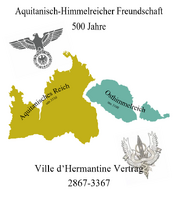
Promotional Posters appearing in the country ahead of the event
Following the 300th Anniversary of the Third Empire, the country's economic growth slowed, as did its involvement in Foreign Affairs. Following the collapse of the Ruthenian Empire, relations with the outside world, other than Constantine, the West Republics and a few Union nations, declined slowly until they ceased in their entirety. Due to the peaceful and relatively prosperous decades during the period, they were referred to as the Sleeping 30 Years, most likely in reference to the Aquitanian Eagle slumbering and taking a rest from the chaotic world of war and politics. Kaiser Wilhelm VIII died at 99 years of age in the year 3340, and was succeeded by his grandson Wilhelm as Kaiser Wilhelm IX. The new Kaiser's policies aimed to revitalize the economy and "wake the country up" as he said it in his own words. He also planned several events, including hosting one last Union meeting in Savoy and the commemoration of 500 years of the Ville d'Hermantine Treaty of Aquitanian-East Heaven Special Friendship, due to be celebrated in the year 3367. The commemoration is dedicated to the Oirthir Diaspora living in Aquitania and to their former homeland, the collapsed East Heaven Kingdom.
Austerity Measures 3358
As a result of the slowdown experienced by the economy and Kaiser Wilhelm IX's promise to revitalize and re-awaken the economy, Reichskanzler Frank von Korburg announced austerity measures in the form of salary slashes nationwide in the year 3358. Massive layoffs were expected after the announcement, as the Government tends to announce cuts prior to an economic crash, given that companies and banks were already highly suspicious of the slowdown, layoffs were very likely. However the Reichskanzler strongly discouraged the mass firing of employees, as those extreme measures would "destroy the economy" and asked employers for patience, promising the that the Government is looking at the long term rather than at any impending catastrophe, he further commented that employers would be saving money with this plan, making room for investment elsewhere. The measures took effect on the 1st of June, reducing salaries and wages by 30%, from an index of 500 to 350. Government wages were also cut back from 450 to 350, by 22.22%. A low level worker usually had a salary of 19,500 Aquitanian Marks, which translated to an estimated 25,000 Dolleuros (3358), the currency widely recognised internationally on the Centau System. With the new measures however, the same worker is expected to be payed only 17,500 Dolleuros, or an estimated 13,760 Aquitanian Marks (3358). The cuts are "blatant", as put by one furniture factory worker, but are urgent in the long term in order for the economy to spring forward. The plan is also expected to allow company growth and subsequent Public Offerings. The Kaiser, in a speech at an Industrial Complex in Prussia's Brander Basin, the second largest Industrial Region in the country, promised to restore former salaries in the year 3370.
UCM - Aquitanian Summit 3358
Kaiser Wilhelm IX and Emperor Derek of the UCM Empire held friendly and productive talks concerning World Economy, Centau Communications and Security in the first talks between the two countries' Heads of State in over 200 years. ONI briefed UCM's Emperor with some foreign intelligence while the Emperor's provinces in turn offered aid to counter the Aquitanian economic slowdown. The talks reassured the historic warm relations the two Empires have had even at times when each nation's Federations were perhaps at odds with each other.
Unknown Catalyst - 3370-3375
Fall of Alexandria 3371

Wehrmacht operating in New Alexandria prior to the January 15th Bombing
On early September, 3370, riots began to spring up in Waarburg, a town in the Grand Duchy of Alexandria, however detailed information regarding these were neglected by the Alexandrian Ducal Government, dispatching state troops to deal with the issue, which was largely considered anti-austerity actions in response to the continued stagnation despite their implementation in the year 3358. Experts were suspicious as the rest of the country was relatively peaceful and riots were rare, even in harsh times.

Port of New Alexandria, January 16th, after being shelled and bombed as part of the Containment Campaign
The problem attracted nationwide attention when New Alexandria declared a state of emergency as violence began to spill in to the metropolitan area's borders and into other towns in the state, the declaration was followed by another emergency declaration in the Duchy of East Lexus in December 29th. Königsberg ordered the Wehrmacht to mobilise and secure New Alexandria when the port became paralysed after a bomb collapsed an office skyscraper over a section of the port's waterways two days after the emergency declaration, the Dyranttag and much of the Bundeskongress viewed the problem in Alexandria as a ruse to invade Kahltforenburg and annex it, and did not trust the Duke, which by new years began asking Königsberg for help. After the calls for help, Kaiser Wilhelm VIII ordered a media blackout in the Grand Duchy, ending news streaming from the state to the rest of the Empire and the world. After the blackout, the Aquitanian Emergency Advisory System began issuing recommendations to the civilian population in Alexandria, suggesting "Immediate and Orderly Westward Evacuations", the same recommendations were given in eastern Wulffbein and Asterhein later in January 5th, 3371.
On January 8th, 3371, Kahltforenburg secured strategic entry points into the Kahlter Valley with checkpoints and fortifications, an alarming sign to passing citizens that times were about to get harsh, but also raising questions as to why fortifications were being built in the Kahlts, or why a Blackout in Alexandria was put into effect. Train service between Arcadia and New Alexandria was suspended on January 9th, five days after the AEAS issued its recommendation. On January 15th, artillery was heard firing towards New Alexandria, the reports came from refugees moving west, among the last to arrive in vehicles, as the Highway System had collapsed two days before due to overcapacity after AEAS' recommendation. Most of the evacuees opted to remain in Kahltforenburg due to its safety in the heart of the Kahlter Range.
Evacuations of Arcadia - 3371

An Arcadian street lies in ruins after the city fell to the Blight on January 26 (Arcadia Superintendent AI CCTV)
Contact with the Centau Headquarters in New Alexandria was lost on January 14th and a report broadcast that day mentioned that "the blight moved fast", this was the first time the rest of Aquitania heard of New Alexandria since December 30th, and this caused mass panic, specifically in the east, which was obviously more vulnerable to the blight. On the 15th Kahltforenburg was circumvented by the catalyst and overrun military checkpoints on the HA-6, the Luftwaffe responded by bombing sections of the Highway, taking advantage that they were elevated and the blight could not spread to the surrounding countryside, bombing of ramps proceeded immediately based on the "Delay Operations" of Herr Franz Wohner.
The Delay Operations, also referred to as the Wohner Operations, "prioritised the lives of those relatively far from the front lines, but relatively close to them" and at the time, Arcadia fell into that categorization and was therefore the focus of massive evacuations done in several phases over a few weeks. Given that Wulffbein was far from the blight and that most of the eastern seaboard had been swallowed, Arcadia had special symbolic significance to Aquitanians and the armed forces. On January 26th, amidst the impression that the blight had been contained, it began to spread in Arcadia during its 4th Phase of evacuation, only a third of the population remained and was lost to the catalyst. The loss was a gigantic blow to Aquitanian morale and it sped up the westward movement of people in Arlathan and Wulffbein, the only states that were affected by the blight and had not collapsed yet.
Asterhein was the only state to be evacuated successfully due to its sparse population and rugged terrain, which prevented the quick spread of the blight there. Several fjord settlements and towns in northern Asterhein remained safe from the catalyst even after evacuations were complete, however the Imperial Government ordered the rest of the populace to evacuate regardless of the status of these havens.
Fall of Wulffbein - Draken Holdout Line - February 3371

Fields of Kollern and a ruined Wulffbein on February 7th
Wulffbein's fall was the most unique and violent in the entire crisis, given that the plains of Wulffbein, particularly the Kollern Extensions, were an ideal environment for the spread of the Blight, which by February 6th, when the blight on the highway was thought to be kilometres away from the city and the Delay Operations were not even fully implemented yet, breached the city from several sides, coming in from the east, and the north, overwhelming all efforts to halt it. The event killed an estimated 800,000 civilians and 10,000 imperial soldiers, the casualties are thought to be a higher number, as the Luftwaffe firebombed the city 24 hours after its official fall. The fire spread throughout the Kollern Extensions, generating enough smoke to cover Awariss and parts of Vladien and Arlathan in partial darkness. Two days into the fire, the clouds could be seen in Königsberg, an event that would impact the capital's residents to the very end.
Pending...
Reclamation Era 3415-Present
The era of reclamation saw international attempts at restoring Aquitania in its blighted territories following the exodus in late 3375 after the fall of Weißhaupt and later the fall of Kahltforenburg in 3402. The first attempt by the Union of Universal and the Metudelian Empire in 3415 ended in failure when in 3437, a mutated blight spread and killed most of the population who had returned to recolonize the nation.
1st Reclamation 3418-3437
In 3415, Aquitania was occupied by a Universali lead Union coalition, which set up a Trust Territory (Union-Treuhandgebiet Aquitanien) overseeing the reconstruction of the Aquitanian Nation. From 3418 to 3425, Aquitania was primarily administered, overseen and protected by the Union of Universal. The cleansing of the blighted lands, with the exception of the east, was accomplished by Metudelan and Universali forces in a period of three years, after which repopulation and reconstruction began. In the year 3437, a mutated strain of the Blight appeared in Königshafen (Weißhaupt) and spread throughout the country, after breaching havens and by-passing Universali and Metudelian emergency protocols, the blight killed most of the population that had returned to rebuild the country from 3425 to 3435. Survivors escaping the blight after Union forces withdrew and abandoned them travelled east en masse to the former eastern territories and settled there, reclaiming some territory from the blight. Being mostly Universali, the east was largely anglicized by the english speaking survivors. In 3436, Metudela and the Union of Universal suffered outbreaks of the blight, decimating and killing most, if not all of those countries' population and eliminating any chance of a new intervention by a foreign power, as Aquitanian allies had been consumed by wars or the blight throughout the end of the 34th century.
2nd Reclamation 3440-3441
Fleet hailing from Kebir Blue carrying Aquitanians lands in Preutterdam, starts reclamation with rapid decontamination of major cities. Efforts are easier than in the first reclamation given the reduced population present during the second outbreak and the major sweeping efforts of the Union Coalition in the six years of the 1st Reclamation.
Consolidatory Period 3442-3504
Reorganization of the state, consolidation of the Kaiser's power. Economic reforms headed by the Emperor (Kaiser) himself, financial policy established. The New Aquitanian Mark replaces the Old Aquitanian Mark, which was hyperinflated.
Reclaimer Boom 3505-3599
Nation's assets doubled (50T to 100T), among other things. Pre-Blight economic standing surpassed, renewed recognition as an economic powerhouse, large businesses and exports are doubled.
White Giant Great Depression 3600-3606
Nation's assets shrank by 32% (110T to 75T) and the exodus of 4 million people occured in just 6 years, with Aquitania's population of 89 Million (3582) shrinking to 85 Million (3608), among other things. Emergency protocols: Lending of $16.78T Marks to WG entities and nations, heavy investment in foreign corporations, int'l currency exchange halted from 3601, bank runs discouraged as the Kaiserin (Empress) headed major social programmes to support the vulnerable population.
Government & Politics

The Aquitanian Reichsversammlung (Weißtag), Hohenweissbezirk, Weißhaupt

The Aquitanian Dyranttag, Altkott, Königsberg
Aquitania is a Federal Imperial Monarchy, the political system, established in the year 3031, operates under a framework called the Savoyischen Gesetzen (Savoyard Laws), which were named after the place where they were created in May 3030. It is the centre piece document of Aquitanian Law.
The Imperial Capital and Centre of Government is Weißhaupt.
The Bundeskongress and the Dyranttag meet in the Reichsversammlung, a white building in the Heart of Weißhaupt's Financial District.

Reichspalast, Restored, Seat of the Kaiser
The lower house is called the Bundeskongress and is elected in Direct Elections, by Proportional Representation. The Bundeskongress wields the most power and can propose new acts or approve Executive Decisions. The Bundeskongress votes for the Reichskanzler after the majority party proposes a leader, usually their party chair.
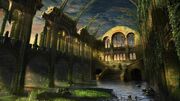
Ruins of the Reichspalast 3032
The Aquitanian Upper House is the Dyranttag, a historic assembly of the upper echelons of Aquitanian Nobility and after 3079, an additional elected Dyrantkanzler. The King/Queen or Grand Duke/Duchess and their Dyrantkanzler represents their ancestral seats and voters, respectively, and advises the Kaiser, the Reichskanzler and the Bundeskongress.
All the Administrative Offices of the country are located in the Reichskanzlei, in the city's Altkott District. The Reichkanzlei is an Imperial Style building built in the year 3100 in celebration to the arriving 32nd Century and to celebrate the Empire's Centennial Celebrations in 3130. All Government Offices, Bureaus and Ministries are located here.
During the small civil war fought in 3060, the Reichspalast burned down and then subsequently suffered extensive damage from bombardments, only the main structure of the building remained, hoping to be rebuilt along with the rest of the country. The Reichspalast, then serving as the seat of the Bundesversammlung, was flooded along with several Central districs of Weißhaupt because of damage inflicted upon the city's dykes and water containment systems.
The reconstruction following the civil war saw the building of the new Reichsversammlung. The Reichspalast was rebuilt as the offical seat of the restored Imperial Monarchy, where the monarch symbolically works in, eventhough the offices are located in the Reichskanzlei.
The Imperial Chancellery
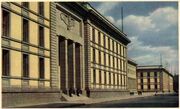
The Imperial Chancellery
The Imperial Chancellery (Die Reichskanzlei) is a large Imperial Style building in the heart of Weißhaupt, in the lowrise southeastern districts. The Reichskanzlei houses all Government Agencies, the Imperial Office and the Chancellor's Office, large sections of the building are occupied by Top-Tier Government Ministries, the largest being Aussenpol in the North Wing. The building follows the Imperial Style, a mix of Vladehorn and Aquitanii architecture which was at its peak in the 18th and 19th Centuries, while Aquitania was at its greatest territorial Extension. It features high ceilings, large rooms and offices, long and opulent halls, great atriums and artistic masterpieces; the Reichskanzlei cost an estimated 1.5 Billion Aquitanian Marks. It was the greatest and most expensive government funded project in 700 years since the funding of the Slipspace Programme before the Arcadia Incident in 2389. The expenses were eventually dwarved by the costs of resettling and reactivating many installations in the country at the start of the Reclamation Era in 3440.
The Kaiser's Office
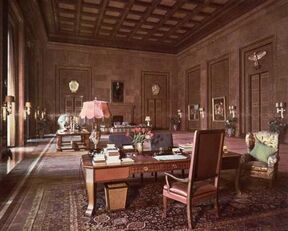
The Imperial Office, Königsberger Reichskanzlei
The Imperial Office in the Reichskanzlei is the central room of the building, the monarch works here, it was built to represent the greatness of the country. In times of war, the office became the nation's war room. When the Reichsversammlung elects a Chancellor, the Chancellor Elect must first meet the Kaiser/in in the Imperial Office and there, the ruler decides whether to approve the Chancellor Elect or not for the position. Future private meetings with the ruler are usually effected there. Following protocol, all Ministerial Heads, Generals and Government Officials report to the Kaise/in there. The room, built in Imperial Style much like the rest of the Building, is large and cozy, making foreign visitors feel comfortable but yet in awe by the opulence. During the Evacuations and Fall of Königsberg in 3375, the office was a central holdout room after the city's defences were breached and the Reichskanzlei was being invaded, CCTV footage suggests it is the place where then Reichskanzler Ailean na Aodhagáin died.
Aussenpol
Aussenpol, or the Imperial Ministry of Foreign Affairs is the largest and most important ministry in the building. The Aussenpol Northern Wing is as singularly imposing as the main building itself. Aussenpol is in charge of the country's Foreign Policy, which is given considerable flexibility when it came to Government Management. The Head of Aussenpol has a lot of autonomy on how to lead the country based on the Foreign Policy of the party he/she is from. The Kaiser can issue guidelines for Aussenpol to adjust to or follow in accordance to the Kaiser/in's wishes. Management of Imperial Embassies abroad and the ability to hand building rights and permits to Foreign Diplomatic Missions are all duties taken care of by the ministry. The funds for maintenence and building of Aquitanian Embassies abroad is acquired through the Imperial Aussenpol Fund, which is independently supported by the Aquitanische Bank.
Des Innern
The Federal Ministry of Internal Affairs is in charge of the supervision of local Governments, National Security, Civil Defence, Immigration matters, Policing and elections. Compared to Aussenpol, the Ministry of Interior is meagre in extension, but not in function. The Interior Ministry handles Community, Cultural and Sports events, while also managing the Federal Communication Network through the notorious AQTelekom company, after 2999, AQTelekom became a Public Corporation, still lending its services to the State at times.
Reichskanzler
The Executive, or the Imperial Chancellor of Aquitania, is the representative of the Aquitanian people, the living voice and democratic symbol of the nation, the Kanzler primarily enforces the law and manages the Fiscal, Judicial and democratic processes of the Empire. The Chancellor is the Head of His Imperial Majesty's Government, and is therefore second in power to the Kaiser/in. The Reichskanzler is elected every ten years and is eligible for five re-elections. Each Party elects it's Candidate, or multiple parties can form a coalition and elect a Candidate jointly. The Head of Government is elected from the largest party in the Bundeskongress, meaning that the party leader with the most votes becomes the Head of Government after a Lower House vote, the Chancellor Elect is then presented to the Kaiser, the latter either approves the Reichskanzler Elect, or rejects the candidate and forces another Party Election or appoints the leader himself, this is rarely done though.
The Imperial Assembly

Reichsversammlung
The Imperial Assembly of Aquitania (Aquitanian: Aquitanische Reichsversammlung), also commonly referred to in media as the White Diet, (Weißtag) is the legislative body of the Third Aquitanian Empire; composed by the Dyrant Council or Upper House (Aquitanian: Dyranttag) and by the Federal Congress (Aquitanian: Bundeskongress). Culture, Economy and Welfare are some of the most resounding topics addressed in the Reichsversammlung. It meets in the Reichsversammlung Building in central Königsberg in the heart of the Financial DIstrict. It was built after the original Reichspalast was burnt down and replaced with the new building. The speaker for the Reichsversammlung is Ursula von Keil.
The Reichspalast now serves as the seat of the Kaiser.
Bundeskongress
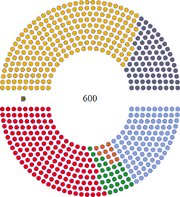
Reichsversammlung Throne Mid-Left
The Lower House of the Legislature, it has control over the Federal Budget, the ability to vote for a Reichskanzler and is the elected representation of the people. The speaker for the Bundeskongress is Gerhard Waussgorz.
The people vote directly for the Bundeskongress, by voting for the Leader of each Party, the President with the highest percentage of Votes, gets the highest percentage of Seats in the Bundeskongress for his party, while the President with the Least Votes gets the least number of seats.
The Bundeskongress with 600 Seats is the official Successor of the Hall of High Commons in accordance to the Savoyard Laws. The Bundeskongress meets in the Reichsversammlung, the building of the Legislation, built after the destruction of Königsberg in the 3060's.
The Free Republican Party, with 250 seats are the majority and the Democratic Social Party, with 150 Seats, are right behind the FNC, the remaining parties; the Federal National Conservatives, with 80 seats, the Imperial Party with 60, the Green Liberation with 40 and the Federal National Party with 20 seats are the smaller contenders. Two Majority Party Coalitions are referred to as Grand Coalitions.
Dyranttag

Palast Dyrant, Dyrant-Kollern Platz, Königsberg
The upper house of the Aquitanian Legislation. It meets in Palast Dyrant in Königsberg historic Altkott District. "The Palace of Dyrant" where the old Hall of Dyrant would meet with the Kaisers and Kings of the old empires and kingdoms. The small assembly room has been expanded in all its glory to fit the entirety of the Aquitanian Noble Lineage. The Dyranttag has special privilages in comparison with the Bundeskongress and the two regularly have vibrant arguments and disputes on whatever issue the two instalments of the legislative disagree on, exemplifying the historic rift between the Aristocracy and the Common Folk. The speaker for the Dyranttag is Heinrich von Kalenberg.
The Dyranttag reviews laws passed by the Bundeskongress before allowing them to be signed by the Reichskanzler and the Kaiser. The Upper House can deny passing any bill it deems unnecessary or in conflict with the nation. It further participates in the Legislature by discussing State Competence, reviewing any Constitutional Change that requires its consent, resolving petty interstate disputes and observing the Reichskanzler does his duties properly.The Dyranttag is the only part of the Legislative that is not elected by the Common Folk.

The Dyranttag Chamber
The Dyranttag also serves as the individual representation of each Federal State in an assembly, the number of nobles representing their state depends on the latter's population. Each member of the Dyranttag has considerable more respect in comparison to the members of the Bundeskongress, the sole fact of being part of the historical landed elite, the Prussian Junkers (Despite the name, it serves to refer to the entire Aristocracy in and out of Prussia).
The Dyranttag has 28 Anchors, all States have three anchors, each having the number of seats their State receives, which is approximately three or two, depending on Population. The nobles of each specific state elect a Duke or Duchess to have the seat in representation for their entity, usually these are the most senior or most popular. The rest, more lesser nobles join their superior Seated Dukes in their place in the Palace of Dyrant, where they are allowed to advice and voice out concerns or opinion. The final decision though rests in the Seated Dukes.
Major Political Parties
National Imperial Conservatives
Rising to popularity after the 3058 Coup and Dictatorship, the Party was founded in 3045 by Prominent Prussian Junkers, among them were: von Helggen, zu Stolberg, Haggel, Saxe-Burg, zu Roth-Scholtz, Keelstarren and Wulffbanii. In an effort to halt the liberal tendencies of the new democracy, with little success, until the 3058 Coup and subsequent unrest and Civil War, which lead the people to place the trust of their country into a Party founded by old families of the Aristocracy. The Party was successful in its initial years, having placed serious economic reforms that prevented the country's industry and economy from crashing after the Civil War and effectively making War Reparations, which included the difficult task of rebuilding 80% of the City of Königsberg, becoming the most popular and beloved party in the country in its History as a Federal Republic and being the first Party to have a woman as a Chancellor-President (Reichskanzler) of Aquitania.
Free Republican Party
The Free Republican Party of Aquitania (FRP), seeks a market economy with Government Intervention in Welfare and Health Care. The Republican Party seeks to maintain the old Welfare State position. The Party wants the Cultural Values in the country to be a top priority and a symbol of Aquitania as it has traditionally been.
Democratic Social Party
The Democratic Social Party of Aquitania (DSP) seeks an economy that is totally State controlled but with Market and Capitalist Liberties, this would ban Private Corporations in the Country and the reverting of IPOed Corporations to State Ownership. The DSP does not have culture as a main priority as it deems it unecessary, believing the Aquitanian people will maintain the culture as they have throughout the centuries.
Federal National Party
Aims more at Isolationism, Ethnocentrism and Nationalism. The party has risen in popularity, winning the 3054 Elections, which in turn elected Dr Hans Hoburg-Goethe to present to Her Majesty, which approved him as Federal Chancellor-President of Aquitania. The Party concentrates in the National Identity of the Nation, preservation of Cultural Values and is criticised by the other parties as highly Xenophobic. The Party though highly supports Tourism in the Nation.
Constituent States

Geopolitical Map of the Aquitanian Third Empire 3415-Present

Federal State Map of the Aquitanian Third Empire 3415-Present
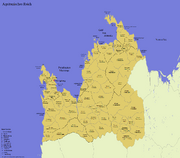
Geopolitical Map of the Aquitanian Third Empire 3330-3375
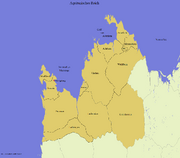
Federal State Map of the Aquitanian Third Empire 3330-3375

Federal State Map of the Aquitanian Third Empire 3275-3330

Geopolitical Map of the Aquitanian Third Empire 3275-3330

Federal State Map of the Aquitanian Third Empire 3243-3275

Geopolitical Map of the Aquitanian Third Empire 3243-3275
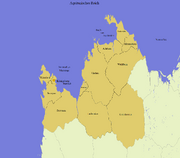
Federal State Map of the Aquitanian Third Empire 3190-3243

Geopolitical Map of Imperial Aquitania 3190-3243

Geopolitical Map of the Empire 3110-3150 (3150-3190 Without the General Government of Lothringen)
Aquitania is compromised of 5 Federal States plus the City State of Weißhaupt. All states, regardless of Imperial status are Federal States. The 6 states are referred to as Bundesstaaten, or more specifically as Königreichen when referring to one of the 2 Kingdoms, Großherzogtum when speaking of the Grand Duchies, Fürstentum when referring to the Savoyard Principality, Reichsstadt for the former Imperial City of Kahltforenburg and finally Reichsland when officially speaking of the Imperial Territory of Lothringen. Weißhaupt is also referred to as "Die Hauptstadt", meaning The Capital and sometimes Staatstadt, meaning City State, the latter fell out of used when Kahltforenburg was elevated to the status of Imperial City in the mid 34th century. The most populated and industrious Federal State is Savoy followed by Prussia and Ludonnia. Prussia sits among the most industrialised and highest agricultural producers in the country.. Savoy is the "Import State", the state that handles most foreign imports and that has the most advanced port facilities, followed by Prussia. Some Imperial states, such as the two Kingdoms, enjoy more autonomy than the other Federal States, Savoy has equal autonomy in relation to the two remaining Kingdoms and was unofficially considered the 6th Kingdom until the loss of the eastern territories.
3415-Present Federal Constituencies
Federal Constituencies during the present Reclamation Era
- City State of Weißhaupt
- Kingdom of Prussia
- Kingdom of Ludonnia
- Principality of Savoy
- Grand Duchy of Weißland
- Imperial Territory of Lothringen
3330-3375 Federal Constituencies
Federal Constituencies towards the end of the 3rd Imperial Period
- City State of Königsberg
- Kingdom of Prussia
- Kingdom of Wulffbane
- Kingdom of Vladien
- Kingdom of Ludonnia
- Kingdom of Kaledonnia
- Principality of Savoy
- Imperial City of Kahltforenburg
- Imperial Territory of Lothringen
- Grand Duchy of Weißland
- Grand Duchy of Arlathan
- Grand Duchy of Asteria
- Grand Duchy of Alexandria
Timeline of Reichskanzlers
An accurate timeline of all the Kanzler-Präsidents; Reichskanzlers and their Majority Elected Parties by 8 year terms and their re-elections. After the restoration of the Monarchy and the Empire in the year 3050, the title was shifted to "Reichskanzler".
Kanzler-Präsidents
3030-3038
- Kanzler-Präsident - David Krössberg
- Party - Free Republican Party
3038-3046
- Kanzler-Präsident - Philipp Bauer
- Party - Democratic Social Party
3046-3054
- Kanzler-Präsident - Philipp Bauer
- Party - DSP/FRP Grand Coalition
Reichskanzlers
3054-3062
- Reichskanzler - Hans Hoburg-Goethe
- Party - Federal National Party
3062-3070
- Reichskanzler - Karl von Helggen
- Party - Federal National Conservatives
3070-3078
- Reichskanzler - Karl von Helggen
- Party - Federal National Conservatives
3078-3086
- Reichskanzler - Anne Elise zu Brannberg
- Party - Federal National Conservatives
3086-3094
- Reichskanzler - Anne Elise zu Brannberg
- Party - Federal National Conservatives
3094-3102
- Reichskanzler - Anne Elise zu Brannberg
- Party - Federal National Conservatives
3102-3110
- Reichskanzler - Anne Elise zu Brannberg
- Party - Federal National Conservatives
3110-3118
- Reichskanzler - Georg Wolkenkratz
- Party - Federal National Party
3118-3126
- Reichskanzler - Georg Wolkenkratz
- Party - Federal National Party
3126-3134
- Reichskanzler - Georg Wolkenkratz
- Party - Federal National Party
3134-3142
- Reichskanzler - Georg Wolkenkratz
- Party - Federal National Party
3142-3150
- Reichskanzler - Joseph zu Brannberg
- Party - National Imperial Conservatives
3150-3158
- Reichskanzler - Joseph zu Brannberg
- Party - National Imperial Conservatives
3158-3166
- Reichskanzler - Karl von Nordweiss
- Party - National Imperial Conservatives
3166-3174
- Reichskanzler - Karl von Nordweiss
- Party - National Imperial Conservatives
3174-3182
- Reichskanzler - Kolden Hetzburg
- Party - National Imperial Conservatives
3182-3190
- Reichskanzler - Kolden Hetzburg
- Party - National Imperial Conservatives
3190-3198
- Reichskanzler - Kolden Hetzburg
- Party - NIC/DSP Grand Coalition
3198-3206
- Reichskanzler - Victoria Weißer
- Party - Democratic Social Party
3206-3214
- Reichskanzler - Victoria Weißer
- Party - Democratic Social Party
3214-3222
- Reichskanzler - Victoria Weißer
- Party - Democratic Social Party
3222-3230
- Reichskanzler - Victoria Weißer
- Party - Democratic Social Party
3230-3238
- Reichskanzler - Helmut Hönfreuden
- Party - DSP/FRP Grand Coalition
3238-3246
- Reichskanzler - Helmut Hönfreuden
- Party - Free Republican Party
3246-3254
- Reichskanzler - Helmut Hönfreuden
- Party - Free Republican Party
3254-3262
- Reichskanzler - Gerhard Deutscher
- Party - FRP/NIC Grand Coalition
3262-3270
- Reichskanzler - Gerhard Deutscher
- Party - NIC/FRP Grand Coalition
3270-3278
- Reichskanzler - Wilhelm Kronberg
- Party - National Imperial Conservatives
3278-3286
- Reichskanzler - Wilhelm Kronberg
- Party - National Imperial Conservatives
3286-3294
- Reichskanzler - Wilhelm Kronberg
- Party - National Imperial Conservatives
3294-3302
- Reichskanzler - Wilhelm Kronberg
- Party - National Imperial Conservatives
3302-3310
- Reichskanzler - Albrecht von Gottland
- Party - NIC/DSP Grand Coalition
3310-3318
- Reichskanzler - Albrecht von Gottland
- Party - DSP/NIC Grand Coalition
3318-3326
- Reichskanzler - Wolfgang Schmeier
- Party - Democratic Social Party
3326-3334
- Reichskanzler - Wolfgang Schmeier
- Party - Democratic Social Party
3334-3342
- Reichskanzler - Wolfgang Schmeier
- Party - Democratic Social Party
3342-3350
- Reichskanzler - Frank von Korburg
- Party - Democratic Social Party
3350-3358
- Reichskanzler - Frank von Korburg
- Party - Democratic Social Party
3358-3366
- Reichskanzler - Frank von Korbirg
- Party - IP/DSP Grand Coalition
3366-3375
- Reichskanzler - Ailean na Aodhagáin
- Party - Imperial Party
Colonies
Settlements and Overseas Territories of Aquitania are listed here.
Aurenloss Settlement & Military Base
Aussriesen-Aurenloss

Aussriesen Settlement, Military Base & ONI Research Facility - Space Tether on Centre Right
The Aquitanian Sector of the Union's main Settlement, located a few kilometres away from the City of Mount Irvin. The new Space-port & Tether being built there will serve the greater city in a near future, a second Tether is being planned for the nearby Mining complex to focus exclusively on Cargo to ease the transport on the initial Space Tether. Currently, Aurenloss has an Aquitanian Population of 2,345 people, large campaigns to promote colonists from moving there are being launched in the Mainland.
Government Activity
Reichsstadt Kahltforien
From 3279 to 3330, the Reichsversammlung debated whether to elevate the historic city of Kahltforien to the status of Imperial City (Reichsstadt). Successful legislation would turn the city and its immediate surroundings into a Federal State, separating it from the Grand Duchy of Alexandria, a State that opposed the move primarily for financial and other symbolic reasons. The Grand Duchy of Arlathan also opposed the proposal, instead suggesting it be reincorporated into its territory, claiming "historical ownership", since it had lost the city after Aquitanization in 2950. The debate itself sparked historic territorial disputes between the Federal States in the Empire, namely from Prussia and Vladien, Vladien having protested the territorial acquisition Prussia made from Lothringen after the 3275 Treaty of Peace with Constantine. Something Prussia countered with the Loss of Straßburg in turn slapping Lothringener MPs in the Reichsversammlung. The proposal managed to pass in both houses of the Reichsversammlung, with a majority in the Bundeskongress. In the Dyranttag all states voted in favor except Alexandria and Arlathan, which voted against.
Evacuations of East Prussia - 3372
One of the last major topics on the Reichsversammlung's agenda before closing session permanently was the decision to evacuate Eastern Prussia. The discussion was controversial as it involved the greatest mobilization of forces the country ever saw to move 18 million people from East Prussia, an exclave of the Kingdom of Prussia in the Eastern Mainland, to the Western Mainland. The operation required the pooling of most remaining resources and the assembly had to limit funding and operations in other areas, like containment, to evacuate 18 million people, which were stranded in East Prussia as the blight approached. After a month of debating and after a rousing speech from the Imperial Chancellor, the Reichsversammlung unanimously voted to evacuate the stranded civilians, in an operation that would "Save millions to kill millions", after the blight spread to the Western Mainland, presumably in one of the last evacuation vessels that landed in Preutterdam.
Geography
The country has a varied landscape, ranging from Mounitains and Polar Forests to warm, sunny Beaches in the coastlands. The country borders the Nassau Sea (Nassausee) to the North, the Nassau Gulf (Golf von Nassau) to the East, the Greater Nassau Ocean (Grossnassauer Ozean) to the West, Constantine to the Southwest, Myanmar and Occupied Bohemia to the South; and Kronvas-Poleti to the Southeast.
Elevations vary from the Prussian and Kahltfork Ranges in the Western and Eastern Mainlands respectively, highest point being the Kahltspitze at 3,980 Metres; to the Lowlands of the Coasts, lowest point being the Arlathia (Arlathien) Basin at 4.56 Meters below sea level, traversed by the main river Arkweiss. Glaciers are located in the Prussian and Kahlt Mountain Ranges and their Highlands. Natural Resources that are in abundance are Iron Ore, Oil, Timber, Natural Gas, Uranium, Nickel, Silver, Gold, Coal, Zinc, Arable Land and Water.
Aquitanian Kahlts
The Aquitanian Kahlts (Aquitanian: Aquitanischer Kahlten), commonly referred to as by the state they are in (Arlathanisch Kahlten, Alexandrienisch Kahlten, Wulffbeiner Kahlten & Asterheiner Kahlten), is an extensive mountain range system in eastern Aquitania, close to the country's Eastern Seaboard. (Pending)
Kollern Extensions

Fields of Kollern, Oberkollern & Niederkollern; Wulffbein, Aquitanien
The Kollern Extensions in the Central Plains of Wulffbane is the most fertile region in the Empire, being the source of food for the entire region and being incredibly alike to the Prussian Golden Fields and the Kolleranian Fields of Lusitania, which took the name from the Wulffbein Extensions and popularised it in Lusitania. The fields are plowed, sowed and harvested with automatic machinery because the Kollerannian Fields are too far stretched for human hand to farm, and of course, technology allows it. The average Manor (Aquitanian: Palast, Schloss, Schlösser or Herrenäuser) is a large plot of land that is usually administered by an affluent family and is several acres in extent. These Manors are owned in their majority by Aquitanian Junkers and other wealthy members of society. Since the purpose of the fields is to have excellent output, efficiency and successful harvests through the use of specialised AIs and robots, an average family is not expected to be able to maintain the costs of technical maintenance for the labour out in the fields. The Government gives rewards and benefits to the Manors that have the greatest output in the country. The large swaths of land owned by the high class is in stark contrast to other cultures, where some sort of agrarian reform split up the land among the rurals, as was the case initially. This shift in the land ownership tendency was referred to as the Agrarian Reversal, where, as opposed to the Great Agrarian Reforms in the 18th century, the lands were sold back to their original, feudal owners. This was a result of the migration of rural populations to major metropolitan cities, emptying the fields at alarming rates in the late 21st Century. Officials and scientists seeked other methods to keep the fields well worked to feed the country. So came the AI solution and the current state of the Kollern Basis. Aquitania is the only country in the world where a small fraction of society (in this case the nobility and wealthy) sow and reap the fields to provide for the country. Over time, the Kollern Fields have become a major geographic landmark in the country.
Clear afternoons cause the wheat fields to look golden, on clear nights you can always observe the Planets of Kebir Blue and Fearless Blue, which light the night sky up like gigantic moons. Truly dark nights are uncommon unless there is a clouded sky; and on the Mornings the winds blow the Pollen, forming huge, beautiful golden waves in the sky. The Arkweiss river divides the provinces of Upper Kollern and Lower Kollern.
Principal Rivers in the Western Mainland
- In the State of Weißland
- Schwehr
- Feldkoll
- In the City State of Königsberg
- Flussburg
- In the State of Savoy
- Flussburg
- Deggale
- Slawoia
- In the High State of Prussia
- Preutter
- Westkolt
- Deggale
- Slawoia
- Gürtel
Principal Rivers in the Eastern Mainland
- In the State of Arlathan
- Arkweiss
- Arkadien
- Drakön
- Mehr
- Wulff
- In the High State of Vladien
- Drakön
- Awarhin
- Luxer
- Arkberg
- Miessel
- In the High State of Wulffbane
- Arkweiss
- Kleine Arkweisser
- Alexandrien
- Könner
- Kahlt
- Wulff
- Alter
- Böhn
- In the State of Asterhein
- Cohr
- Buchter
- Mehr
- Lunner
- Hessen
Principal Rivers in the Southern Mainland
- In the High State of Ludonnia
- Prutter
- Böhmener
- Siefluss
- Tusseldt
- Möss
Climate
Most of the country has a temperate climate, the north having an Oceanic Climate influenced by the Nassau Current, while the South Easterly Regions have a Humid Southern Continental Climate. Summer in Aquitania begins in December and lasts up until March, Fall from April to May and Winter taking June all the way to November.
Nord-Aquitanien
Most of Northern Aquitania, particularly the Western Mainland and the North East, has an Oceanic Climate, characterised by Mild to Cool Summers and Cool Winters, precipitation is common throughout all the year. The Oceanic Climate is brought upon by the North to South Nassau Sea Current, which brings the warm water that the coasts of Aquitania enjoy.
Südost-Aquitanien
South East Aquitania, specifically Ludonnia, Wulffbane, southwestern Highever and western Alexandrien have a Humid Southern Continental Climate, marked by Warm Summers and Cold Winters, usually snow marks most of Winter, the climate has an even precipitation throughout all the year, making this particular regions the most fertile ones of the country, Wulffbane primarily exporting wheat and processed foods.
Monarchy
Main Article: House of Hohensteinburg-Colliete
The Last [Recognised} Monarch of Aquitania was Kaiser Wilhelm IX Hohensteinburg-Colliete
Insight
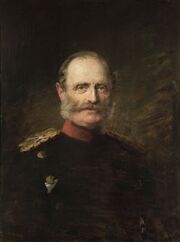
Kaiser Wilhelm VII (Died 3301)
An Imperial Dynasty ruled Aquitania since 1507CE as Absolute Monarchs. Whether ruling an empire or a more centralised Kingdom, the country had always been ruled by an Absolute Emperor with an advanced Parliamentary System. Throughout the centuries, the monarchy had been known for bringing great honour and prosperity to the nation, having become from a simple symbol to Aquitania's soul itself.
Kaiser
The last head of the House of Hohensteinburg was Wilhelm IX Hohensteinburg-Colliete, his titles were His Grand Majesty the Kaiser of Aquitania, Prince of Azurnereich, 7th Duke na Ellenjoy Grace, 3rd Vasilioros (Όρος βασιλιάς) in Ruthenia, 7th Duke of East Prussia, High Marshall of the United Aquitanians and Beacon to the 4 Kingdoms. The Hohensteinburg Dynasty had been ruling Aquitania for over 450 years under various banners and systems.
History
The Hohensteinburg dynasty originated in Azurnereich, and came to Aquitania in the year 2904 after the Aquitanian Provisional government offered the Prussian Throne to future König Friedrich after the fall of the Wolfkehr dynasty. Following the arrival of Friedrich the Great (as he was later called), the former properties of the Wolfkehr Family, as well as the traditional and historic artifacts were handed to the Hohensteinburgs, their presence and new belongings being consolidated after the Prussian Conquest of the Aquitanian Nations. The Hohensteinburgs later devolved Prussia to a Dukedom following the revivial of the Aquitanian Kingdom in the year 2950, the system remained the same as in the Kingdom of Prussia and the capital remained in Königsberg. Eighty years later, the Kingdom of Aquitania was elevated to an Empire following the early 3030 Republican Uprisings, the first Kaiser was Wilhelm III Hohensteinburg, after he elevated the Kingdom to an Empire.
Crownlands
The Crownlands (Kronländer) were the lands under the direct administration of the Kaiser and his Imperial Family, they were limited in comparison to Aquitania's size. The City State of Königsberg was the core Crownland (Hauptkronland), from where the Kaiser ruled the Empire, it was also the second largest, formely the third largest, of the Crownlands. Important crownlands include Feldsmarsch Schloß, the largest castle in Aquitania and also the favourite residence of the Imperial Family; and East Prussia, the largest Crownland. The Duchy of Ellenjoy Grace was formerly the largest Crownland under the Kaiser's administration, but was lost in 3175 after the capitulation of the East Heaven Kingdom, who's monarch, Serene Queen Mint na Colliete had awarded the land and title to her twin sister, Kaiserin Maya Elisabeth na Colliete of Aquitania in the year 3050.
Crown Jewels
There were over 21 Imperial Crowns for coronation ceremonies, mostly because new monarchs regularly requested new crowns for asthetic reasons, size or weight. Most historic crowns were smuggled to Lusitania in the Republican Uprisings (3030) and in the War of Suppression (3060). 15 crowns were later repatriated while two remained missing.
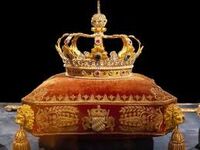
The Grand Crown
The Royal Robes (elevated to Imperial Robes after 3030) of the previous Wolfkehr dynasty were still used by the Hohensteinburgs in accordance to tradition as late as 3377, after which they were lost during the Blight.
König Alexander II Hohensteinburg was the first of the Hohensteinburg Monarchs to use the Grand Blue Robe of the Serene Alliance, an old gift dating from the 2850's from the fallen Kingdom of Hermantine, which existed as its successor state, the East Heaven Kingdom until 3183. The Grand Crown, the most symbolic of the entire Imperial Regalia (which includes an additional 18 Crowns), was created in 672CE. It was the most symbolic and famous crown in the Aquitanian realm, earlier crowns are within the current head piece itself, modified by Kaisers and Kings of old to fit their liking or "fashion" at the time over the ages.
Regime Portrait Tradition
The Imperial Family, specifically the Emperor and Empress enjoyed commissioning portraits ranging from the early middle to the late First Empire styles. This tradition had been held since the Wolfkehr Dynasty and was considered until 3030 a matter of protocol and duty. The monarchs usually ordered their portraits depicting them doing State or Casual activities.
Noble Families also followed this tradition for centuries as the portraits are considered a sign of patronage over the arts, culture and served as indicators of status. The portraits were appreciated for their fine beauty and accuracy in portraying the person depicted on canvas. Most portraits were lost during the Second Blight.
Independent Government Agencies
The following organisations and institutions had complete and/or a considerable amount of autonomy from the Imperial Government:
ARK
The Aquitanian Red Cross (ARC) (Aquitanian: Aquitanisches Rotes Kreuz) was a neutral, humanitarian programme organised in a Federal Structure that delivered comprehensive medical aid, disaster relief and various other services to the people of Aquitania and Great Palms regardless of political, racial, religious and ideological inclinations. It possessed an advanced blood programme. Around 7 million volunteers supported the organisation in Aquitania alone (3370), plus an additional 5 million from neighbouring countries in the Great Palms area. ARK was a leading organisation in the initial fight against the blight, directing all resources to stop the spread.
ONI

ONI Platz, the Largest ONI Base in Aquitania
ONI, or the Office of National Intelligence was the largest and most important agency in Aquitania, it was founded in the year 2147 by Dettever Didact. By 3030, ONI had grown to become a powerful independent unit, with a force of their own, but ever loyal to the Aquitanian Kingdom in history and to the subsequent Aquitanian Republics and Empires throughout the centuries. ONI was in charge of all subterfuge activities, classified installations and artifacts in the country or abroad and was the leading research sector of the government. ONI also controlled many bases around the planet and neighboring countries, with or without their knowledge, proving ONI supremacy over the intelligence agencies of other countries.
ONI Base was located in Aquitania, State of Prussia near the City of Brandenburg.
Sectors and Classified Levels
ONI had 4 protocols and in each one several sectors and Bureaus, the four protocols had their own level of classified contents and actions. Protocol 0 was the most secretive.
Protocol 3
The Head of Protocol 3 was appointed by the ONI Director

A Prussian Woman observing ONI Base near Brandenburg, Prussia, Aquitania
Protocol 3 was burdened with civilian related research, the breakthroughs were revealed to the public and immediately put to use for the civilian population at a daily basis. Examples of important breakthroughs produced by Protocol 3 were the anti-gravity development used to build the Savoy Colosseum, Metallic Glass and Ivory Titanium Flex Metal used to build skyscrapers at the time and finally the transition to Plasma Engines in the 2940's. The Sector of National Awareness Reports gave vital information to the population daily and in states of crisis, replacing the old AHDA Awareness Reports, mass evacuation orders are handled by Protocol 3. Information released by Protocol 3 included Evacuation Notices for cities and territories, the latter being used extensively during the First Blight towards the end of the 34th Century.
- ONI Sector 3 of Engineering and Technology
- ONI Sector 3 of Bioengineering and Technology
- ONI Sector 3 for Investigation of Foreign Entities
- ONI Sector for Medical Investigation
- ONI Sector for Propulsion Development
- ONI Sector of Fuel Research
- ONI Sector for National Awareness Reports
Protocol 2
The Head of Protocol 2 was appointed by the ONI Director.
Protocol 2 stores and organized the National Historic Archives that are in the level "2" Classification, Protocol 2 archives were only delicate to the public, Archives with Level 2 Classification were declassified and shown to the public 50 years after the events in the Archive had occurred. An example of a Level 2 Classification Archives are the Assasination of Alexander Wolfker, the Arcadia Sewer Fuel Leakage Conspiracy, Avaris Evacuation Protocol and the Death of Queen Morrigan II Wolfker, last monarch of the Wolfker Dynasty. Protocol 2 also handled national propaganda, most observed during the invasion of New Highever, Protocol 2 didn't allow reports of "Chimeran Atrocities" to reach other cities or UKO Territories to prevent morale from falling.
- ONI Sector of Investigation
- ONI Bureau II of Extraplanetary Investigation
- ONI Sector of Media Coverage
Protocol 1
The Head of Protocol 1 was appointed by the ONI Director.

The Famous OBU Bombardment of the Calzador Army outside Faresake A cover up for 20 years
Protocol 1 was in charge of ONI's highly classified archives and cover ups, it stored the famous Map of the Underground Ancient Roads. It was the commanding chain of the Elite Forces of ONI, being the most widely used Protocol by the armed forces. The most intensive and secretive research was done here, including the reverse engineering of Alien Technologies.
- ONI Sector 1 of Engineering and Technology
- ONI Sector 1 of Bioengineering and Technology
- ONI Sector 1 of Foreign Investigation
- ONI Sector of Military Technology
Protocol 0

Dr. Anne Catherine Kirössen
The most distinguished Head of Protocol 0 was Dr. Anne Catherine Kirössen, she was also ONI Director for a substantial amount of time.
Protocol 0 was the most secretive Protocol of ONI, its existance is not general knowledge outside ONI, activities of Protocol 0 are highly classified and unknown outside the ONI Command Hierarchy. The Protocol handled internal ONI Affairs and policed the activities done by other Protocols, as well as weeding out illegal programs within ONI. The Protocol held the most controversial and classified documents in Aquitania and much of the world, including the notorious ONI Cover-ups of the Central Mountains, the Chimeran Attack on Brandenburg Conspiracy and the super soldier program. Archives, research and discoveries made by this protocol were usually kept classified because it would damage National Security if gone public. It was the only Protocol to have special forces that are allowed to use lethal force to protect Aquitania and its Archives.
Dr. Anne C. Kirössen's research lead to many breakthroughs and discoveries, including the fabled "Sentient Artificial Intelligence or Generation 2 Intelligent AI's", which she created and the instalment of the Generation 1 Intelligent AI's on Aquitanian Warships.
The super ONI Complex under the Central Mountains was under the administration of Protocol 0, it is called "Ground Zero" because of the major breakthroughs that have been linked there. After 3375, the complex was stronghold against the Blight, its status is currently unknown. It is believed the Protocol 0 archives are still stored in the complex.
Transport Commission & Authority
The Federal Transport Commission and Authority had minor autonomy from the Government, managing all of Aquitania's Transport means, their safety, maintenance and routes.
Foreign Affairs
Main Article: Foreign Relations of Aquitania
Aquitania enjoyed an alliance with all members in the Union Federation and had friendly relations specifically with the East Heaven Kingdom, Republic of Constantine, the Imperial Union of Gaia, the Republic of Ardglass, the Union of Universal and Rumelia.
In the year 3167, the now defunct East Heaven-Aquitania Bond, the continuation of the Aquitania-Hermantine Bond signed in 2867 celebrated 300 years since its signing in Il de Hermantine. The Special Relationship was the longest agreement Aquitania was in. Aquitania held East Heaven in the most upper regard, especially after the Union of the Imperial Family with the East Heaven Royal Family, forming the House of Hohensteinburg-Colliete, the ruling dynasty of Aquitania. Following the defeat of East Heaven in the closing years of the 32nd century, Talisibeth was welcomed as the Princess of Savoy.
In 2957, Aquitania and Constantine signed a similar Treaty of Special Relation in which a closer bond of the two nations, different in Origin, People and Culture, was created. The Treaty was consumated and sealed with a "Golden Lock" by the Marriage of Andres Souza and Pauline Hohensteinburg that same year. The House of Souza is considered a Branch of the House of Hohensteinburg, naming customs in Constantine though did not incorporate the surname as in the Aquitanian-Germanic naming customs. No living person remains that remembers in what city the Treaty was signed, documents were destroyed in the 3058-3060 Coup & War in Aquitania and in the Constantinian Civil War of 3075-3118.
The Empire was also in a Economic Cooperation Treaty with the Republic of Ardglass, known as the ECT-2, signed in the year 3125 to promote and prioritize each country's economies with targetted investments. The Treaty was expanded by 3160 by admitting two nations into the treaty, creating the ECT-4. The treaty collapsed in the year 3165 after the defeat of Ardglass in the Pegersian War.
Aquitanian Embassies
Aquitania had several Imperial Diplomatic Missions abroad, the most popular and busiest mentioned below. Note that Aquitania had all foreign Embassies in the City of Savoy and not in Königsberg, the Capital. In addition, every state within the empire has an embassy within the Imperial Embassy abroad. Even though the Imperial Ministry of Foreign Affairs has complete control, the embassies were merely symbolic, but did express or serve a function concerning the interest of the represented Imperial State; for example tourist, state laws. The categorization is vital for foreigners who are not aware of the Imperial Law System; which gives broad lenience to the Federal States concerning the Judicial Sector. For example, tourists may be unaware that wearing a Pickelhelm (a police/military hat popular among tourists) in Prussia is illegal; but not in the rest of the states.
Country names are displayed in Aquitanian:
Östlichhimmelreich Aquitanischen Botschaft (2857-

Aquitanian Embassy in Ville de Hermantine, East Heaven
"House Asterien" (Haus-Asterien, Asterienburg), was the Historic and grand Embassy of Aquitania in the East Heaven Kingdom, it had been standing since the year 2857 in Il de Hermantine (later Ville de Hermantine), the old Capital of the Kingdom & Capital of the Duchy of Hermantine. The Embassy was established by Imperial Aquitania (The Second Empire 2809-2914). The Embassy was located on the eastern sector of the City, with a grand park behind it and another park on its front. The capital of the Realm was in Veluca, despite this, the Embassy remained in Il de Hermantine, a few miles west from the Capital. The Embassy was built modestly, but after the 2867 Aquitania-Hermantine Bond was signed, embassies in both countries expanded to represent the ever growing friendship of the two nations.

Grand Hall of Dining
The Hermantine Embassy in Arcadia, Aquitania, was first evacuated on January 2904 and then unfortunately destroyed with the explosions that levelled the Aquitanian capital that same year later in the Summer, destroying the great Hermantine Embassy, which was a grand building.

Restaurant Palast
The Hermantine Embassy was not rebuilt in Savoy until 2979, when the successor state of Hermantine was declared the East Heaven Kingdom. The Aquitanian Embassy in Il de Hermantine and all its diplomatic staff throughout the years after the fall of Hermantine remained there. After restoration, East Heaven recognised the Embassy in the old capital as the official Embassy of Federal Aquitania, and later Imperial Aquitania, in the East Heaven Kingdom. The Diplomatic Mission also had several Consulate-Generals in major cities around the country and one Honourable Consulate-General in Veluca. The 3058 Civil War, 3030 Republican Coup, the collapse of Imperial Aquitania in 2904 and the foundation of Prussia in 2914 did not disturb the peace in the Embassy or its surroundings.
The Embassy building was famously known for being the home of the exiled House of Asterien, rulers of Prussia. Exiled in the year 2892 during the Second Great Schism in Aquitania, the fall of the House of Wolfkehr and arrival of the House of Hohensteinburg prolonged their time abroad and lives in "House Asterien", as the new monarchy failed to restructure the Empire and just expanded Prussian Hegemony over the other Kingdoms, ousting the other Monarchies by stripping them of their titles and reducing them to Dukedoms. The Embassy in Il de Hermantine, 18 years before the outbreak of the East Heaven War of Unification, invited the royal family to live in its Palatial building, to which the House of Asterien consented and flew to a few days after the explosion of Arkadien. The Embassy remained largely untouched during the conflict, apart from a few night-time shells during the conflict. The royal family converted the Palatial Embassy into a Hospital from 2923 to 2959.
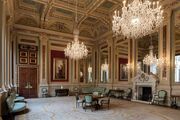
State Room of Mingling
The Embassy was the aim of all Government Officials working in Aussenpol, some arguing that being a high official there has a more prestigious and influential position than that of an ambassador elsewhere. Because of the historical imperial and noble ties that East Heaven has with Aquitania, in unique terms only applying to the building and its grounds, only Aquitanian Nobles or Imperial Members were allowed to serve as Ambassadors to East Heaven. In addition, cultural programs were hosted and financed by the Embassy when approved by the Serene Queen, in an effort to boost the previous former glory of Pre-East Heaven Il de Hermantine and to drag tourism.
The Embassy was partially destroyed during the 3172 Pegersian attack on Ville d'Hermantine, which destroyed 84% of the City. Upon the declaration of war in 3171, Duke Ambassador Alexander Maric Hohensteinburg-Colliete of Niederkollern, brother to late Kaiser Wilhelm V and Serene Queen Morgan's cousin opted to rally all Diplomatic Staff in the country to the Sapphire Palace in Veluca to protect the Royal Family as forces rapidly invaded the country. Duchess Alexandra was killed on her way to the Palace, the couple's children though managed to successfully evacuate the country through the local Aquitanian Luftwaffe Base, at the time an evacuation centre. The Diplomatic Staff and most East Heaven Royal Family's whereabouts are unknown and are presently presumed to be dead. The grand daughter of Queen Morgan, Tallisibeth III arrived in Aquitania a decade later to the joy of refugee Oirthir and was awarded the Principality of Savoy as a continued sign of friendship between Friedrich II and the East Heaven people, which made up a substantial part of the Aquitanian Empire at the time.
House Asterein became the centre of the East Heaven Resistance from 3175 to 3183, when the City of Ville de Hermantine was completely destroyed in a deadly conventional missile attack. The Capital City of Veluca was also levelled, largely killing occupation forces.
- Embassy
- Ville de Hermantine
- Honourable Consulate-General
- Veluca
- Consulates-General
- Dandiville
- Izumishima
- Jiangling
- Mikasalia
- Radiata
- Cathair na Tonnta
- Cathair Uisce
- Golden Lake
- Arni
- Guldove
- Mindelan
- Lyon
- Corus
- Termina
- Marbule
- Consulates
- Eugene
- Baltassa
- Gederan
- Maraton
- Ambassador - None
- Diplomatic Staff - 100 Aquitanian Officials (Formerly)
- Federal Guards - 150 Aquitanian Guards (Formerly)
- Outer Guards - 80 East Heaven Guards (Formerly)
- Vehicles - 100 Civilian Non-Armoured Vehicles (Formerly)
- Cleaning - Artificial Intelligence Complex Called Alten Miss (Formerly)
Republik Ardglass Aquitanischen Botschaft (2920-3164)

Aquitanian Embassy in Saoirsi Buaic, Ardglass

Aquitanian Embassy in Saoirsi Buaic, Monument Dismantled 3145-3147
The Embassy of Aquitania in the Republik Ardglass' Capital Freiheitspitze, was established in the year 2920 by the Kingdom of Aquitania, after the 3030 Republican Coup, the Embassy was retaken and re-staffed. The Embassy and Diplomatic Mission of Aquitania in Ardglass was withdrawn in 3098 after Aquitania decided to break relations, following an East Heaven-Ardglassian incident of which Aquitania supported East Heaven. The old Embassy was heavily damaged but rebuilt in 3105.
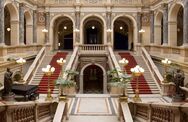
Main Foyer of the Aquitanian Embassy in Ardglass
The Embassy was re-opened a year later in 3106, with hightened security and determination by Aussenpol to relocate the Diplomatic Mission to another Building. The Old Embassy was an Opulent 18th century Aquitanian Style building near the City's historic Center. The Diplomatic Mission also re-opened several Consulate-Generals in major cities and consulates in Secondary Cities around the country as well. Escalating tensions between rival federations prompted Aussenpol to issue emergency withdrawal procedures, including drill emergency evacuations and document elimination, the Embassy building began partial evacuations on November 25th, 3142, a mid Aquitanian Holiday celebrations, the Embassy remained open though with just non-essential personnel evacuating the country.

The Green Room
In the year 3107, Aussenpol acquired a 28th Century Building and remodeled it to the Imperial Aquitanian Style to be the new Aquitanian Embassy in the City of Saoirsi Buaic, the building is more grand, following a similar architectural style than that which Ardglass follows and is more opulent when it comes to the interior. The Embassy was likened to a palace and considered quintessentially Aquitanian.
On June 20th, 3126, the Imperial Union of Gaia was granted an Interests Section where Gaian diplomats would represent their nation upon the Ardglassian Senate and People.
In 3145, with Ardglass' impending war in the horizon, the Aquitanian Diplomatic Mission in Ardglass determined that evacuating the bronze "Cavalcade" Statue crowning the Embassy Building would be wise, so the 38 year old figure was relocated to Savoy, Aquitania. In 3146 though, war was disposed as a threat and arrangements for the monument to return to its dominant position were concluded in 3147.
The Imperial Embassy was taken by surprise in the sudden eruption of Ardglassian hostilities in the year 3164 with the United Empire of Pegersus. The diplomatic staff was caught up in an unprecedented city wide panic outbreak and as the Embassy began evacuation protocols, the city was struck by a nuclear warhead, killing staff situated near the Embassy's windows. Although the embassy had a bunker, the death toll was largely due to city alarms failing to deploy and Nuclear Defence Batteries not being active. After the strike, Pegersian forces landed in Ardglass and commenced a full scale invasion, Aquitanians were also targeted by the invading force, frustrating country wide evacuation mandates.The Embassy was breached and most of the surviving Diplomatic Staff was massacred. The staff that remained, presumably including serving Ambassador Anne Fulk, were killed by a second nuclear blast.
What remains of the building is the structural skeleton and the molten Bronze Cavalcade statue, which was sadly not evacuated as in 3145, marking a desolate and ruined horizon. An underground Ardglassian resistance branch is rumoured to be headquartered in the ruined building.
- Embassy
- Saoirsi-Buaic
- Consulate-Generals
- Miotail
- Syracusae
- Taisteal
- Asmara
- Pollentium
- Londonium
- Consulates
- Gra
- Boise
- Ambassador - None
- Diplomatic Staff - 15 Aquitanian Officials (Formerly)
- Federal Guards - 50 Aquitanian Elites (Formerly)
- Outer Guards - 50 Aquitanian Elites (Formerly)
- Vehicles - 30 Civilian Armored Vehicles (Formerly)
- Cleaning - Artificial Intelligence Complex called Politik (Formerly)
Königreich Konstantin Aquitanischen Botschaft

Aquitanian Embassy in Constantinople, Constantine
The Aquitanian Embassy in Havanna, Konstantin was established early in the year 2840 by King Richard VII of Aquitania and by then General Davis leader of Yugobania. Post-Schism Aquitania has been represented in Constantine for nearly 400 years, eventhough Constantinian-Aquitanian establishment of relations date to the early 14th century through the Calzadorians, an official embassy was established in the year 1875, but was withdrawn when the Great Schism erupted 600 years later. The new embassy building was in the city's contemporary district, 20th to 21st century socialist styles could be enjoyed here, in huge contrast to the standard, modern embassy style in which Aquitania builds its diplomatic centres. The Constantinian Diplomatic Mission hds several Consulate-Generals in the country; Ciudad Thomas (Thomasstadt) and Ciudad Juarez (Juaresstadt) up until 3375. In the year 3040, the Diplomatic Mission celebrated its 200 year old presence in Constantine and La Habana.
In the year 3206, the embassy staff moved to a larger complex in the city's contemporary district, the 17th century mansion was converted into a Museum, exhibiting the Aquitanian-Constantinian relations throughout history from the establishment of relations, to collapse. The Embassy holds an honourable Gaian Interests Section, which represented the Imperial Union of Gaia upon the Constantinian Government and People.
| State | Status |
|---|---|
| Kingdom of Prussia | Closed |
| Kingdom of Ludonnia | Closed |
The embassy of the Kingdom of Prussia and the Kingdom of Ludonnia were also represented within the Imperial Embassy, as they bordered Constantine.
- Ambassador - None
- Diplomatic Staff - None
- Federal Guards - None
- Outer Guards - None
- Vehicles - None
- Cleaning - Artificial Intelligence Complex called Fest (3375)
Vereinigte Kaisertum Gaia Aquitanische Botschaft

Imperial Federal Aquitanian Embassy in Celestial City
The Imperial Embassy in Chuokyo, Gaia, was founded after an Aquitanian request to establish formal relations was approved by the Gaian Government in the year 3031. In 3100, the first International Space Port was completed in Brandenburg, tethering both countries further closely.
A planned expansion of the Embassy was scheduled for 3190 due to capacity issues, the plans were never realized however. More diplomats were scheduled to be sent to the diplomatic mission in Chuokyo due to its growing importance, in both country's finance and growing Aquitanian tourism to the Gaian Mainland.
The embassy of the Kingdom of Prussia also served within the Imperial Embassy.
The status of the Embassy after Aquitania's collapse is unknown.
- Diplomatic Staff - Unknown
- Federal Guards - Unknown
- Outer Guards - Unknown
- Vehicles - Unknown
- Cleaning - Presumably the Artificial Intelligence Complex Sphäre "Sphere"
Rumelisches Reich Aquitanischen Botschaft
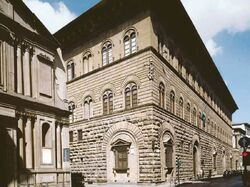
Aquitanian Embassy in Auronopolis, Romaion
The Imperial Embassy in Auronopolis, Rumelia, was built in the year 3222, the same year Imperial Ambassador Johann Wulff presented his credentials to Basileus Konstantinos I. The embassy building is a medieval mansion characteristic of the late 14th century Rumelian Architecture in the heart of Auronopolis'
- Embassy
- Auronopolis
- Honourable Consulate-General (in 3375)
- Arcadiopolis
- Ambassador - None
- Diplomatic Staff - None
- Federal Guards - None
- Outer Guards - None
- Vehicles - None
- Cleaning - Artificial Intelligence Complex called Rom (3375)
Republik Zoozie Aquitanischen Botschaft
The Federal Diplomatic Mission in Jonestow, Zoozie, was established in the year 3110. The Embassy is the most recent addition to Aussenpol's Foreign Embassy Missions. The Entire Diplomatic Mission was transfered from the failed State of Ontario to the new Embassy Building in Zoozie's Capital City: Jonestown. The Embassy has a Gaian Interests Section, which represents the Imperial Sphere Union upon the Zoozian Government and People.
- Ambassador - Erich Adler-Kohler
- Diplomatic Staff - 60 Aquitanian Officials
- Federal Guards - 30 Aquitanian Guards
- Outer Guards - 50 Aquitanian Guards
- Vehicles - 30 Civilian Armoured Vehicles
- Cleaning - Artificial Intelligence Complex called Neue
Embassy Status & Aussenpol Reports
General Warning - A Warning to visiting Civilians of the Danger present in the Entire Host Country
Regional Warning - Cautioning Civilians to Avoid specific Provinces or Territories in the Host Country.
Travel Ban - Life Threatening Danger, Travel is banned for Aquitanian Civilians
| Embassy Location | Status | Travel Advisories |
|---|---|---|
| Ville d'Hermantine, East Heaven | Closed | Travel Ban |
| Saoirsi Buaic, Ardglass | Closed | Travel Ban |
| La Havana, Constantine | Green | None |
| Celestial City, Gaia | Green | None |
| Auronopolis, Ruthenia | Green | None |
| Dinsmark, Belka | Green | None |
| Revolution Center, Mandarr | Green | None |
| Jacksonwille, UCM | Green | None |
| Ostenhertz, Lusitania | Green | None |
| Metudelaishi, Metudela | Green | None |
| Unification, United Republic | Green | None |
| Cale FD, Dyna | Green | None |
| Coronel, Basilka | Green | None |
| Jonestown, Zoozie | Green | None |
Travel Advisory Details
- None at the Moment
Standard Foreign Precautions
Aquitanian nationals traveling to countries without an Aquitanian Embassy must excercise Standard Foreign Precautions (SFP), due to the fact that Aussenpol is not present there to protect them in case of disaster.
Blacklisted or Pre-Conditioned Individuals
Blacklisted individuals are banned from entering Aquitania and will either be sent back by the Border*, Airport or Spaceport Imperial Customs Officer or arrested at the scene (If on the Aquitanian side*). Conditioned individuals or members of certain organisations or families are obliged to sign further documents before entry into Aquitania and presentation to imperial customs officials and are given a more thorough search, customs officials may also reject their entry without any given reason.
Blacklist
- Ichiboros of Constantine
Pre-Conditioned
- Criminal/Corrupt Trafficker Families from Constantine
- Mirellian Government Officials
Aussenpol Reports
- 3103 Federal Report - Aussenpol has stated in a January Council that the re-opening of the Aquitanian Embassy in Ardglass and the permit for the re-establishment of the Ardglassian Embassy in Aquitania, scheduled to be effected in February, will be delayed following the Ardglassian Re-implementation of its Secrecy. "Safety is not an issue when it comes to non-secrecy, since any foreign Intelligence Office can observe details in an info bar of the country, therefore, its just a bad excuse" - Anne Elise zu Brannberg. April 4th Report - The travel Ban effected on Ardglass will not be lifted, specifically after an Airmen incident where a foreigner service pilot was reported dead, Aquitanians are wary of the still lurking Nationalism.
- 3104 Federal Report - Talks with the Republic of Ardglass have resumed and exchange of Embassies is getting ever close.
- 3105 Federal Report - Ardglass has requested the establishment of Embassies in Union Nation, among them, Aquitania and so the Official Re-Establishment of the Embassies was completed in Winter.
- 3121 Federal Report - The Aquitanian Embassy in the Union of Universal has been vacated and its Confidential Documents burned. The Embassy Building was also vacated of important objects, valuable items and furnishings, being flown to Aquitania a day after the December 10th diplomatic break.
- 3125 Federal Report - Aquitania, on the morning of May 3rd, denounced the Universali Government statement and the country's Press that mentioned Aquitania "Sanctioned" the Union of Universal due to Union Federal Council disagreements as complete lies: "Considering the tendency for the Union of Universal to fabricate cow-shit propaganda in their favour, the Aquitanian Press takes nothing from their reports except quotes to mock the Universali Press and have material to sneer at the Universalis" In reality, Aquitania banned Universali products and people because their Government accused the Federal Republic of micromanaging USS Federal Affairs and acting as a dictator, despite having a lot of support and damaging Universali reliability as an honest source of facts for the Federation.
- 3126 Federal Report - On June 20th, 3126, the Imperial Sphere Union was granted in all Aquitanian Embassies but the East Heaven Diplomatic Mission (EHK Already holds an official Diplomatic Mission from the Imperial Sphere Union), the right to allocate Diplomats and Interests Sections to represent their Empire more extensively on White Giant. Aussenpol approved and welcomed the Gaian request immediately.
- 3140 Federal Report - On November 28th 3140, the Federal Republic of Aquitania broke relations with the Union of Universal. The latter as Universal is considered a potential threat possibly breaching into Orbital Space above Aquitania in a near future. Aussenpol invoked a travel ban on Universal in the year 3121, Aquitanians may not enter or fly over Universal and Universalis or their produce may not enter Aquitania.
- 3143 Federal Report - On June 12 3143, after 22 years of Diplomatic Break, Aquitania has allowed the Union of Universal to open an Embassy in Aquitania at their desire and Aussenpol discusses the possibility of opening one in the Union of Universal by the year 3145, the possibilities being very likely. The Travel and Produce Ban Effected on Universal though, is still being highly debated as fears in Aquitania run rampant of the possibility of Universali Officials imprisoning civilians while on their possible stay there. Fears originatiing from a Universali threat of jailing any Aquitanian Civilians in their territory. The possibility of ending a travel ban on Universal is very low for the next two or three decades unless the Union of Universal meets specified guarantees for the safety and rights of Aquitanians Travelling there. Further Developments in the Aquitanian-Universal Diplomatic Quell, specifically the Universali delay of an Aquitanian Investment retractment from the Universali Stock Market has delayed the Embassy re-opening and inauguration to the year 3150 to match the Stock Exchange's delay on Aquitania of re-acquiring complete membership until 3150, as stated in the following extract from the Universali World Trade Center Report: "However, the seizure of Aquitanien assets in the Universali World Trade Center has been disbanded, but Bundesrepublik Aquitanien shall have to wait till 3150 to become a full member again." The issue has also prompted the Senate and Congress of Aquitania to withdraw (after its investment has been retracted and payed back) its membership from the Universali Stock Exchange permanently.
- 3151 General Report - Universal was entered into the Blacklisted Nations category, thereby shutting down any possibilities of reconciliation for more than a century until the next Blacklist Clearing in the year 3260. Later though, Aussenpol determined that Aquitanian Public opinion on Universal was too "Disgusting" to even be held in a blacklist, therefore it was removed, as the name [Universal] apparently offended many Aquitanians.
Public Approval
The Aquitanian Public Opinion of Foreign Countries and Aquitania based on Year round Polls
| Länder | Positiv | Negativ |
|---|---|---|
| Aquitanisches Reich | 91% | 0% |
| Ostlichhimmelreich | 97% | 0% |
| Republik Ardglass | 45% | 38% |
| Vereinigte Gaiasches Reich | 92% | 0% |
| Universal-Vereinigung | 0% | 98% |
| Republik Konstantin | 87% | 4% |
| Kaisereich Metudela | 82% | 0% |
| Republik Dyna | 73% | 11% |
Culture
Culture shows prominent and abundant features of the old Aquitanii Culture, with a light mix of Sevintrian customs, the latter though are not a majority as it was prior to the expulsion of the Imperium because of a process all Aquitanian Kings upheld throught their reign after the establishment of the Kingdom: De-Sevintrianization.
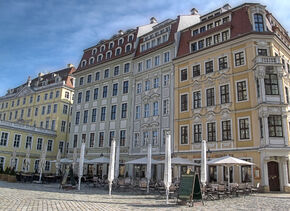
Hannover's Historical Centre, an example of Renaissance Imperial Architecture
The magnificent plains in the Kingdom of Prussia and in the Principality of Savoy, where the wide extended fields of wheat are cultivated, tend to project "golden lands" during sunrises and sunsets, this, along with the rich mines of gold, made golden the national color, which is depicted on the flag today. The fields are a symbol for the Aquitanian people, where songs like the "Blood Stained Gold" and "Defend the Gold or walk on Stone" are traditional folkloric militaristic songs, alluding to the old Military Tradition of Aquitania and to the meaning of the land, further leading to the protection of one's own interests and well, money.
The Aquitanii custom of preparing one's tomb during the citizen's lifetime has been around for millenia and the process beautifies cities and towns, tombs are magnificent temples, usually stored with large amounts of treasure, besides providing public spaces of high respect, they provide the much sought "Passed Wine", being interred with the diseased en masse, up to 2,000 liters in special rooms and courtyards, the wine usually ages for centuries before being taken out for export or local consumption. Modern Tombs are being built as Foyers in Skyscrapers and Great Parks, usually now being transformed into Family Mausoleums instead of Individual Tombs.
Tomb raiding is punished with the death penalty, but raiding is not common, for tombs are usually populated by tourist and strolling pedestrians.

A typical Aquitanian home Interior
Architecture
Architecture in Aquitania is tall, slim and symetric, inspired by the hugeness and grandess of the Aquitanii buildings, modern buildings are usually made completely of glass covering, but the growing tendency to use "Metallic-Glass", allows flexible, white or silverine buildings to be built.
Folklore
Pending
Citizenship

Historic Castle of Hailenberg Town to the Right
Aquitanian citizenship is extremely difficult to acquire, mostly because of Aquitania's renowned citizen policy "Right by Blood". The right by blood only gives citizenship to people that can prove direct Aquitanian ancestry in their blood, or citizenship is given to families that have lived in Prussia for more that 100 years. Immigrant's Aquitanian born children do not acquire citizenship, only a Wohnhaft Einwanderer Passport (Immigrant Resident Passport). Aplicants for the Aquitanian citizenship must speak Aquitanian fluently and must prove prolonged Prussian ancestry or 100 years of family life in Aquitania.
Places of Interest
The City of Savoy is the most popular place of interest in the Country.

Common Aquitanian Enjoying Day of Races or Marathon
In the year 2950, several researchers and Elitetruppen discovered deep road tunnels deep in the Central Highlands, a great discovery as such underground roads were thought to have collapsed long ago. The tunnels go very deep and archaeologists are enthusiastic as to where they may lead. The Large Underground Roads were officially allowed to be used in case of emergencies as a refuge in case of war time or any major threat against population centers.
The City of Königsberg holds an interesting cultural center and historical harbor beside the new port and the famous "Des Königs" District, a very wealthy zone.
Brandenburg has a tradition for parades along its main Expressway Avenue ending in the grand Cuadrate Monument.
Hannover enjoys one of the best wines after the famous Passed Wine, the coastal restaurants and traditional boat restaurants during an evening are typical.
Every small town in Aquitania, in the nearby Duchy of Hesse-Aquitaine and in the State of Aquitania have their own wine making tradition, tourists are recommended to visit both the cities and the small towns to fully enjoy Aquitania and its cultura heritage.
Music

Halengress, a traditional dance native to Wulffbein
Music in Aquitania is central to tradition and custom, the most popular intruments in Contemporary and Ancient Aquitania are the Bagpipes of Wulffbane Wulffpfeife, the horns of Kahltfork Kahlthorn, the Violin and the Harp; along with other mainstream instruments like the Piano and Guitar, the latter which is rarely used. In the First Imperial Age, great composers became wealthy, respected and extremely popular thanks to the Imperial Musical Composition Fund, founded in 1487 in the Kingdom of Prussia and then extended by the Kaiser for the entire Empire once the latter was unified in 1507; with the fund, unlike other countries where most composers died poor and unrecognised, Aquitanians involved with the Imperial Musical Composition Fund were promoted, paid and assisted with their projects via imperial patronage.
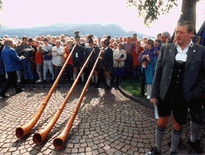
Alrlathanians playing Kahlthorns, Arlathanian Kahlts, Aquitania
The First Imperials continue to be popular today; the Aquitanian Anthem, "Für das Vaterland", was composed in the year 1648 by Marteen Schultz. The most famous composer from the First Imperial Age was Georgius Calenhaad, writing over 28 masterpieces in his life from 1699 to 1774, including the celebrated "Kaiserhymn" or known in accordance to the Emperor in the throne at the time, currently the anthem is sang with Wilhelm VII's nickname, Willie: "Gott erhalte Willie, den Kaiser". Friedrich Wolfesgehl was the most prominent composer during the 19h Century, laying the stepstones to what would later develop as "Swing". Today, foreign pop music is a trend, most predominantly and formerly from Ardglass.
Anthem
| "Für das Vaterland" - Official National Anthem of Aquitania | |
| "Kaiserhymn" - The Kaiser's Anthem & Unofficial National Anthem |
The Imperial Anthem was composed in the year 1648 by Marteen Schultz, the masterpiece was not commissioned, but created by the celebrated composer as a birthday gift to Kaiser Richard III. Later, the anthem was modified by Georgius Calenhaad, with the permission of Kaiserin Elisabeth in 1743 and became what the official version is today. A decade later, another popular anthem, the Kaiserhymn, was written and composed by Calenhaad, it is the Imperial Family's; and more directly, the Kaiser's anthem. The Kaiserhymn was adapted from an Aquitanii Song of Lament, which lyrics' regretted and mourned the loss of the Imperium at the hands of the Sevintrians, the song also idolised the old Aquitanii way of life. Eventhough the words were long lost by the time Georgious adapted it to the contemporary style of the time, it posseses no lyrics other than the single sentence of "God save Fritz, the Emperor" and is therefore traditionally hummed by the average Aquitanian.
Cuisine

Aquitanischenschnitzel
Meat, wine, beer, pasta and "Bolous Crossaints" are the base of all Prussian food, wine is famous worldwide and beer is called the Golden Drink due to it's origin from the Golden Plains. The common cities' cafes are classy places for any reunion or evening chat which are strangely recurred more by tourists than the cities' inhabitants themselves. The General Diet is a combination of Beef, Chicken, Fish and various variations of Vegetables. The Aquitanischenschnitzel is a very typical dish displaying this combination of Diet and is an Aquitanian Cuisine Specialty (Breaded Beef and Vegetables).

Einwienner Coffee
Coffee is very important, as is beer in Aquitania, the most famous Coffee Specialty is the Einwienner Glass, served as Black Coffee topped with Whipped Cream. The Coffee is usually accompanied by Apple Struddel or the such. The Coffee is enjoyed in the cold mornings of June and July (Aquitania is on the Southern Hemisphere of the Planet).
The most famous Aquitanian dish is the Gauldiaan Steak, which consists of meat placed over a flat plate previously filled with spices sauce, along with smashed potatoe topped with asparagus cooked in butter.
Cakes are also famous in Prussia, praised for their delicacy and finery not found in other countries. The Savoyard Tarte, or "Savoyisch Torte" is a small cake served in every coffee house and restaurant as a free dessert.
Aquitania is the country that consumes beer the most in the Planet, with several famous and well renowned brands that are regularly exported to other nations, "Bier Kultur" is a pillar of Aquitanian Culture.
Aquitanian Passed Wine

Passed Wine in Tomb Chamber
The exquisite Passed Wine in Aquitania is famous world wide, the magnificent wine is extracted from the ancient tombs that provide the best aged wine in White Giant, many protectionists fear the wine might dissapear, but the wine is expensive in foreign lands and the "2929 Passed Wine conservation Act" limited exports to only 2,000 bottles a year. The wine is sought in foreign lands by royalty, nobility, heads of state, high ranking officials and all manner of wealthy people; special occasions can lead to gifts ranging above the 2,000 bottle limit, by exporting in barrels instead of bottle boxes, a trick that had gone unchecked by the Imperial Government until 3205.

Prussian and Savoyard Fields such as these produce the wine-to-be
It is simply denoted as Alt-Wein (Literally: Old Wine) by Aquitanians. The finest produced wine is selected at bottling by the Hohensteinburg-sponsored national wine enterprise "Alt-Wein AG". Wine that does not meet certain standards, like something remarking Aquitanian Uniqueness, (Arzeal Boreal Wood Taste, etc...) cannot be buried and is sold in the market as standard Aquitanian Wine. The selected specimens are to be buried in the tomb of a civilian in a special cellar chamber. The burial is archived and later is exhumed after 200 or more years later (up to 1000 years at times), examined by Alt-Wein AG's quality officers and then placed on the market. Golden Letters marking the Wine as authentic passed are in the brand, A-W along with the volunteer family name, usually of noble origin, the most famous passed wine producing family is the von Straslund Family Cript. The wine is the most praised and expensive type for consumers and fanatics in the world and the Centau System. Prices vary abroad and in the country and are usually seperated into price groups, National and Abroad.
The following Prices are in Aquitanian Marks.
| Age in Years | National Price | Foreign Price (In Marks) |
|---|---|---|
| 200-300 | $10,000 Marks | $30,000 |
| 300-400 | $20,000 Marks | $50,000 |
| 400-500 | $40,000 Marks | $90,000 |
| 500-700 | $60,000 Marks | $130,000 |
| 700-1000 | $90,000 Marks | $190,000 |
Renowned Festivals
The most important festivals in Aquitania are the following:
- Feldsmarschfest - Feldsmarschfest is the most widely recognised autumn Aquitanian event in the Centau System, after harvests, Aquitanians tend to hold large feasts in the cities' and towns' beer gardens and halls at the start of the festival, in late March, the festival ends in early to mid April. In every fair, very long tables are arranged in a manner which obliges people to sit with other feast attendees, which provides tourists the opportunity to truly interact with the Aquitanian Culture and Customs. The Fest lasts for two weeks, the best beer in the country, selected from individual, traditional tavern breweries around the country, are selected and produced in large amounts for the main Halls and Gardens, in addition, all manner of traditional dishes are served. The largest fair is in Wulffbein, the city of its origin, to which more than 19 million people from Aquitania and around the world attend each year, making it the largest fair in Centau System, the amount of people are such, that Wulffbein becomes the most populated city in the Empire for two weeks.
- Vereinheitlichung Tag - February 16th, Celebrates the Unification of Aquitania in the year 1507, with military parades, beer garden feasts and procession of the first Kaiser's coffin through the capital and Arkadien.
- Alte-Flaggen Tag - November 4th, A celebration that parades and widely depicts the old flags Aquitania used throughout its history, flying the 3rd Imperial Flag over the Bundesversammlung is the main event.
- Kalenhad Day - Celebrates the Victory of Arlathanian Prince Kalenhad Wolfkehr in the battle of Weissfluss in July 27th, 397, against the Sevintrians. Dancing Halengress while enjoying good wine, beer and seafood in huge halls is the most common way to celebrate this event.
- Alt Befreiung - Celebrates the Liberation from Sevintrians in the year 402CE, the event is very special, commonly celebrated in the cities' harbors in January 5th with fireworks, parades and the final event: thousands of ships painted gold and teeming with light sail away towards the horizon in the evening.
- Hadennentag - A celebration tracing its roots to the ancient Aquitanii Imperium, Aquitanians are allowed and expected to hold feasts and parties for three days, from October 9 to October 11.
- Tag Der Götter - Celebrates the Light Gods in February 7, both Gods expect the people to advance in technology and prestige by making technological displays, most famous displays are in Savoy.
- Marathon Monat - The people tend to celebrate the month of September by running in marathons beside display floats, activities include kayaking down city rivers and car races.
Society

A Typical Aquitanian-Prussian Core Family in Late First Empire Commemoratory Costume during Imperial Celebrations
Since times of old, the Aquitanian Society has been rigidly divided. Ever since the 3030 Republican Uprising, the old Societal System collapsed and the Commoners could enjoy the same equality as their Aristocratic counterparts. The Old Aristocracy though, still allude to the influence and dominant position they assumed in the ages of the autocratic Monarchy, today they are Prominent Families.
There are 3 Majorities and 4 Minorities in Aquitania, the Majorities being the following; Prussians making up 40%, Aquitanii composing 20% of the population and the Ludonnians making up an approximate 20%; Minorities are the Vladehorns 10%, East Heaveners 4%, Constantinians 4% and Ardglassians 2%. Prussians have been dominant ever since the Sevintrian Independence in 402, when Tridius Wolfker, a Prussian, took the throne. Prussians had been under Vladehorn dominion for thousands of years until the official establishment of the Duchy of Prussia, today the Federal State of Prussia, usually going into disputes with the State of Vladien for over who has jurisdiction over East Prussia, a historic Prussian territory.
Prussian Junkers in Republican Aquitania
The most notable Junker families (Aristocrats) which remained in Aquitania or were not killed in the Republican Uprisings are renowned for being influential voices in the Economy, Politics and Mass Media of the country, becoming prominent members of High Society as "Old Money". People well remembering their Noble Status in Imperial and Royal Aquitania. Fifty years after the establishment of the Republic, the Junkers are revered as the symbols of lavish but yet humble lives, which continue to give a percentage of their wealth for national organisations, as well as having no problem in welcoming the very gentry which tried to execute them 50 years prior or made efforts to exile them. Today the most prominent and well known Aquitanian Junker Families are the following:
- von Helggen
- zu Stolberg
- Haggel
- Saxe-Burg
- zu Roth-Scholtz
- Keelstarren
- Weissmarscher
- Courlander
- Bismarck
- Wulffbanii
- Motke
- Adler-Hoss
- von Krupke
- zu Brössberg
- von Küster
- Bachbender
- Wittenberg
- zu Kossel
The People

Aquitanian and Technology
Aquitaines are described as Broad Minded, kind, hospitable and happy people, though history has taught them not to outrightly trust the first stranger that lands at their door. Though they are not at all paranoid people. The Great Schism has placed Revolution as the number one fear in their lists, the Great Schism, which events executed nearly 1 million people, killed over 15 million and imprisoned 2 million people caused this special fear which other nations live through daily and consider normal. Though they wouldn't mind talking about their family's role in the civil war, since they have their family's history documented, every detail, every second of their ancestors' lives. Highly cultural, the people enjoy fine food, museums, art galleries, concerts and indulging in traditional festivals and they will not doubt in taking foreigners to the best exhibitions in the country, inviting them to stay at their house instead of at an expensive Savoyard Hotel, serving them breakfast, lunch and dinner charge free and with the touch of home into every typical Aquitanian meal. Aquitania is considered number one in hospitality, and foreigners have unbelievable times befriending the local Aquitaines, having neighbors discuss with each other over who has him/her over at their house for a day. Restaurants make light discounts on their dishes for any foreigner and tends to them in a more special and specific way than any other customer. Due to the fact that Fast Food is not permitted in the country, Aquitaines enjoy eating at fast food restaurants while abroad, Taco Bell being the favorite of travellers, statistics say.
Aquitanians are also very liberal, the Second Class or Commoner Class is extremely broad minded, tolerant of all attitudes and background that any one has, though extremely loyal to their nation. Aquitaines have national flags on their house, and sometimes boast about the culture of the country and its history. The First Class is as broad minded but more lined up on protocol, they have specific rules when it comes to eating, drinking, greeting, having coffee or daily household affairs. But this does not remove theur hospitality, welcoming all willing tourists to their castle or manor, giving them a light on how they manage the Town/City/Arl/Teyrny, introducing them to the Aquitanian Horse Riding, other luxuries and the Aristocratic Circles.
The people are adhered to the adivise their government gives them, they follow instructions carefully, for the lot of them trust their monarch and Assembly, this saved millions during the HDI 45 Outbreak.
Aristocratic Hierarchy
The Nobility Titles in Hierarchial order are Shown here:
- Kaiser - His Dynastic Grand Imperial Majesty the Emperor
- Kaiserin - Her Dynastic Grand Imperial Majesty the Empress
- Kaiservater - His Dynastic Imperia Highness the Emperor Father
- Kaiserinmutter - Her Dynastic Imperial Highness the Empress Mother
- Prinz von Preussen - His Dynastic Imperial Highness the Prince of Prussia
- Prinz - His Dynastic Imperial Highness the Prince
- Prinzessin - Her Dynastic Imperial Highness the Princess
- König/in - His/Her Highness and Excellency the King/Queen
- Fürst/in - His/Her Highness and Excellency the Prince/ess
- Großherzog/in - His/Her Grace and Excellency the Grand Duke/Duchess
- High Marshall - His/Her Excellency the High Marshall
- Herzog/in - His/Her Eminence the Duke/Duchess
- Arlog/Arlesse - His/Her Noble Eminence the Arlog/Arlesse
- Bannor/Bannerin - His/Her Noble Eminence the Bannor/Bannerin
- Herr/Frau - His/Her Noble Presence the Lord/Lady
- Edelmann/Edelfrau - His/Her Noble Stature the Lord/Lady*
- Edelmann/Edelfrau is a word for Lesser Nobles
Aquitanian Elite / Prominent Blood Families

A Depiction of an Aristocratic Meal in Aquitania
The Business CEO Giants, Scientists, Politicians, Wealthy, Intellectuals, anything with the $$$ sign on it, Famous and Prominent are referred to as the Aquitanian Elite, a specific referrence for old nobility being Prominent Blood Families (Prussian Junkers), which are highly admired by the population, especially Royalists.
Nobility, or as previously known "First Class Civilians" were the sole holders of this title, being before 3030 about 30% of the population. Aquitania had the largest amount of Nobility than any other country in the world, this was due to the fact that Families traditionally kept their Crests and history very well recorded from even before the Sevintrian Occupation, while in other countries, loosing titles was as common as street dogs. Every family in the Country has their own unique story as to how they got to what they are present day. Nobility was strictly traditional and firm with protocol, it was determined that Nobles enjoyed travelling abroad in State and send their children to boarding schools, but they never left their homeland, because of the thought of disgrace. After the Republican Coup, more than 80% of Nobility evacuated to Lusitania, 8% were exiled, 2% executed and 10% remained, their titles stripped and proclaimed null and void.
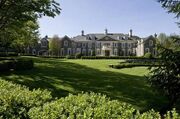
Aristocratic Country Mansion
Nobility was the only class that was allowed to participate in government, apart from the "sole exception" in the late 28th century and beginning of the 30th century. Other unique rights included being able to carry registered weapons in public. If a noble was dishonoured by another noble, in extreme cases, the quarreling was taken to a duel. But the latter had only been reported to happen once since the 27th Century. Dueling or carrying weapons in public is illegal in Republican Aquitania.
Nobility had various luxuries, they may have had several manors, but they usually lived only in one castle or old city manor, where their family had resided for endless generations, these houses are either still occupied by the family (which are now referred to as prominent blood families) or turned into museums of historic culture and life, museums which number in the hundreds of thousands around each city in the country.
Before 3030, one could easily spot a noble in public, they used to travel in large groups of fellow First Class civilians, these groups were known as Aristokratischen Kreisen or "Aristocratic Circles". Notable characteristics of an aristocrat was their High Class Archaic Aquitanian Accent or the fact that they speaked Aquitanii. The Archaic Aquitanian Accent is still conserved and used among the Prominent Blood Elite. Their vehicles usually carried their House flag and emblem, discreetly as to not attract attention, but enough to see them at closer examination. First Class families were very humble, teaching their descendants to respect and treat their second class civilians equally a tradition which had been around since before Sevintria, it was customary for nobility to invite a random Second Class family to their manor for dinner or lunch. In Republican Modern Aquitania, the same happens, just with no titles or such Royal Aquitanian Class Divisions.
Although public and casual life relations with their Second Class counterparts was friendly and calm up to the 31st Century, politics yelled different. Nobility was ever cautious about a Second Class citizen on any government position, since they believed they are the only Class capable of handling such power. The Second Class' attempt to participate more in government throughout the centuries had enlarged the Aristocracy's emnity on this field towards them, blaming them on any internal political crisis Aquitania had experienced in the past. The Advisory Council was the only place where the two Classes could actually discuss politics with each other, fighting was intense.
The Bourgeoisie / The Federals

Commoners live in Old Suburbs and new Apartment Districts of the City
What was called the Second Class in Royal Times is now the power handling and professional class of the Federal Republic. Being the most numerous in the Aquitanian Nation, with 85% of the Population. The Middle and High Middle Class is the Professional Pool of the nation, the hard working and properous people of the Aquitanian Sovereign State. They are the successors of the Royal Second Class Civilians, distinction now banned in Aquitania. More than 80% of the Professional Class is Aquitanian in Origin, either Vladehorn, Aquitanii, Aquitanian or Sevintrian, the rest are Foreigners which enjoy the same rights everyone does. Although before the 3030's a relatively peaceful, humble and generous class, they had been fighting with the Aristocracy for power in Government since the 1700's.
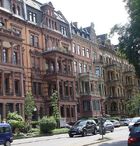
Middle Class Apartments Savoy Lowlay Districts
Throughout history, revolts and outbreaks of Revolution caused by Foreigners of the Third Class wishing change to their rights (wanting more power) and in the crisis, spewed with lies of enemies of the monarchy in government, the Second Class Citizens joined in. Second Class citizens though enjoyed having nobles visiting them in their households, hosting meals and such. Being very humble, they welcome foreigners in their homes as exchange or immigrants until they find a home themselves. This is what the Federal Cultural Insitution calls the Essence of the Aquitanian Culture.
Tourists and Business Foreigners
They have the most special privilagesin the country, they are literally comforted by the General Population, treated more kindly by the populace and with a feeling of specialness, given discounts at stores and their right to reclaim all taxes in the Duty Free Shop at the Airport or Naval Port or at special offices in Land Border Crosses.
Undesirables
The previously referred to as "Fourth Class People" are prison convicts and other criminals serving in a City or Duchy Prison. They may be used for work force, though not to serve personal needs of any civilian. They are the man power of the country. They work the fields, construct buildings and work in mines.
Demographics
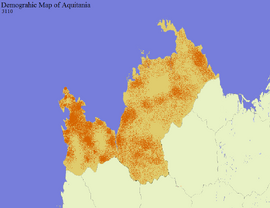
A 3110 Demographic Map of the Country
Aquitania has a population of an estimated 95.5 Million as of 3232, a statistic which has grown considerably over the past decades due to territorial acquisitions and other more unfortunate events, like war. Aquitanians compose 80% of the population and the largest minority are the Oirthir, from East Heaven, which compose 8% of the population. The country does not have a history of being multicultural, but in the 31st and 32nd Centuries, the country's face changed considerably, not as a melting pot, but as a place where one can find several cultures working together.
Ethnic Groups
Aquitanian

Anne von Hammsark, Aquitanian Aristocrat and Socialité
The largest Ethnic group in Aquitania are the Aquitanians. They encompass 76% percent of the total population. The characterisitics of this ethnic group are their white skin, tall height and their hair and eye color, mainly blonde and blue, respectively, brown/black hair and eyes are rare with the exception of those of other ethnicities, therefore these characteristics are considered rare and very beautiful by the average Aquitanian. Aquitanian women enjoy dying their hair brown, red or black, this being a fashion trend. Aquitanians have a sub-group, the Vladehorns, these people live in the Highlands but share a common ancestry with Aquitanians, these people originated from the Vladien Region. The Aquitanians are direct descendants of the Aquitanii, which ruled most of Southeastern Auriga for millennia from their seat in Vanashel, present day Arcadia. Eventhough throughout most of the Medieval Era Aquitania was divided into multiple Kingdoms and independent states, the people were the same, and many desired a Pan-Aquitanian unified Empire, something accomplished in the year 1507. Tridius Wolfkehr was credited with starting the Pan-Aquitanian movement in the immediate years following Independence from Sevintria, he is a hero to the Aquitanian People.
Oirthir

Kaiserin Maya Elizabeth I was of Oirthir Ethnicity
The second largest group in Aquitania are the Oirthir, or East Heaveners, being 10% of the population. In the 3238 November Census, 10,026,058 million people registered their ethnicity as Oirthir. The Oirthir usually reside in the coastal cities of Highpeak, Königsberg, Savoy, Arcadia, Avaris, New Alexandria and Highever, major urban centers and cultural hotspots. The Oirthir are noted for their tall stature, red and light brown hair, white-pink skin and their green eyes, Aquitanians commonly have blue eyes. The Treaty of Close Friendship between the two countries had eased the Entrance and Acquisition of Citizenship for East Heaven civilians in the past, having homes in Aquitania was also possible to them without the need to have citizenship. The occupation of the Eastern Heaven homeland brought many East Heaveners, in their majority members of the nobility, to the country. The evacuated and refugees were given special resident status, enabling them to have all the benefits of a citizen without the need to pay specific taxes; the benefit though gradually went null for third generation Oirthir immigrants, the grandchildren of the initial refugees. Aquitanian officials though feared assimilation and openly promoted and embraced an Oirthir Agenda, leading to the successful creation of Oirthir towns and cultural centres. Currently the state with the most Oirthir is the Principality of Savoy, accounting for half the population.
Yutschek
The third largest are the Yutschek, compromising 5%, which live in the southern tip of the Empire in the Grand Duchy of Greater Yutschenia, the Duchy of Upper Yutschenia and in the Province of Moravia in the Kingdom of Kaledonnia. They form a majority in the City of Prague, a city with special status within the empire and that, along with the aforementioned provinces, incorporates official bilingual signs in both Yutschek and Aquitanian. This group was incorporated suddenly into the Empire by the annexation of Kaledonnia in 3184 and now compromise a vital part of the southern economy of Kaledonnia in the designated "Prague Industrial-Economic Zone" (Prag Industrie-Wirtschaftszone). Most resistance during invasion came from this particular group in 3184 and the fact that they continue to push the Aquitanian language and way of life aside fuels tensions between them and the Aquitanians. Kaiser Friedrich II took caution in placing only Ethnic Yutschenians as Chancellors of Kaledonnia and filling some posts in the Chancellery with Yutschenians as well. Compared to past Kaisers, Friedrich was particularly lenient and pro-Yutschek.
Ardglassians
The fourth largest group in Aquitania are exiled and refugee Ardglassians, which compromise 5% of the population. Ardglassians usually live in the mountanious states of Weissland and Asterein or in Alexandrien, which has a combination of mountainious and sea topography. Their choice, according to the Imperial Office of Statistics, reminds them of home. A substantial number of Ardglassians live in the Cities of Savoy, Arkadien, New Alexandria and Königsberg.
Meiji

Meijibezirk, (District of Meiji) in the City of Savoy
The fifth largest ethnicity are the Meiji, which emigrated from the Kingdom of Meiji in the Lusitanian Empire, they make up 3% of the population and live exclusively in major cities, most popularly in Meijibezirk (District of Meiki) in the City of Savoy.
Other
The remaining 1% are a mixture of Gaian, Constantino, Benino and Basilkian people, they are scattered throughout the major cities, Königsberg being their most prominent city to live in.
The Vladehorn are categorised in the same ethnic group as the Aquitanians are but they have their own language and customs.They usually live separately from the ordinary, highly urban Aquitanians, away in the countryside highlands or in their own city sector, the famous Vladehorn Districts (Aquitanian: Vladhornbezirken). Vladehorns enjoy living in their highlands herding sheep and having simple and traditional lifestyles, some villages tend to move around in a partial, nomadic style around the Weissland and Asterein Highlands. Aquitanians and tourists alike seek these villages out for their hospitality, tradition, mysteries and lore. The Fluteskarr, an instrument similar to the bagpipe, is extremely popular in their villages.
Language
The official language of Aquitania is Aquitanian (Aquitanisch). The Imperial Aquitanian Academy is an Imperial Institution officially tasked with overseeing and preserving the Aquitanian Language. It is based in Königsberg. Eventhough Aquitanian is the sole official language in the reich, every Aquitanian is atleast quadrilingual by the age of 18, students are encouraged to learn more than three languages during school and more in their lifetime; hence why several languages are spoken by a considerable percentage of the population, from Frisian, to Oirthir. A great majority of Aquitanians have knowledge of Oirthir, the most widely taught and learnt language in the Empire on a par with Aquitanian, Oirthir though remains in status as a Recognised Regional Language.
Aquitanian is an Auralian Language and so can be similar to the most popularly spoken minority languages in the country: Aquitanii, Vladian, Frisian, Bennish, High Aquitanian, and Prussian.
Aquitanian is spoken by 95% of the population and is the sole language taught in schools in a mandatory fashion except in the Grand Duchy of Greater Yutschenia, the Duchy of Upper Yutschenia and the Province of Moravia in the Kingdom of Kaledonnia; where Yutschek is the Official Language. Languages that are also included in school curriculums as optional choices are Oirthir, Old Hermanian, Standard Gaian, Hibernian, English, Hellenic, Portuguese, Spanish, Meiji, Yutschek, Azurni and all the aforementioned minority languages within Aquitania.
| Language | Speakers by Percentage |
|---|---|
| Aquitanian | 98% |
| Aquitanii | 79% |
| Prussian | 37% |
| Vladian | 28% |
| High Aquitanian | 8% |
| Bennish | 6% |
| Yutschek | 6% |
| Frisian | 4% |
| Foreign Language | Speakers by Percentage |
| Oirthir | 95% |
| Old Hermanian | 70% |
| Spanish | 52% |
| Meiji | 32% |
| Hibernian | 12% |
| Portuguese | 10% |
| Azurni | 8% |
| Standard Gaian | 4% |
| English | 1% |
| All Foreign and Minority Languages Spoken in Aquitania are Taught in Schools as optional courses; Aquitanian is the only mandatory class | |
| Minority Languages Spoken in Aquitania | |
| Foreign Languages Spoken in Aquitania | |
Migration
Inner migration tends to show people moving from west to east towards the less populated Kingdom of Wulffbain and the Grand Duchy of Alexandrien. Immigration to the country from abroad continues at a steady 3,000 people per month entering the country legally.
Living Abroad
Pending East Heaven
The Kingdom of East Heaven has the highest number of Aquitanians living abroad, it is the closest ally of Aquitania and currently has an estimated 5,000,000 Aquitanians living within, primarily in the City of Ville de Hermantine, the City of Veluca and its surroundings, the City of Radiata and the East Coast of the Western Duchies. East Heaven is the most favoured country by Aquitanians to live in, being also the number the #1 touristic destination for Aquitanians. The East Heaven Royal Family is nearly as revered as the Aquitanian Imperial Family and many visit with the sole purpose of witnessing Royal East Heaven events. Dozens of cultural, research, sport and educational student exchange programmes exist between East Heaven Kingdom and the Federal Republic of Aquitania.
Constantine
The State of Constantine, shrouded in the mists of Civil War, was once home to 2,489,000 Aquitanians, but after 3077, all but the Embassy Staff evacuated, which makes the number of Aquitanians in the Capital of La Habana number at 120, 101 diplomats including the Ambassador and 19 Registered Aquitanian reporters for the Boxer War. Intervention Forces are scheduled to Occupy the historic Province of Lothringen in 3115.
Following the 3115 Occupation of Lothringen, Aquitanians emigrated to the historic province in clusters, the first being in 3130, a second cluster in 3135 and the final and third one in the year 3145; this despite the fact that the Historic Province would be returned to Constantine in the year 3150. By 3149, 524,000 Aquitanians of the total Lothringen population of 1,022,000 were living there, but half are presumed to return to Aquitania when the region is given back to Constantine in 3150.
Major Cities
See also: List of Cities and Towns in Aquitania
| Largest cities or towns of Aquitania | ||||
| Rank | Name | Länder | Population | |
|---|---|---|---|---|
| 1 | Sawoie | Fürstentum Sawoie | 10,590,700 | |
| 2 | Neue Alexandrien | Großherzogtum Alexandrien | 9,730,340 | |
| 3 | Königsberg | Königsberg | 6,670,800 | |
| 4 | Brandenburg | Königreich Preußen | 5,350,680 | |
| 5 | Preutterdam | Königreich Preußen | 4,670,340 | |
| 6 | Straßburg | Königreich Preußen | 2,590,120 | |
| 7 | Straußstadt | Königreich Ludonnien | 1,770,000 | |
| 8 | Awariss | Königreich Vladien | 1,550,000 | |
| 9 | Arkadien | Großherzogtum Arlathien | 1,340,000 | |
| 10 | Prag | Königreich Kaledonnien | 1,190,000 | |
Geography
PrussianAquitanian geography varies, it ranges from boral forests to the golden plains and the northern highlands. Aquitania
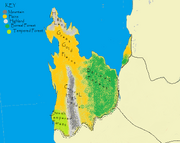
Prussian Geography Map
has it's famous Golden Plains and its cultured Boreal Forest and Northern Highlands as national monuments, the landmarks are unique to Aquitania.
The Sevintrians chose the Sommathian peninsula as the center of their colonial population and colonial military command because of it's fertility and strategic/defensible location.
The fertile central plains are the bulk of the Aquitanian food supply and touristic sunset attractions, which include several ruins. The central Mountains are known for being both deadly and beautiful, their valleys attract sky diving, ski tourism and archaeologists to the local desertic temple ruins.
Economy

Savoy, Financial Capital of Aquitania

$20 Mark Bill depicting Kaiserin Maya Elisabeth na Colliete
The Aquitanian currency is the "Aquitanische Mark" represented by a "AM ", one Aquitanische Mark is equivalent to 100 Pfennige, formally "Apfennig" represented by a "₰ ".
The Economy of Aquitania is, in the West, primarily based on High Tech with a few companies producing Chemicals and other dedicated to Mining. The Administration of David Krössberg pushed the country for higher Technological Production, rather than having the country export raw or manufactured produce, like in the past.
Aquitania also has a very high Social Security Index, along with a great Infrastructure. The country enjoys major influx of Tourists which are naturally attracted to the Legendary Aquitanian Culture. The Königsberg Staatstadt, East Prussian Beaches, West Vladien and East Highpeak Warm Beaches attract a lot of people to the country. While the Financial Capital of Aquitania, the City of Savoy, is also the Nightlife City of the Nation, with over 10,000 high end clubs.
The Federal Bank issues new bills and mints coins in the City Mints of Savoy, Brandenburg, New Alexandria and Preutterdam.
The Reichskritin Rk 1500-2114
The Neue Reichskritin NRk 2114-2492
The 5 Currencies 2492-2809
During the great schism, 5 currencies were introduced by seperate and rival governments throughout civil war Aquitania. The Neue Reichskritin NRk hyperinflated in 2485 and the issue peaked in 2492, the year it collapsed, being cheaper its use for fire and warmth during the fierce winters in the war than for buying anything. The Holy Mandate in Weissleuchte Stadt introduced the Heiligen Thaler (Holy Thaler) as official tender in 2488 in its territories until its collapse with the fall of Weissleuchte Stadt in 2723, coins were minted in aluminium and copper; it was not recognised as official tender in the Imperial Capital or in the short lived Republican Government. The Vorläufgulden was introduced by the Emergency Imperial Government and remained for the rest of the conflict as official Imperial Tender (per se). The autonomous states of Asterein and Weissland issued their own currencies during the conflict, namely the Astermark and Weissthaler respectively, they were the most stable of the currencies in the civil war, later decommissioned in 2809 after rejoining the Empire. Currency in the Aquitanian Territory during the war was rarely used, the Vorläufgulden was inflated and the Heiligen Thaler could only be used in Weissluechte Territory, which demanded citizenship proof and further ethnic documents to actually use, making usage exhausting as currency and purity officials were in markets and other places of commerce. Weissleuchte Territory shifted continuously and so continued usage in the same location was impossible other than in the capital itself. Exchanging goods was the most relied upon basis for substenance rather than the usage of official currency, especially in the dread extensions.
Kritine K 2809-3030
The Kritine was an Aquitanian currency used from 2809 to 3030 in the Second Aquitanian Empire, the Hegemon Kingdom of Prussia and the Second Kingdom of Aquitania (First Hegemon Aquitanian Kingdom). The Kritine's exchange rate was set at 1 Kritine per 5.8 Constantinian Pesos & later at 1 Kritine per 1.5 Ardglassian Denarii. In 3030, one billion Kritines (One million million) were equal to 1 Bundesmark.
Bundesmark BM 3030-3215
The Bundesmark was arguably the most successful and popular of the Aquitanian Currencies, introduced in 3030 to replace the hyperinflated Kritine, it was used from 3030 to 3215 in the Third Aquitanian Empire. The Bundesmark's exchange rate was at 1 BMark per 7.8 Constantinian Pesos, 1 Bmark per 4.50 East Heaven Oirspeirars (Óir Spéir Ar), at 1 BMark per 2 Ardglassian Denarii and 1 BMark per 11.50 Metudelian Yans in 3160. In 3215, one milliard (One thousand million) BMarks were equal to 1 Aquitanische Mark, the replacement currency.
Aquitanische Mark AM 3215-Present
The Aquitanische Mark was introduced in 3215 to quell the sudden hyperinflation of the Bundesmark, its exchange rates are at 1 AMark per 12.50 Constantinian Pesos, 1 AMark per 15.80 Metudelian Yans, at 1 AMark per 100,000 Ardglassian Denarii and 1 AMark per one milliard (1,000,000,000) East Heaven Oirspeirars (Óir Spéir Ar).
Tourism

Himmelsschloss Resort, Pfalz-Strelitz, Prussia
Aquitania is a touristic hotbed in the South-Eastern Hemisphere, it is a significantly attractive country based on polls in the Auriga Bella Continent due to its thousands of historic and natural attractions and the people's general hospitality and admirable culture.
Aquitania holds beautiful beaches in most of its Coastline, the most popular among foreigners and locals alike being the Hannoverian Riviera in Pfalz-Strelitz, Prussia. One of the most beautiful resorts, the Himmelsschloss, dating back to the Aquitanii Times is built there, initially as an enclave and winter vacation spot for the Aquitanii and Old-Prussian Aristocracy.
Tourism is a vital and high renevue industry in the country, amounting to 15% of the national income.
Financial History
3031-3158 Economic Prosperity
Aquitania enjoyed heightened economic prosperity and growth from the end of the Republican Uprising and the establishment of the Bundesbank and Bundesmark. The period was marked withgrowing foreign investment into Aquitanian Corporations and companies, while Aquiania slowly began to invest in foreign markets and nations, mainly allied nations.
3157-3167 Economic Recession
Aquitania suffered a short lived recession late in the year 3157 and early to mid 3158 when a series of combined factors; including low demand from the World Market, the light 3156 Earthquake and the International Monetary Fund's ejection caused a crash in the Savoy and Brandenburg Stock Exchanges. The Recession involved an all time low of national productivity, income and a general GDP per Capita drop, the most severe since the 3028-3030 Hyperinflation and Depression. Many corporations and one third of the industry in the Houldt Region in West Aquitania was closed down and moved away to Foreign countries and two Industrial Plants were destroyed in the 3156 Earthquake. The same year in Summer though, a huge reconstruction programme, the incorporation of the Ceres Autonomous Region into the ECT-2 and re-industrialisation of the Houldt Valley was pursued by Kaiser Friedrich II and his Finance Minister Wolfgang Dezius, making this the first challenge to young 16 year old Kaiser Friedrich II. The worst of the recession ended in the Autumn of 3158 and the economy was in gradual growth by November. The recovery though, was slow and the employment and share crisis still needed to be resolved.
The Imperial Government passed several measures inthe year 3160 through the Bundeskongress to resolve the share crisis, which allowed the Financial Ministry and Imperial Investment Fund to show more focus on Gaian Corporations in the Ceres Autonomous Region over the unpredictable safety of Ardglassian Corporations. Although the decision was unpopular with senior Financial Officials and Entrepreneurs at the time, the measures received a unanimous boost in popularity in the 3164-3165 Pegersian-Ardglassian War, which caused the closure and destruction of many Ardglassian Corporations during the war and in the following years. The economy regained its pre-recession strenght by 3163, a year later though, the Savoy Stock Exchange nearly suffered a crash after the eruption of war between Ardglass and Pegersus, more specifically after the fall of the former. In 3165 though, the financial situation in Aquitania enjoyed of historic high profits after the fall of Ardglass, "Strangely" as put by the top Financial Minister. The recession ended 2 years later with the fall of unemployement and restoration of many corporations that were lost in 3156 and 3157.
3167-3188
As a result of the Pego-Ardglassian War of 3164, Aquitania began to feel the effects of the fall of Ardglass in the year 3170, event which began to slow down, yet not depress, the Aquitanian Economy. Ardglass' occupying powers did not destroy nor close most of the corporations where Aquitanians owned significant shares and so the share market was not severely affected. The loss of Aquitania's largest export partner though definetly brought radical effects upon trade. Several Ardglassian corporations in Aquitania were forced to close and many Aquitanian corporations in Ardglass withdrew.
The defeat of the Union in 3175 and destruction of East Heaven and Benino blocked any measures taken by the Imperial Government to restore the pre-Ardglass war income, which had already declined by 55% since 3164, GDP growth had declined to 0.2 from 8.5 in 3175. The heavy influx of war refugees from East Heaven, Aquitania's closest ally, aggravated the situation, in the short term, homes and supplies were necessary for the struggling population but greater problems were being forseen by Economists and Financial Experts. The advice and warnings though did not prompt any response from the Kaiser or Imperial Government to curb the mass immigration, as the nation was compelled to help it's closest allied people.
The end of the war did not end with the Federation's surrender, being it among the reasons for the outbreak of the 3175-3198 world war. The Imperial Government though, then at the lead of The Union, pursued a strict policy of neutrality and reconstruction for the membership, the period of peace saw GDP growth go up by 0.9 (to 1.1), an extraordinary achievement, considering the Federal and world situation. The stock market and Bundesmark continued to fall though, in a sign of obvious post-war decay. The country and The Union enjoyed 13 years of peace in which carefully elaborated diplomacy prevented conflict until 3188, when the Pegersian Empire, major combatant of the war, declared on The Union for the second time.
3188-3210
The second war declaration was followed by swift allied defeats on the Basilkian front and a quick ceasefire was negotiated by Basilka and Aquitania. The demands in 3189 were diplomatic and trade isolation for the Aquitanian Empire, hence it was demanded that Aquitania be evicted from the Federation and Common Market, a clause that was unanimously rejected by the membership. The peace negotiations caused the Bundesmark to fall and the stock market to strain significantly, while it stabilised for the rest of the crisis, growth halted completely at 1.1. The Imperial Government, in emergency meetings, decided that a withdrawal was necessary for the security of its allies and so withdrew in the year 3190 from the Federation and in 3192 from the Common Market. Economic catastrophe worse than that of 3028-3030 was predicted immediately after withdrawal, but the Bundesmark and Stock Market remained stable throughout the decade, growth also remained stagnated for the rest of the 90's, which made most people extremely anxious towards the start of the 33rd century.
Fears felt in 3190 over the well being of the national economy materialised in 3202 when the stock market crashed and the Bundesmark fell to disastrous levels, at 1.37 Metudelan Y per BM (compared to the 11.50 MY usually paid per Mark in 3160). The refugee influx from 3175 to 3180 triggered an education crisis in 3205 which destabilised most of the working force, this is mostly attributed to the fact that the Imperial Government became deadlocked in 3202 over necessary economic, health and educational reforms; a problem which Kaiser Friedrich II tackled by overruling the Bundesversammlung in the year 3206 and establishing Imperial reforms himself, a rare move, as the Kaiser rarely intervened in lesser Government Affairs and Administration. GDP growth in 3206 was at -2.3 and income had declined by 75% since 3164. The Bundesmark inflated in 3209 and the country risked a currency replacement if the situation did not stabilise by 3212. Several proposals for a new currency before the hyperinflation loomed and overwhelmed the delicate economy were presented to the Kaiser, Dyranttag and Bundeskongress from 3210 to 3215, the year when the Aquitanische Mark was finally chosen as a replacement currency, exchanging at 1 Aquitanische Mark per 1 milliard (One thousand Million) Bundesmarks.
Infrastructure

Karolinska Hospital in Lower Savoy
Aquitania holds a highly developed system of transportation, energy and distilled tap water production, ranking high in the world.
The Healthcare system is also in world high standards, with the most Modern Hospital in the Continent considered to be the Karolinska Hospital in Low Rise Savoy, thousands of foreigners fly in to get treatment in this very cheap and highly prestigious Medical Giant.
The railway system is the most widely used by passengers, followed by airliners, private vehicles and finally trans-oceanic ships and other water ways.
Telecommunications
The Aquitanian communications network is managed by AQTelekom, a previously state owned communications giant founded in 1975, in New Alexandria. Today, digital and holographic information reach every corner of the Empire and Great Palms thanks to a carefully maintained and groomed monopoly by AQTelekom. Following the break out of war in 2467, the corporation moved its headquarters to Prague, Yutschenia and continued its operations there until moving back to New Alexandria, its HQ, in 2810. Unlike its competitors, AQTelekom works with a completely wire free network, nevertheless, it has over 45,000km of fiber optic cable in the empire alone and over 97,000km of the same wire in Great Palms standing by incase a switch to wired technology is necessary. Broadband wired penetration in the country is at 42% and the amount of fixed wired subscriptions is at 76,873,773 as of 3230; the percentage of broadband penetration regarding wireless devices is 102%, or 96,485,942 subscriptions. Usage of mobile phones and other handheld communication devices is a staple of Aquitanian society, with many people opting to open more than one subscription for themselves.
Media
The majority of Aquitanian media outlets are private owned; television, holographic and radio networks are numerous and the only state owned outlets are those used in emergencies (e.g. Beratend Warnungen "Advisory Warnings") or the AQNachricht, the state owned news reporter. Popular news outlets include the Weisshaupt Zeit and the Vorweltszeit.
Transportation

The Highway System of Aquitania is vital for the economy, having wide Highways, like in the image above, South Savoy
The Railway System has been the preferred method for travel in the country for more than a millennium and is easily the most advanced in the planet. The Highway System is far more ancient and is utilized by a considerable percentage of the population, mainly in the Eastern Mainland. The Elevated Highways (Hohenautobahnen) make the highway network very safe, fast and comfortable.
Reichsautobahnen

An Ancient Aquitanii Tower Fortress and Elevated Highway near Hannover
The Highways and Expressways of Aquitania were first built by the Aquitaniis millennia ago, as Imperial Roads that were elevated to provide a safe and lit path for walking and riding travellers. The feat of building 90,000km of elevated, stone-made roads in the entirety of the Imperium was expensive and was in constant progress, there were 20,000km of elevated highways in the territory composing Aquitania today alone. The project was halted with the Sevintrian Invasion, and many sections were left unfinished in the far reaches of the Imperium, but the legacy survived and its succeeding states, specifically Aquitania, continued to use the roads well into the 20th century, until it was replaced by the Reichsautobahns and the new Elevated Highways in the 1930's. Many of the ancient highways are now protected or lay in a state of ruin.
The old highways have been largely replaced by their modern counterparts, the Autobahnen and Hohenautobahnen (Highways and Elevated Highways respectively). The Autobahn Network has a length of 12,890km and the Hohenautobahn Network's length is of 17,750km. The Network as a whole is referred to as the Reichsautobahn, and is one of the longest in the world.
Hohenautobahnen

HA-5 Entering the Arcadian Outskirts
The imperial elevated highways are the most used and prominent type of highways in the Empire, they are based off the old Aquitanii Variants and are safer and more comfortable than its standard low lying counterparts. The ancient variants are referred simply as Imperial Highways, alluding to the Aquitanii Imperium. The Highways are permanently lit during the night thanks to solar plasma technology adhered to the concrete, which collects energy from the sun and the heat generated by the engines and tires of commuting vehicles, excess energy is sent to nearby cities and towns. The Highways are designed to not swerve suddenly or unexpectedly and usually go through obstacles rather than circumvent them, thus avoiding the hazardous curves that are associated with accidents in ordinary highways.

HA-81, flowing over vegetation, Ends at the Aquitanian-Constantino Border
Environmentalists praise these type of highways for their discretion towards the environment, sound is isolated and animal migration routes are not cut off. Speed limits are non-existent and a 90km/h limit is only compulsory for buses, cargo trucks and hauling vehicles, which commute on the lane to the far right. The standard, recommended speed is 140km/h. The elevated highways have a total of 6 lanes and exits and entrances have long ramps to allow safe deceleration and acceleration. Foreigners are usually instructed about how to travel in the Aquitanian Highway in courses at any local Office of Traffic Authority building or an Aquitanian Embassy and Consulate if abroad. By Imperial law, Elevated Highways cease to be Elevated Highways in all but name after entering a city's outskirts (or on approaching an international border), the Elevated Highways have designated exits for small townships and villages, but the highway doesn't return to ground level when approaching these. Note that all city rings have some elevated sections, but are considered Elevated Highways regardless.
List of Elevated Highways in Aquitania
- HA-1 Savoy - Königsberg
- HA-1-1 Königsberg Ring
- HA-1-2 Savoy Ring
- HA-20 Savoyard Elevated Coastal Hwy
- HA-30 King's Elevated Coastal Hwy
- HA-4 Savoy - Brandenburg
- HA-4-1 Brandenburg Ring
- HA-5 Awariss - Arkadien
- HA-5-1 Awariss Ring
- HA-6 Arkadien - New Alexandria
- HA-6-1 New Alexandria Ring
- HA-6-2 Arcadia Ring
- HA-7 Wulffbain - Arkadien
- HA-8 Wulffbain - Lutonnien
- HA-9 Lutonnien - Neue Alexandrien
- HA-10 New Alexandria-Immerhoch
- HA-11 Awariss - Junebelst
- HA-12 Preutter Elevated Coastal Hwy
- HA-13 Straussstadt - Preutterdam
- HA-14 Brandenburg - Strassburg
- HA-40 Vladisch Elevated Coastal Hwy
- HA-50 Alexandrian Elevated Coastal Hwy
- HA-60 Gulf Elevated Coastal Hwy
- HA-70 Strassburg - Heiligessankt
- HA-80 Heiligessankt - Alssab
- HA-81 Alssab-Heiligessankt - Alssab Border Crossing
Railway

Mixed Car, Cabins and Standard Seating, Second and Economy Class Respectively
Railway is the most important civilian transportation means in Aquitania, used for both inter-city and city travel, the Bundesreichsbahn (BRB) is the defacto passenger line company and is hubbed in the City of Savoy.
In the year 3134, the Federal Imperial Government decided to replace the old railway system of Aquitania with the Lusitanian equivalent, the results were faster, modern and more comfortable travel, the rail line gauge had to be modified into wider versions to fit the larger, faster trains. The project cost several billion Aquitanian Marks.

Front View of an Control-Engine Car and it's First Class Cabin on the Second Cart
Becoming the fastest trains available in the Continent when introduced in 3134, travelling in speeds of up to 700 Km/h, its the fastest and cheapest transport means in Aquitania, hence its usage by most tourist foreigners and the majority of Aquitanian Nationals over the Airplane.
Self sustained on accelerated particles which are produced with sunlight, the trains are more affordable and above all, a clean way of transport, the Federal Government and Kaiser Wilhelm IV funded the project.

First Class Cars, Frequented by the Aquitanian Prominent and people who can Afford it. Passed Wine Bottles are always included
The national Aquitanian lines are the most widely used method of transportation, national and international bound lines are used by over 80 million people per year, the Bahnhof in the City of Strassburg serving over 20 Million people a year and Savoy serving 30 Million. Each individual line, for example Savoy to Strassburg are managed by individual AIs, this specific one called S-SB/Pr. Line AIs communicate with the departure City AI and the Destination City AI to calculate timing, transfer upon arrival and any shift or deviations the train might require to do before arrival. The process mentioned above is done in less than a second. In the case where the destination city has no AI, for example La Habana or some international destinations, the AI simply transfers and communicates with a controller, this process takes longer, but the large distances gives the data transfer plenty of time to kill, for some trains take 7 hours (Savoy to Ceres City), while others might take 3 hours (Strassburg to La Habana). Arkadien to Königsberg may take 4 hours and Weissert to Preutterdam consumes another 4 hours. Though the trains are built and designed to be comfortable, the views are enjoyable and awestriking; and the train serves its passengers with first class service, unless you buy a First Class Car Ticket, which gives you near royal treatment.
The new Mercury-Class Trains are the most luxurious in the continent as well, entire cars for people who could afford it (about seven cars of this type in a Train), special cabins mixed with normal seating in cars and normal seating. The Mercury-Class Train has very large windows which the passengers can enjoy, if the sun has become too uncomfortable, passengers may tint their windows darker and completely block the annoying brightness without blocking the view. Cabins are crystaline, but the passengers may tint them as well to have privacy if desired. The large windows from the outside appear as standard rectangle windows, for asthetic purposes.
Space

Brandenburger Skyscrapers and Space Tether

Brandenburg-Helggen International Spaceport Observation & Public Information Deck
The Empire has one of the most modern space infrastructure and transport facilities in the planet, kicking off in 2914 under the then dominant Kingdom of Prussia, the endeavour marked the second space programme in the nation's history, 877 years after the first one, which collapsed in its entirety during the Great Schism.
The current existing and busiest Aquitanian Spaceport is in Brandenburg,it is directly linked and works alongside the ground Brandenburg-Helggen International Airport. The city, recognised for years as a National and International hub was chosen in 2462 to host the first Spaceport in the world, but planning and construction were halted when the Great Schism began just five years later. During the Second Empire, in 2842, 380 years after the initial proposal, a second proposal was made, but was brought down by then Kaiser Richard VII citing a lack of resources. (Second Imperial Aquitania had a chaotic economy, an echo to the recently put out First Schism).
After the Second Schism, Kaiser Friedrich Wilhelm the Great proposed and set forth the project immediately in 2914, the Tether was to be built in Space, to then be lowered slowly to the gigantic anchor at the heart of Brandenburg International. Construction took 50 years, but anchoring the tether to the planet's surface took 4 years more, reasons being the ships needed to lower the heavy Tether into the surface with precision did not exist in 2964, the year the Tether and the Spaceport were finished. The Spaceport and Tether were inaugurated in the year 2970.

A Spaceport Hotel Room, usually used by Travellers who have been stranded by their Liner
The Brandenburg International Spaceport, later renamed Helggen-Brandenburg International Spaceport in 2975, began serving the Aquitanian Colony of Napolette in Kebir Blue, also chartering to Little Upsilon to a lesser extent. The Spaceport at the time served in its majority the commuters from Lusitania when the New Highever Space Tether and Port opened in Altehaupt; people travelling back and forth from the newly discovered planet Aries during the 30th Century was also prominent. The Spaceport though mainly served recreational cruisers, which toured nearby nebulas, asteroids, moons and planets for visual entertainment. The establishment of relations between the Imperial Union of Gaia and Aquitania allowed for increased interplanetary traffic. The establishment of relations with a space faring nation provided Helggen-Brandenburg International with the millions of passengers and goods that to date transit through the busy installation. The Aquitanian Air and Star lines with Terminals at Helggen-Brandenburg International are Luftheiss, Avalen, Preutternord, Wosse and Delmach.

Luftheiss Terminal D
Air
Luftheiss Airlines is the principal Airline of the Empire, serving all International Flights and based in Savoy-Hohensteinburg International, founded in 1922, it is the oldest Airline in the country. The Airline's original Headquarters were destroyed when the Zealot Army captured Arkadien in the Great Schism and has subsequently been rebuilding and being destroyed countless times in history since its foundation. The most recent rebuilding was in 3061, after being neglected after an attack on the Savoy-Hohensteinburg Airport in 3031, during the Republican Uprisings. Avalen airlines is the most important in the Aquitanian realm, hubbed in the City of Arcadia, Arlathan. In Arcadia's Tridius International Airport, it serves national travel between the Kingdoms and Duchies of the Empire, extended International Flights to nearby countries like Constantine and to the West Republics is also available during High Season.
Water
The Lancester Star Line is the wealthiest travel related company in Aquitania, it makes ships and provides long, safe and enjoyable inter-continental travel with it's gigantic trans-oceanic liners. The most recent ship to be christened by the company was the MS Hannover. Preutternord, also operating in space, is a busy cargo and tanker company that connects goods around the world and Centau System.
National Services
Aquitania has advanced services and infrastructure regarding energy, water and emergency systems.
Energy
Energy is produced with clean methods and in any-clean way possible around the country, the mountain falls in the highlands and the rapid winds of the Golden Plains are major energy producers, making up to 93% of the national electric demand. The remaining 7% are produced in state and national factories, which supply their energy while doing so. Citizens, are required to use solar panels in their homes and have emergency generators in their households. The condition is free electricity from the government in exchange for mandatory emergency generators.
Water
Tap water in every household, factory, restaurant and building is safe to drink and is also provided with no cost to the population, for that privilage to be valid the populace must have emergency water purifiers in case of contamination in every household and that is law.
Health
Hospitals have complete independence from the basic services (water and electricity) and must sustain this in emergencies for at least 2 months if national services are still down. Hospitals are huge, law requirements need them to have a capacity of 50,000 people, this law was passed during the HDI45 outbreak because hospitals then couldn't handle the infected people. Aquitania provides basic medicine to the people free of charge and special discount when buying antibiotics. (Free of charge when in threat of death). People donate large sums of money to the medical services, thanks to them, the medicine is easy to get and drug stores and hospitals are well supplied.
Education
Aquitania enjoys a wide spectrum of educational services.
School is mandatory until college, the mandatory educational law ceases to exist after that, (although specific jobs require additional non-mandatory studies) giving the citizen an opportunity to pursue what ever profession he/she desires.
The Reichsuniversität zu Berlin is one of the most prestigious in the solar system, it was installed at the Karllanzer Castle in Konigsberg in the year 490AB, and serves as a university/college building and as a museum. The Helzig-Universität zu Königsberg is also a very prestigious University in the country.
Higher educational facilities like college in Aquitania does not permit foreigners without a student residence document to study in any college. Prestigious universities were only reserved for Aquitanian citizens until a Ruthenian Citizen sued the Imperial Government in the year 3235, opening up every institution to any foreigner with a Study Visa.
Military
The old military tradition in Aquitania creates one of the best infantry divisions in the whole world and one of the most advanced military defense systems in the solar system.
The Army is divided in five main groups: The Aquitanischen Kaiserliche Marine (AKM), the Reichslandheer (RL), the Luftwaffe (RLA), the Aussweltmarine (AUW) and the Elitetruppen (EE).
The last army branch is elite infantry, trained to guard civilians, battle in close-quarters and protect the Kaiser and the Imperial Family.
Aussweltmarine
The Outer Navy is easily the most important asset in the armed forces, as it can provide support from virtually any part of the world. The Aquitanian Outer Navy has the largest Supercruisers in service and a reliable force of Destroyers orbiting White Giant.
| Fleet | Status |
|---|---|
| Home Fleet | High Alert |
| OBU Tactical Hive | High Alert |
| Exploratory Fleet | Routine |
| Sector 2 Fleet | Routine |
| Sector 4 Fleet | Alert |
| Sector 6 Fleet | Routine |
| Fleet | CSC-Supercruisers | SClass-Battlecruisers | NEClass-Destroyers |
|---|---|---|---|
| Home Fleet | 3 | 50 | 40 |
| Exploratory Fleet | 1 | 50 | 40 |
| Sector 2 Fleet | 2 | 50 | 40 |
| Sector 4 Fleet | 2 | 50 | 40 |
| Sector 6 Fleet | 2 | 50 | 40 |
| Relief Fleet | n/a | 30 | 20 |
Orbital Bombardment Units - System

OBU Disguised as a Satellite in Action
The Kingdom of Prussia established the OBU system in the year 2915, succeeded by the Kingdom of Aquitania in 2950, the OBU System has been a reliable and quick force for the Nation since. The OBUs are satellite sized weapons of mass destruction orbiting the planet and have assisted in several conflicts, including the Great War, Second Great War and Thrid Great War in the Lusitanian Region. The OBUs though are highly vulnerable to any present force in Space, so they are actively defended by the Home Fleet when providing services for the Top-side forces in any battle. The City of Faresake in Lusitania was saved by a OBU Fleetling orbiting nearby, destroying the Calzador Army in bursts that lasted for several hours and seemed like red rain on accounts of besieged civilians in Faresake.
CSC-Supercruisers

MSS-Imperator and MSS-Großartig
The Largest class of starships built in Aquitania, the CSC Class Supercruisers have 5.5 Kilometres in length and are the greatest engineering accomplishment in the history of Aquitania, followed by the Space Elevators. The 10 known Suprecruisers are the MSS-Hollzwolle, MSS-Preussen, MSS-Wulffbein, MSS-Ludonnien, MSS-Sawoie, MSS-Vladien, MSS-Aquitanien, MSS-Kollern, MSS-Großartig and the Home Fleet Flag Ship: MSS-Imperator. This type of ship is very expensive to build, 3D Mass Replicators take 5 years to completely print the ship's sections, another 10 years to assemble the pieces together and 5 years average to receive Qualification from the Commission of Transport & Authority & make the ship battle ready.
Supercruisers usually serve in their respective fleet in pairs, with exception of the Home and Exploratory Fleets, having three and 1 respectively. ONI has shown its reluctance in sending expensive ships on exploratory missions and its insistence that there be a powerful defensive Home Fleet.
Armament
The CSC-Supercruisers are heavily armed and have 5 main weapon systems on board.
Defensive Systems and Shielding
The Ship has energy shields that are generated by 12 Plasma Engine Projectors or Particle Engine Projectors. The shields of a Supercruiser can withstand the equivalent of 8 nuclear missles before being depleted completely, the shields can regenerate after a few minutes of cease fire.
FTL Travel
The Supercruiser is equipped with Sub-Dimension Translight Engines or STE Drives. This allows the ship to breach space and normal laws of physics and travel through portals, arriving much faster to other stars, the use of wormholes is also common, though finding and reaching blackholes is difficult.
Life Support Systems
Life support systems are basic; Gases (Mostly Oxygen, Hydrogen and Carbon Dioxide) are recycled for perpetual use onboard without the need of a re-supply or entrance to a planet. Food suply is abundant, lasting for a whole year without the need to replenish. Cryogenic Halls are available for the entire crew in the events of large voyages in the rare occasion that the STE Drive fails or in case the ship runs out of food, the Cryogenic Technology halts aging completely until awakening.
Artificial Intelligence
In accordance to the Aquitanian Space Maneuvering Board (SMB) & the Aquitanian Transport Commission & Authority (TCA) regulations, all warships are required to have a "Smart AI" on board. The AI facilitates the accomplishment of orders and missions, the AI is in charge of all defensive actions on board the ship, reconnaissance reports, enemy ship status and finally advises the captain in every way possible. AI's have proven far more intelligent than their human companions. Aquitania has been the leader in AI Advancement for centuries, using the first one in the year 2135. Currently every city in Aquitania has an AI "Superintendent".
Savoy Class-Battlecruisers

Savoy Class-Battlecruiser MSS The Heart of Midlothian
A large sized Battlecruiser, it spent the 29th century in planning boards and in the Royal Archives Building of Aquitania in Savoy. When a Constantine ship called Soyuz 1 discovered an alien and more advanced civilization in the planet Aires, Aquitania immediately put the CEND-Battlecruiser in the new Savoy Shipyards. The Battlecruiser is the most numerous warship in service on the Aussweltmarine, the blueprints changed significantly since the last time it was taken record of and is subject to change, the construction of the cruiser is classified by ONI. Although the previous revealed the appearance of the Unit as of 2951. There were 3 types of the CEND-Battlecruiser: CEND, CCDE and Savoy Class. The ships vary in size, the largest being the Savoy Class Battlecruiser. After 3130, the CEND and CCDE Class Battlecruisers were enlarged and refitted to serve as Savoy Class Battlecruisers. The Savoy Class Battlecruisers have a length of 2.0 miles.
Armament
FTL Travel
The ship has one STE Drive and it functions just like in any other ship equipped with the STE Drive.
Shielding
The Energy Shields are projected by 4 Particle Engine Projectors, the shields can resist the equivalent of 4 nuclear missles before depleting completely. They will regenerate with time after a battle or during it.
Standard Propulsion
CSC-Supercruisers, CEND Battlecruisers, CSC-Ghouls, CEND-Souls, SSF-Freighters and PHS-Passenger Liners use Repulsor Engines as a way to propel themselves in space. Repulsor Engines use Negative Matter, a technological feat acquired and reversed engineered from the ONI Classified Compund below the Central Highlands in Aquitania. It is not yet fully understood by ONI or other researchers, but due to its efficiency and use of almost no fuel at all except monthly fueling with particle energy or plasma, it is placed on all Aquitanian Ships in service. It is hypothezised that the Repulsor Engines "repulse" normal matter, or the "black matter" of space.
Not to be confused with the Montan Anti-Matter Propulsion System.
FTL Propulsion

MSS Heart of Midlothian making a "Jump"
The Aquitanian ships do not have any propulsion system that can push them beyond the speed of light, this partly due to the fact that all matter desintegrates at a higher speed than light. Therefore Aquitanian ships use the Sub-Dimension Translight Engine, which ruptures the Subspace and allows faster than light travel through portals. Subspace or Slipspace is the name for several infinitesimal dimensions used for faster than light travel. A transition from one place to another using this method is referred to as "Jump" by Aquitanians. When moving matter to subspace, one changes the laws of physiscs for that matter.
Subspace travel and the theory has been around in Aquitania since the year 2367, development programs then focused to discover and apply the use of teleporters for the civilian populace. Research was cancelled when a mistake caused a slipspace rupture, causing the entire research building and the Port District of Arcadia to be transported to hollow space. After the destruction of the entire port, authorities and ONI cancelled the experiments.
Communication Systems
All ships are equipped with high intensity telecommunication lasers, which facilitate interstellar and short ranged planetary communication. The Technology replaced radio as a military asset in the year 2604 and eliminated the disadvantages that came with radio like interference with other unwanted signals.
New Era Class Destroyers

New Era Class Destroyers - White Giant, Testing Weaponry
The newest warship in the Aquitanian Fleet, the ship is the deadliest ship ever seen in Aquitanian Service, having the excellent combination of speed and firepower to exceed the efficiency of the CSC Supercruisers. Pending
SSF-Freighters
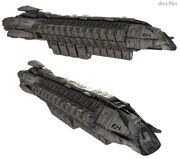
A Common Freighter, docks in the Space Port
The SSF Class Freighters are large cargo ships that are designed for travel between planetary bodies, it is lightly armed with Spike Missles in the event of a pirate raid, the ships were launched in the year 2948 over Savoy. There are currently 45 Freighters in service, making routine voyages to Elizabeth, Imperial Union of Gaia, Kebir Blue and back to the stationary space port of Brandenburg or to the Union Colonial Space port in Mount Irvin. The Freighters are heavy but very fast, the Freighters carry food, materials and commdities to the newly established Union Colony in Mount Irvin.
Passenger Liners
Pending
Aquitanischen Reichsheer
The back bone of the Aquitanian Army, even though it is considered by the people as the normal and standard troops in the country, it is one of the most advanced armies, among the best in the world.
Every person in the army receives training for every Army branch, and so the government can easily drag soldiers to any branch (from any branch) that needs it whenever it is necessary.
The Landheer is renowned and loved in Aquitania for the grand processions it participates in, the uniforms of the soldiers are held in protocol and is exquisitely decorated even in battle.
The Aquitanian Landheer is usually formed by immigrants and foreign people that want to fight to win honor and citizenship in the country, training is harder and more strict for foreign conscripts.
Aquitanischen Kaiserliche Marine
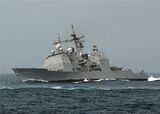
RWS Warlock
The Federal Navy is the most important branch in the Aquitanian Armed Forces, it serves the coastal territories of the Kingdom and in times of old served the overseas State of Aquitania in the UKO.
The Navy works in cooperation with the Royal Landheer and Luftwaffe forces of Aquitania, as it is a successful delivery system for invasions in far countries. "The Landheer is a projectile to be fired by the Bundesmarine-Korps" - Anton von Vidlostee - General-Marshall of the Royal Armed Forces (2940).
The navy is also in charge of extra-planetary actions, like the controling of the ICP System and Orbital Bombardment Stations and any warship that will operate in space in the future, like the MSS Preussen and the MSS Revenant.
The Branch is responsable for most breakthorughs in Aquitanian Military Development and Research or the AMDR. It researches, tests and approves armament, weapons, systems and other assets.
The coordinator of technological research was passed in the year 2945 to ONI, (Office of National Intelligence).
Luftwaffe

Highland Class Helicopter
The Airforce is the so called deadliest force in Aquitania, it is the second most extensive defense network in the country after the SDI Units.

Prussian Comanche Class Helicopter
It is highly advanced thanks to the MDR Intelligence Offices, it holds the deadliest equipment in Aquitania after the System of Orbital Bombardment and Defense Infrastructure (SOBDI). (Lovingly called by the army as "Soby the Eye").

Stratew Class Bomber
The Royal Luftwaffe has operated in both Naval and Land missions. In the event of national emergency, the Luftwaffe is mandated to evacuate civilians to the country side or safe areas after the emergency has been declared.
It has a relatively advanced bomber which, with the benefits of stealth, can carry 70 high potency bombs and an additional crew and soldier capacity of 100, it is the state of the ark bomber in Prussia and much of the world. Along with the odd looking aircraft, the Prussian Luftwaffe is identified for being fast and for its trademark word of the casual expression "Haulen" which means fast action in old Aquitanian.
The famous Skytaxis of Savoy were first intended to be small skirmisher air units, but they were decomissioned for their small firepower. Although, the hovering units proved highly maneuverable and lightweight, with the advantage of low fuel consumption. In the 2970's they were donated to the City of Savoy, this enabled faster transit in the metropolis' super skyscrapers. By the year 2947, all skytaxis were adapted to Plasma Particle Fuel and so their popularity rose as their costs plummeted. A trip from the coastal Savoy Hotel Zone to the Eastern Country Side costs a meagre 50 Krints.
Elitetruppen
The Elite troops or Aquitania are trained to defend civilians at all costs, the Elite are not allowed to give importance to civilian elites in time of greater emergency. In the event of an invasion, Elitetruppen cooperate with the Luftwaffe and evacuate civilians to the gigantic bunker and tunneling systems of the Central and Northern Highlands or abroad.
The Elitetruppen are funded by the AHDA and by ONI, along with hefty donations from the general populace, the Branch has proven the most important when used as a defensive unit. After all evacuation protocols have been accomplished, the units assist the army against invaders.
Federal Advisory Warnings - News
| Federal Ministry of Safety | ||
|---|---|---|
 Bundes Warnsystem Map 3146 |
||
| Year 3146-Present |
Koenigsberger October 28, 3139 | At exactly 10:45am, in the middle of a Bundesversammlung session between Members of the Federal Congress and Federal Senate, a 7 Ton Supporting Beam of the destroyed Luftheiss Terminal in Brandenburg Spaceport broke through the white roof of the Great Building. There were no casualties. As Federal Officials evacuated the building, pictures of the Supporter Beam were taken. Holding an Ad promoting travel to the Imperial Union of Gaia, the beam was being lifted through the very hole it crushed through into the Assembly later that day, pictures featured on digital newspapers of the Capital's flagship News Anchor "Der Koenigsberger".
Federal Advisory November 18th, 3138 | All population centres in the Federal State of Savoy, Northern Prussia including Brandenburg are under a General Warning. A deadly debris field from the Brandenburg Spaceport Explosion floats in space approximately 35,700km above the warned regions.
Civilians Should Expect Civil Defence Alarms Highway Alarms Town Marshall Warnings What Civilians Should Do Head to a Civil Defence Shelter Build or Head to a Basement if in the Country
ARCHIVED
December 1st, 3052 Savoyard Bay Earthquake and Tsunami At 7:08am Western Aquitanian Time, a magnitude 8.03 Earthquake was detected on Savoyard Buoys exactly 30 seconds before it got to shore. Evacuation of Savoyard Superskyscrapers was slow and thousands failed to evacuate, resulting in the deaths of an estimated 35,000 people from the fall of 7 of these tall superstructures. Advisory AI Warnings from the City's superintendent were estimated to have saved 70,000 people. At 7:32am, a tsunami struck the coastal cities and towns; Savoy, Wurdennberg, Tirraneue, Dassbraun and Albrechten. Which were successfully evacuated minutes prior to landfall by each city's respective Superintendent and Authorities. The disaster took an estimated 55,000 lives.
Federal Advisory December 1st, 3052 | Civilians are advised to stay away from the Western Coastal Highway, which has several sections of it collapsed. People inside Savoy are advised to seek the Evacuation and Refugee Zones. Central Savoy is gridlocked and people are recommended to avoid it, those there are recommended to evacuate to Lowrise Savoyard Districts, as risk of more skyscrapers built before 2920 collapsing is present and real. Civilians are advised not to travel to Savoy and avoid all Highways heading into it, especially the Savoy-Königsberg section, as it is being used by emergency services as Savoy's is overwhelmed, if impossible, always yield to emergency vehicles as is protocol. Furthermore, all civilians are to avoid getting on an Elevated Highway. AussenPol Advisory On November 20th, 3056, Foreign Intelligence of East Heaven discovered the existence of a terrorist group calling themselves the "Our Country's Party". Based in East Heaven, this nationalistic, xenophobic group target Foreigners and are angry at the marriage of late Wilhelm III and High König Maya Elisabeth I, all Aquitaines in East Heaven and the Embassy are considered at risk. Travel Advisories recommend travelling to the Embassy if the civilian suspects someone following or have been recently threatened. Travel to East Heaven is at one's own risk.Königsberger Zeit Königsberg is under Martial Law after the recent June 3058 coup, the new leader of the nation is Fuller, which charges of conspiracy were lifted after lack of evidenceDie Weltzeit - On May 3098, The discovery of infiltration devices and classified Aquitanian archives in the Ardglassian Embassy in Savoy has lead to the arrest and execution of all Ardglassian diplomats, including former Ardglassian Ambassador on charges of espionage and High Treason.
- 2 Heavy Particle Accelerator Cannons - The H-Pac, derived from the weaponry systems of the Aquitanian OBU Systems, the cannons are the most powerful weapon on the cruisers, having the ability of firing super heated accelerated particles that can breach the thick armors and the shielding systems of other Aquitanian ships with one shot. The shot can penetrate another ship from bow to stern, with or without additional energy shielding, the crew and ONI call it the "Clean Shot". The weapon has proven itself extremely accurate, due to the energy released the array can go on endlessly through space until impacting an object. Similar systems will be used to set up communications.
- Heavy Particle Torpedoes - Using the Aquitanian technological breakthough that features plasma, or superheated ionized gas, the torpedoes are super heated particle concentration that can deal shield melting damage and explodes after impact, dealing even more damage.
- Impact Lead Packages - The weapon automatically localizes any weak point or opening in an enemy ship and fires, the impact creates widespread damage in rival hangars or escape pod openings, the Anti-matter bomb or "Package", blows 5 seconds after impact, disabling large ships and completely destroying lesser ships.
- Particle Accelerated Anti-Fighter Turrets - The turrets track and destroy enemy fighters, transports or incoming small boarding vessels. The turrets use EMP Shock Lasers, Plasma Lasers and ballistic ammo, as well as Short Particle Accelerators, which takes 2 minutes to charge after one shot.
- Heavy Spike Missles - Missles capable of destroying a ship with its shields down (for Aquitanian Ships) or unsufficient plate armor, the missles are fired in large quantities and are useful for middle sized ships.
- Laser Point Systems - The lasers track incoming missles and fire their accelerated particle arrays, which melt the missles or torpedoes.
- Jamming System - The Jamming System onboard the CSC-Supercruisers act in a radius of 2 miles around the ship, any enemy ship that enteres that radius will have problems guiding their missles and torpedoes to specific targets during the battle.
- Heavy Deviator Beams - The beams give a punch of concentrated kinetic energy to incoming missles of lasers themselves, the beams absorb the energy of enemy lasers and deviate or blow missles before they can get close to the ship.
- 1 Heavy Particle Accelerator Cannon
- Particle Torpedoes
- Particle Accelerated Anti-Fighter Turrets
- Deviator Beams
- Spike Missles
- Laser Point Systems








































